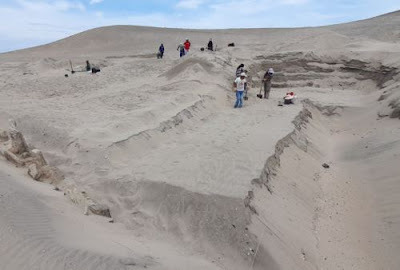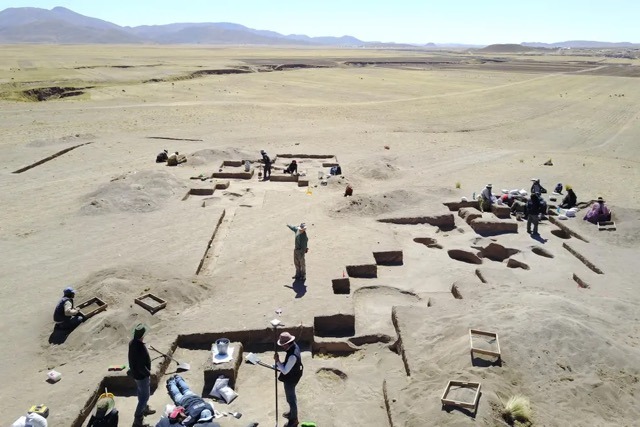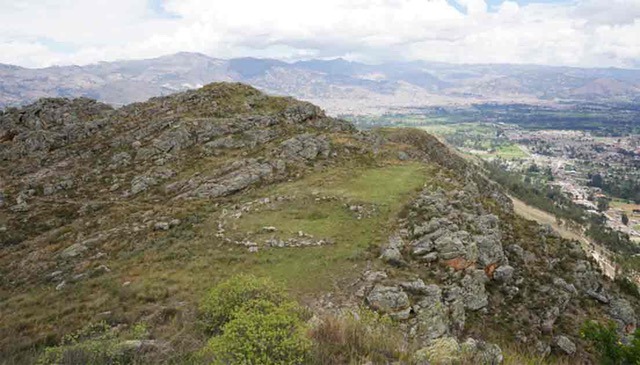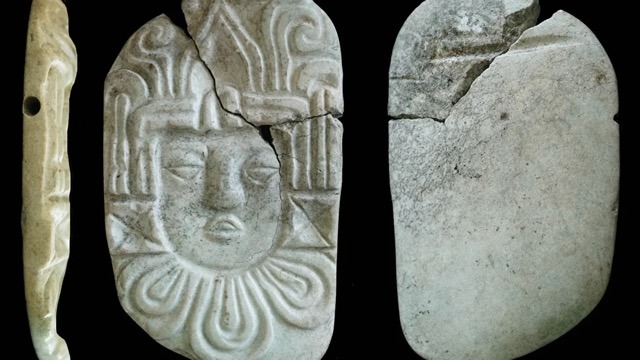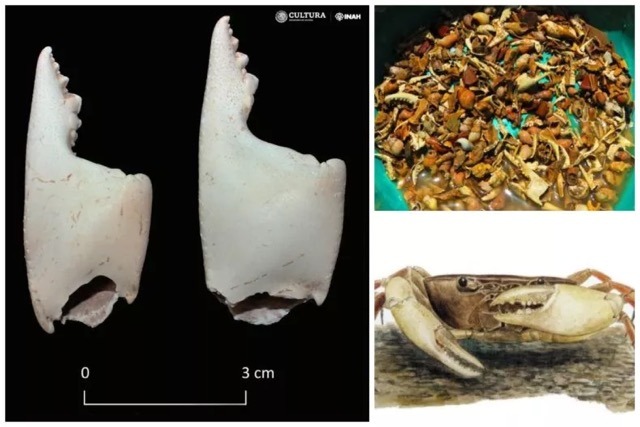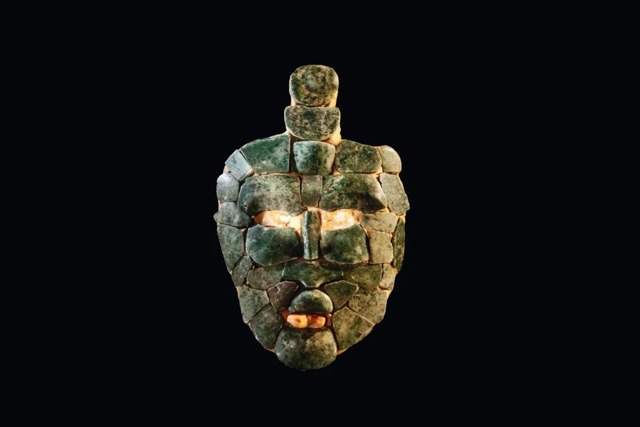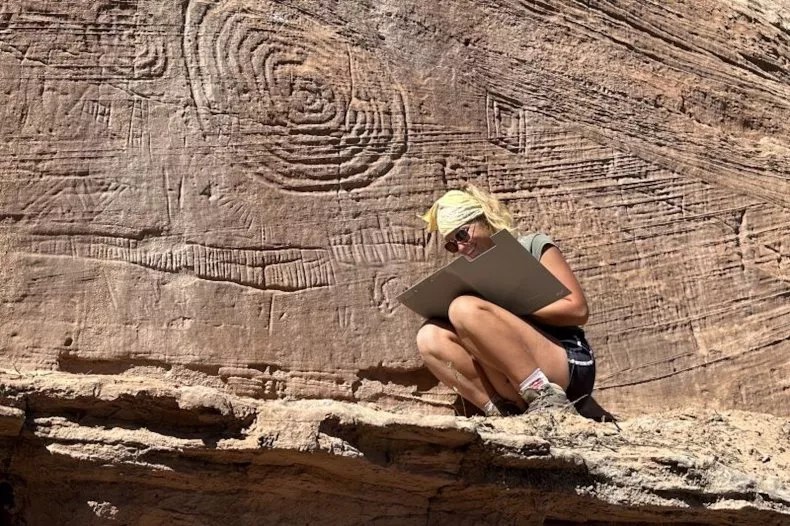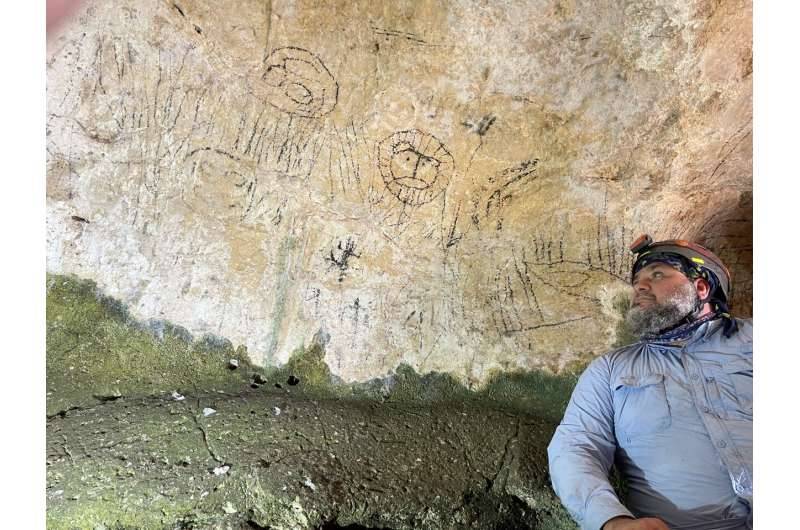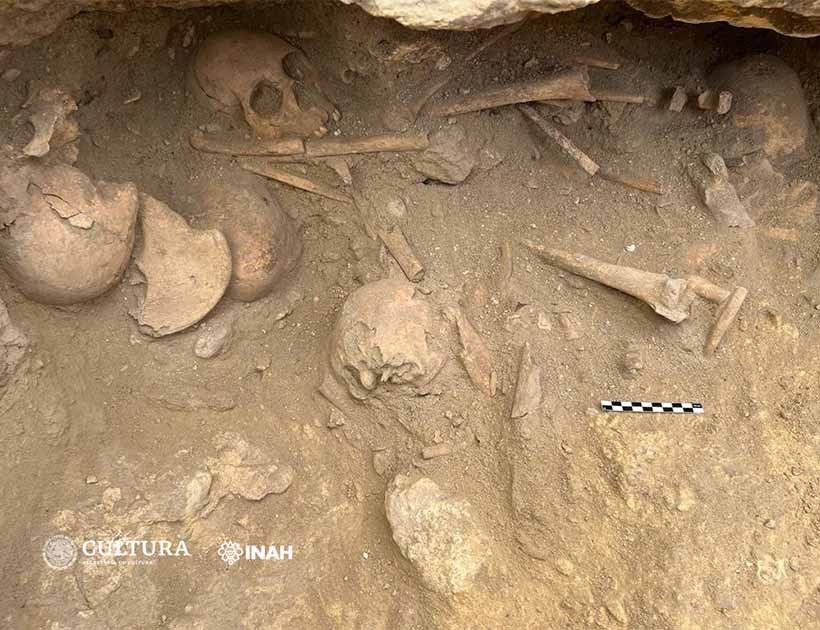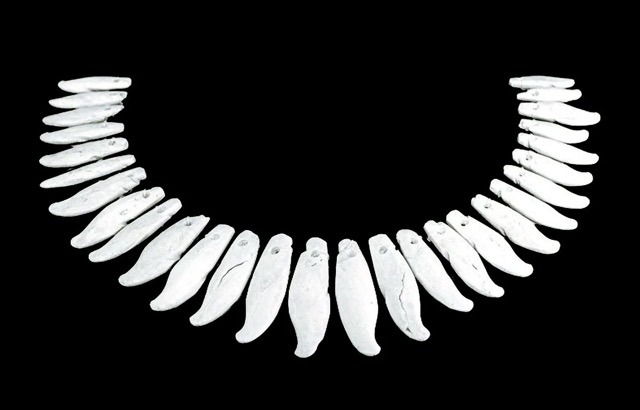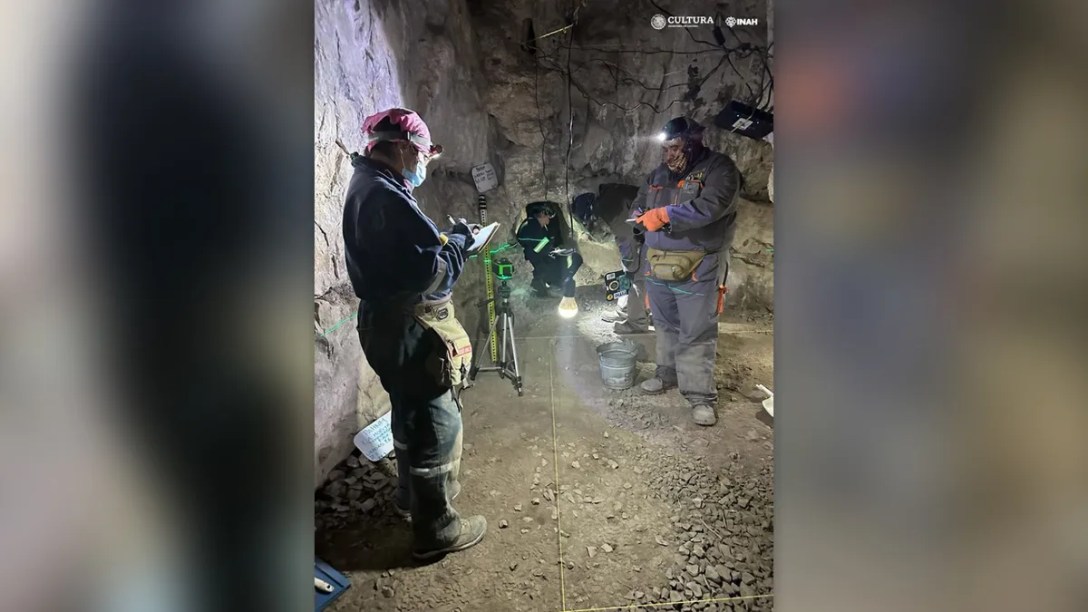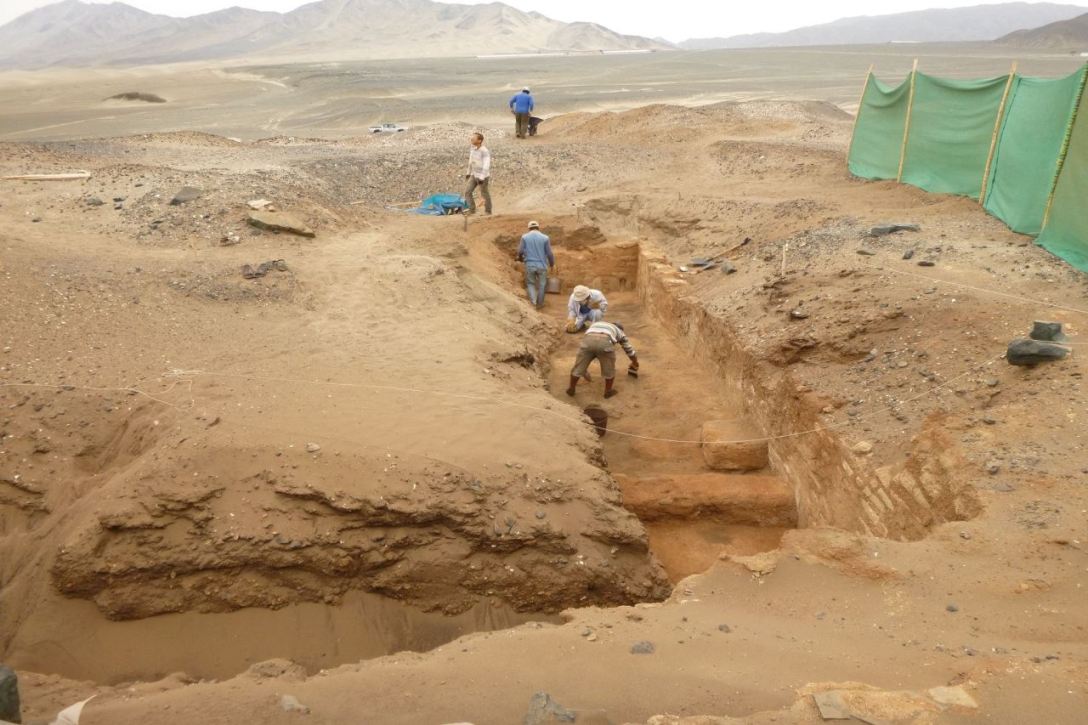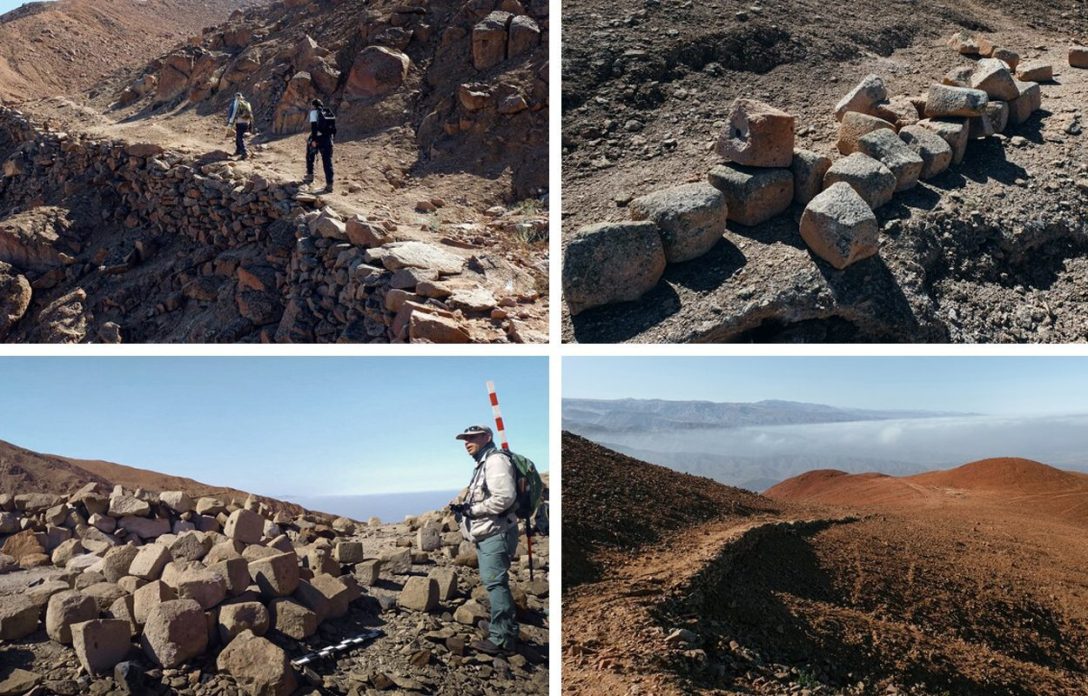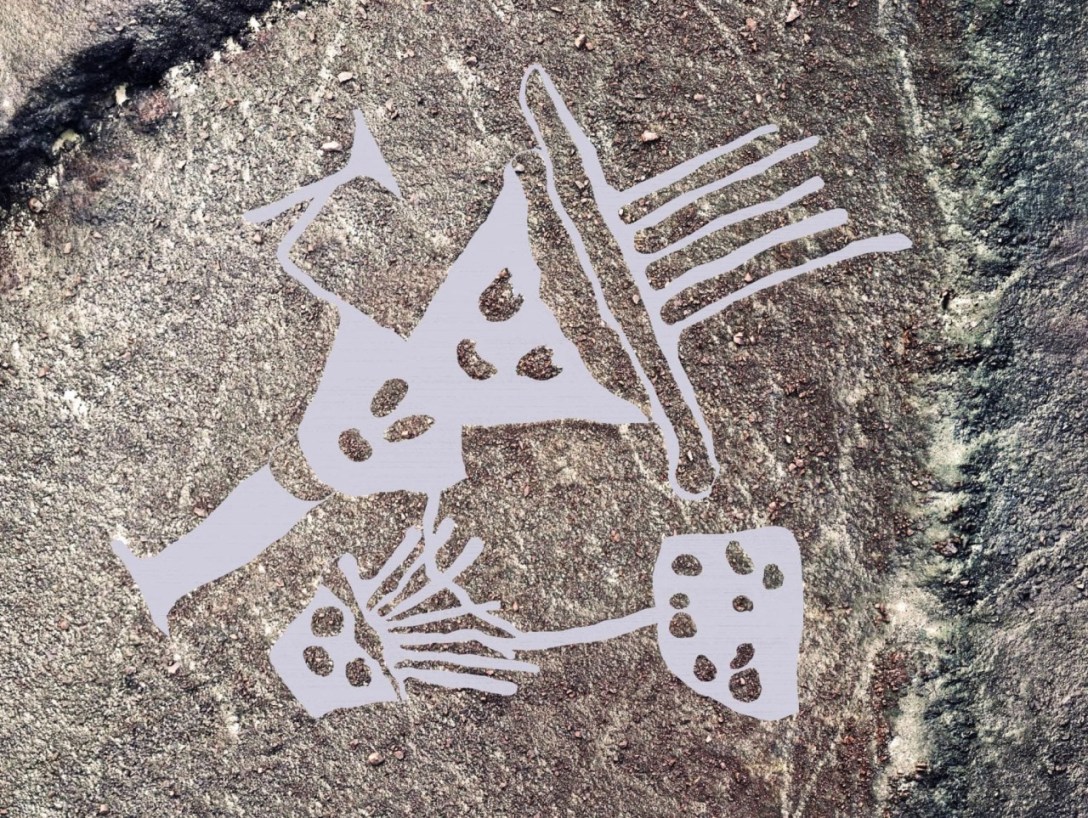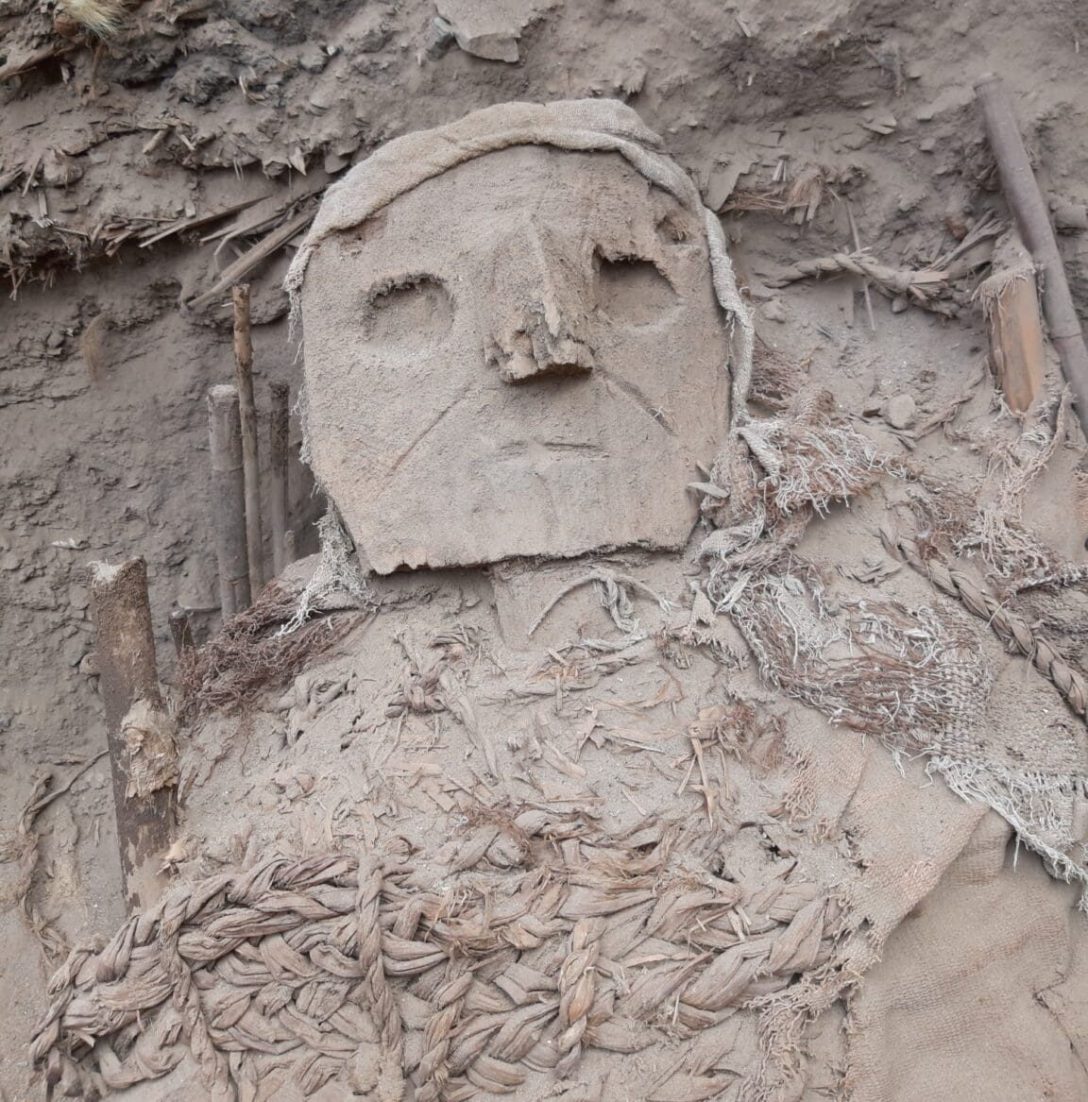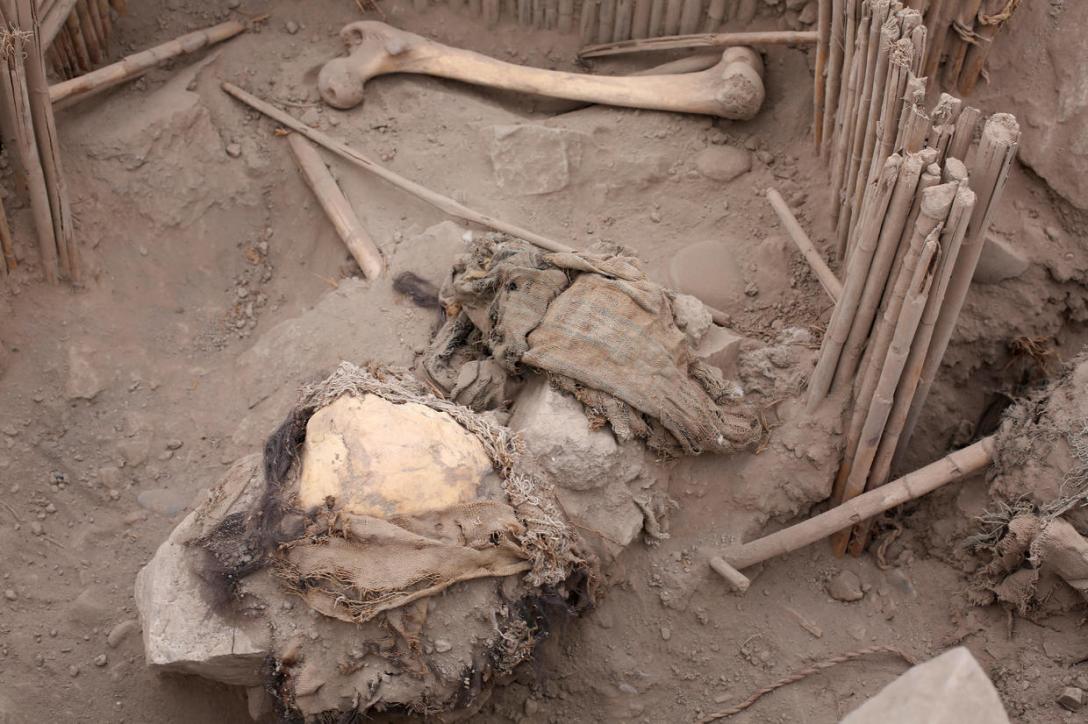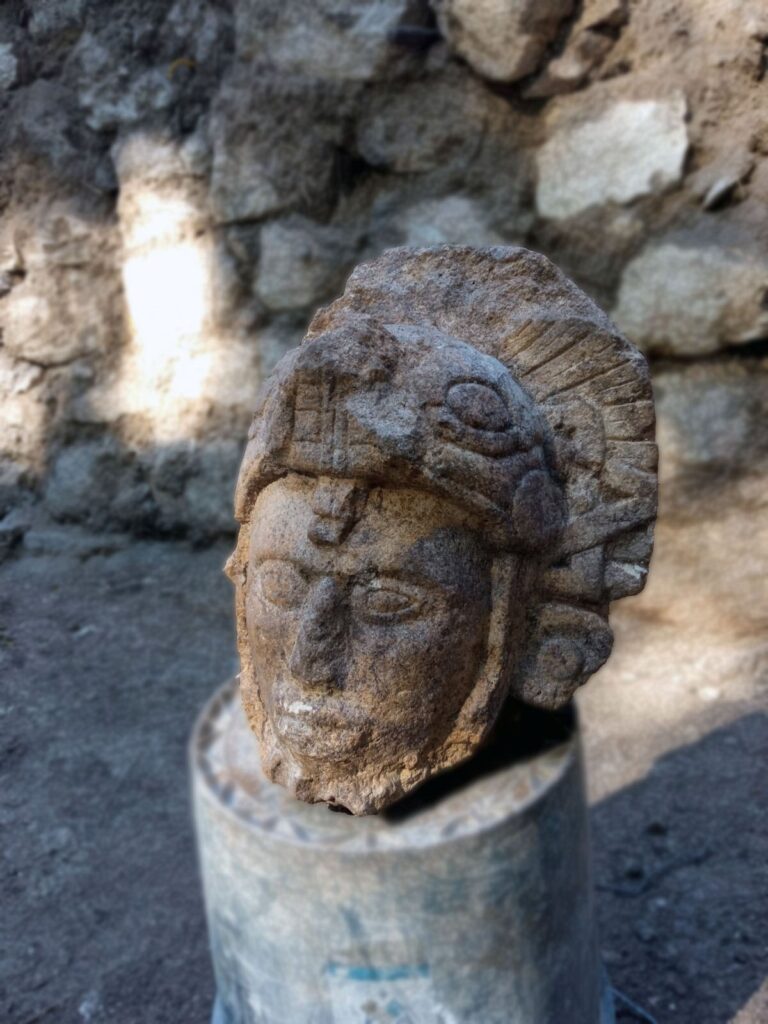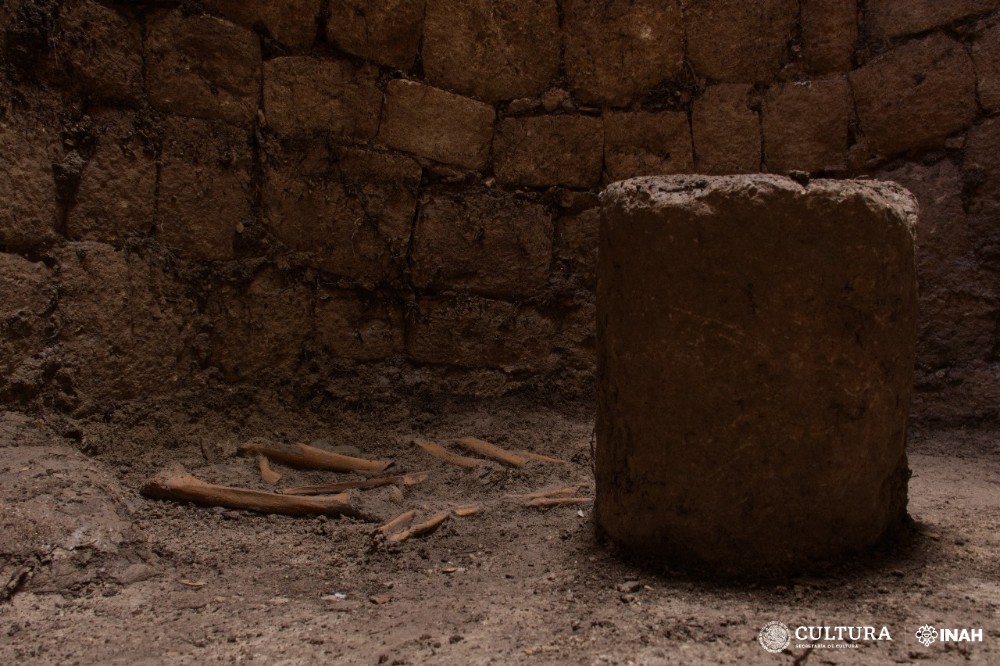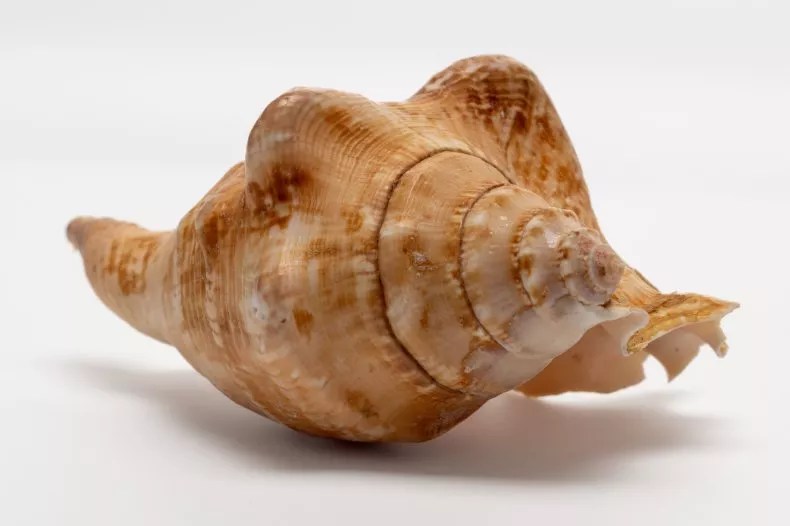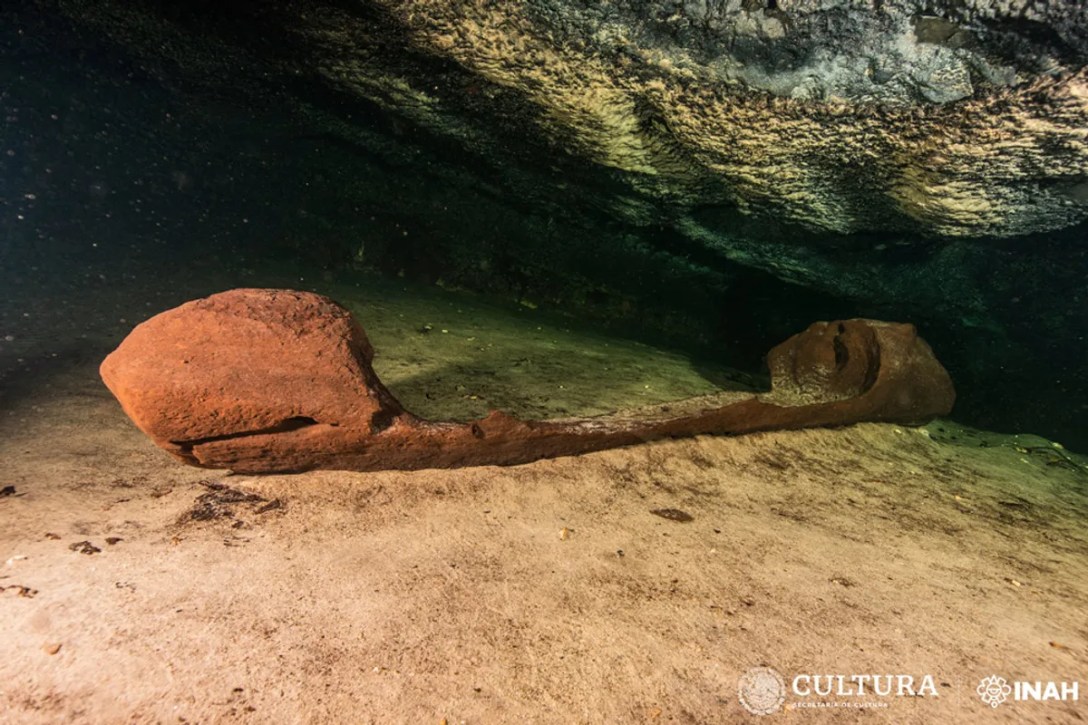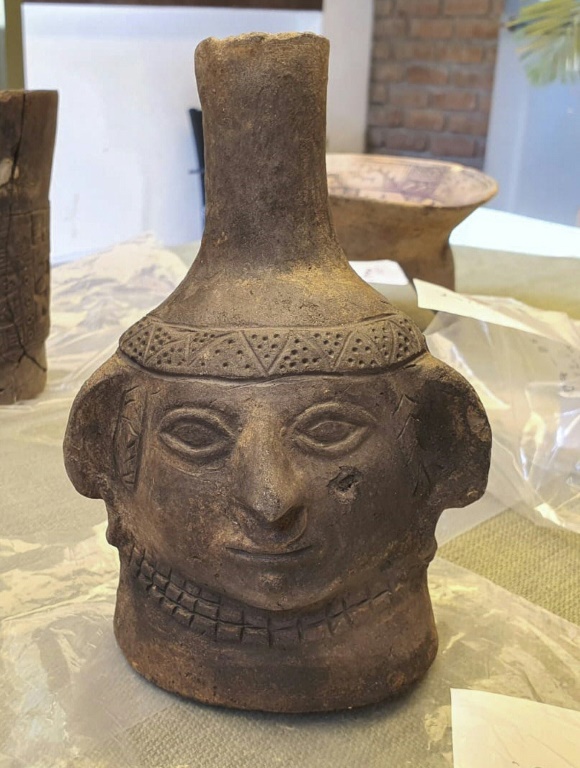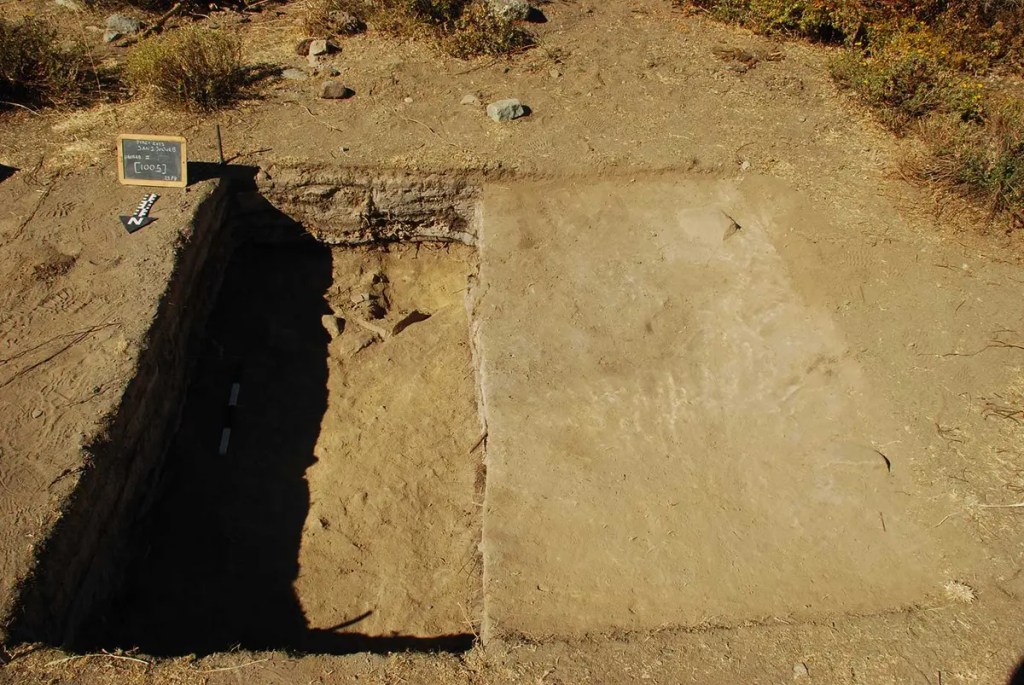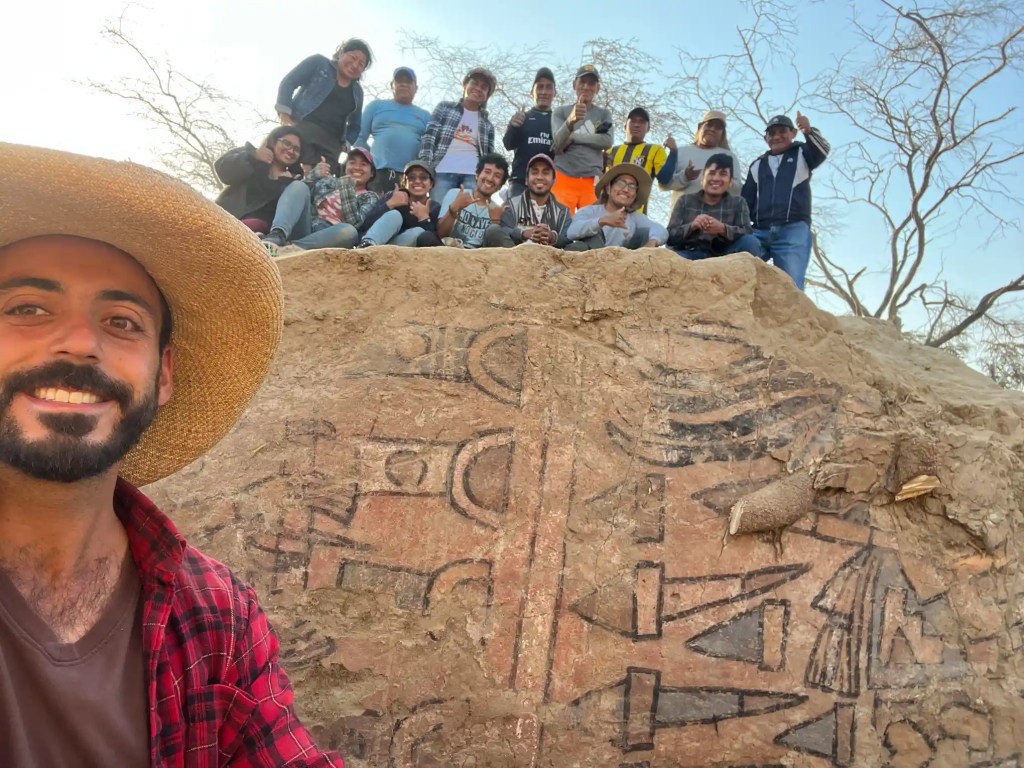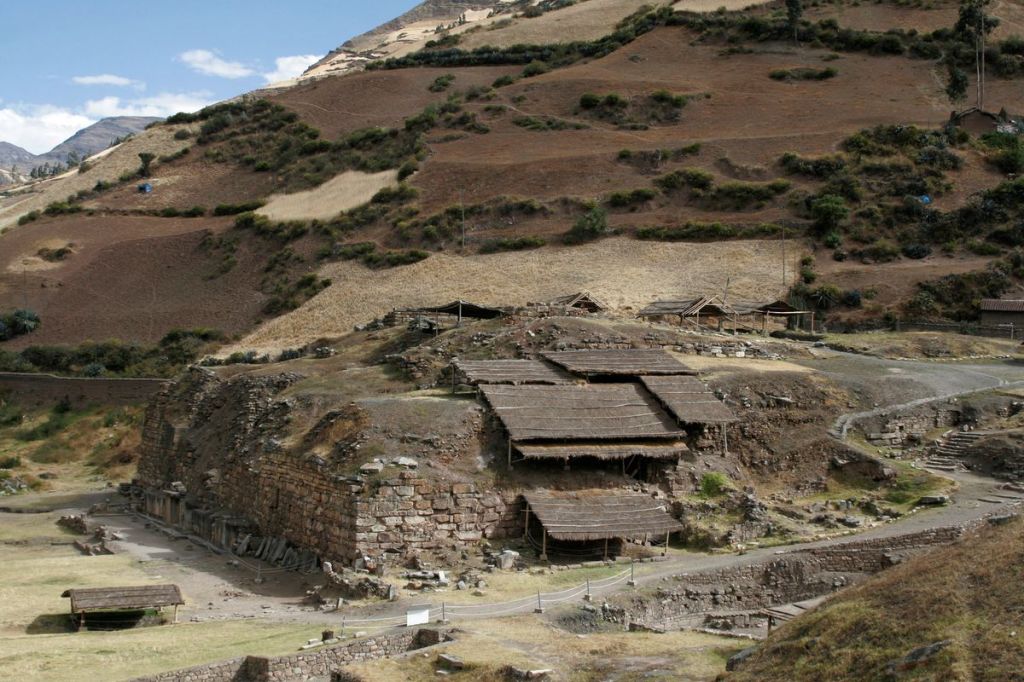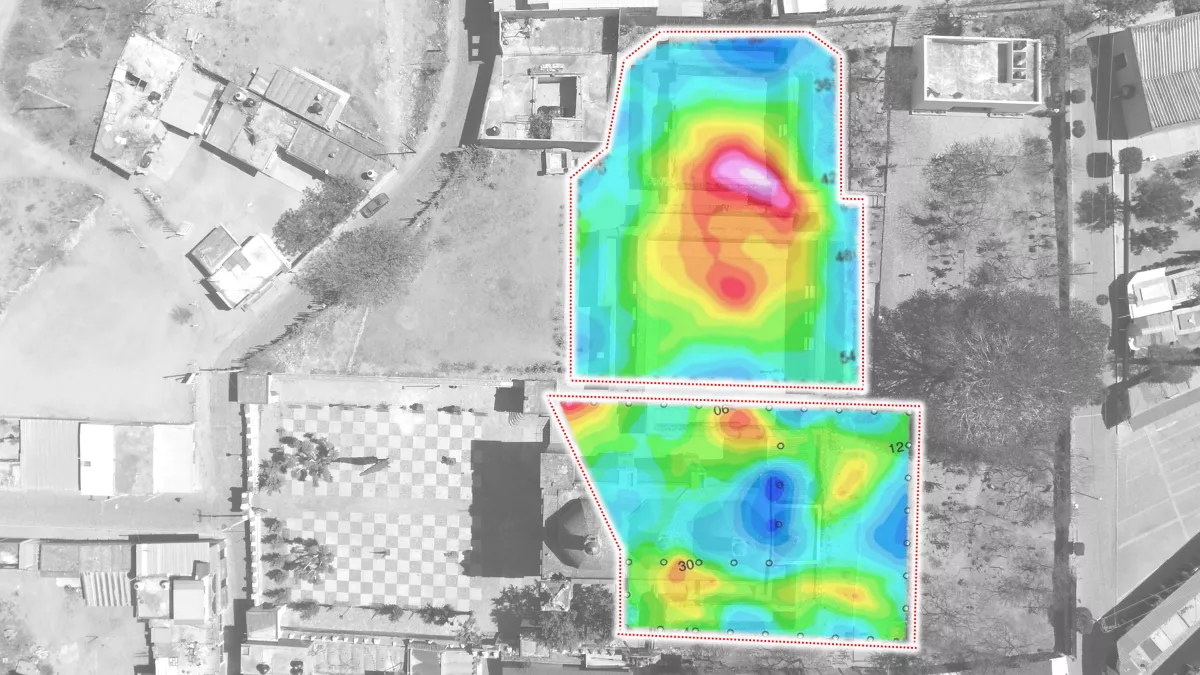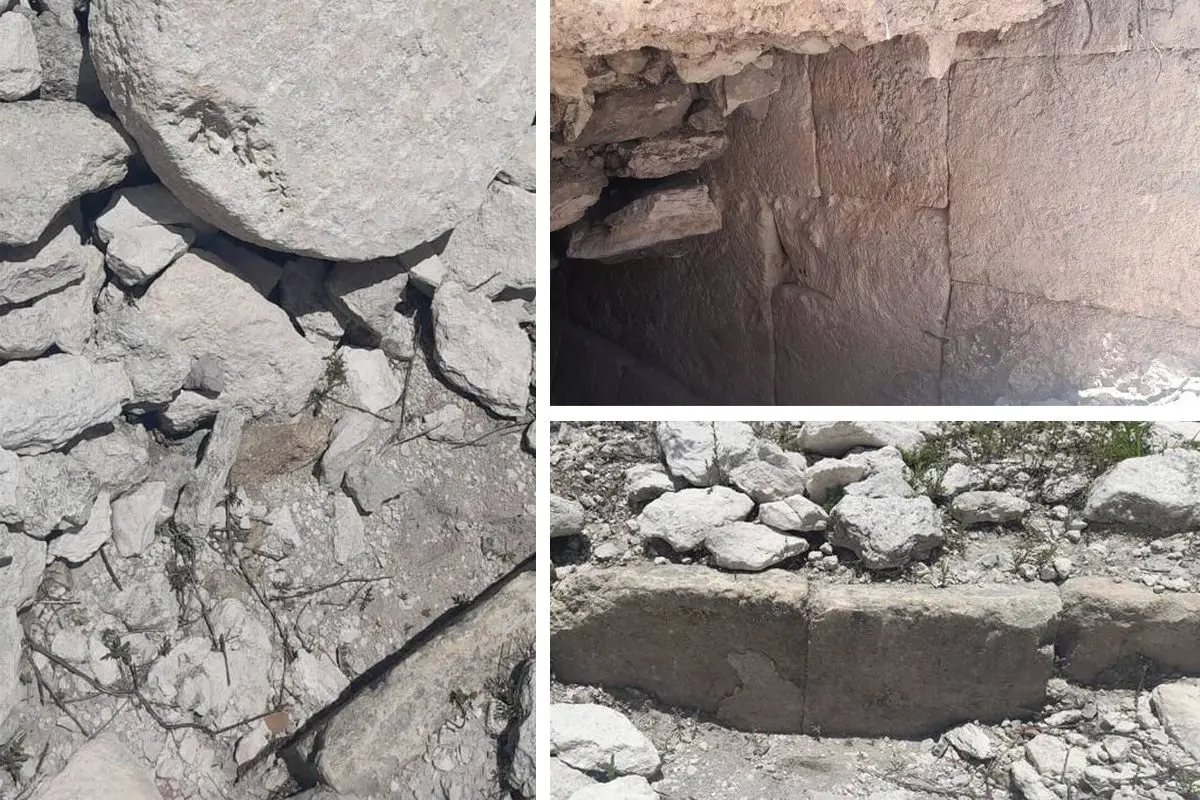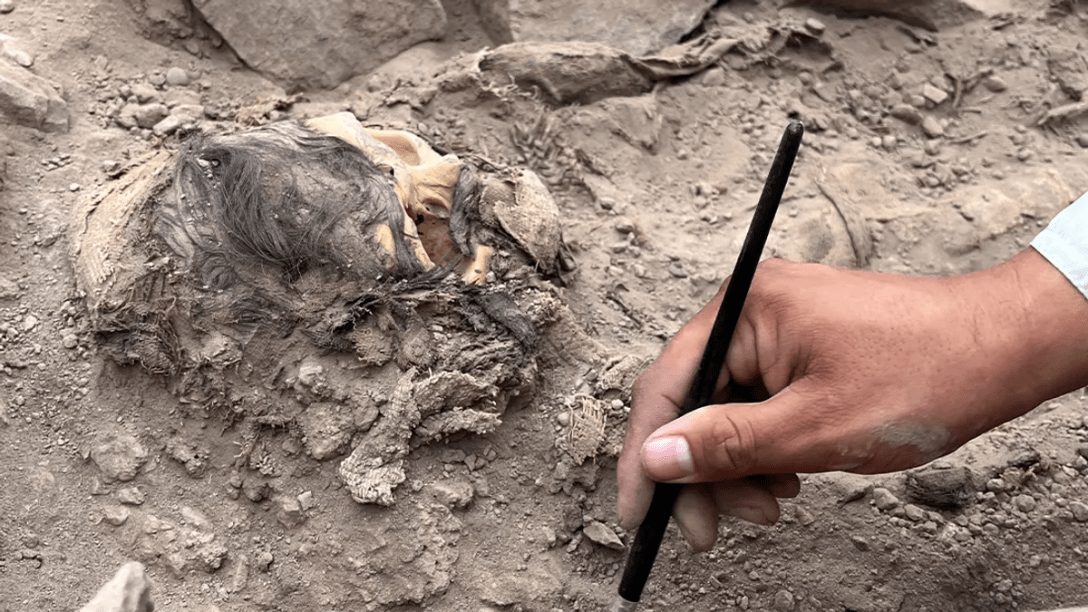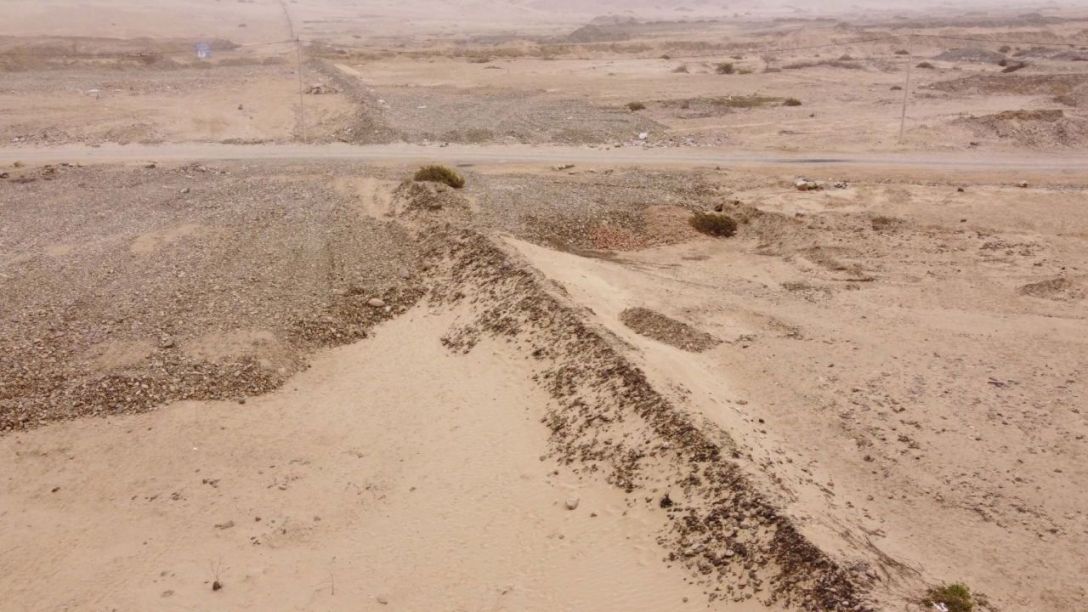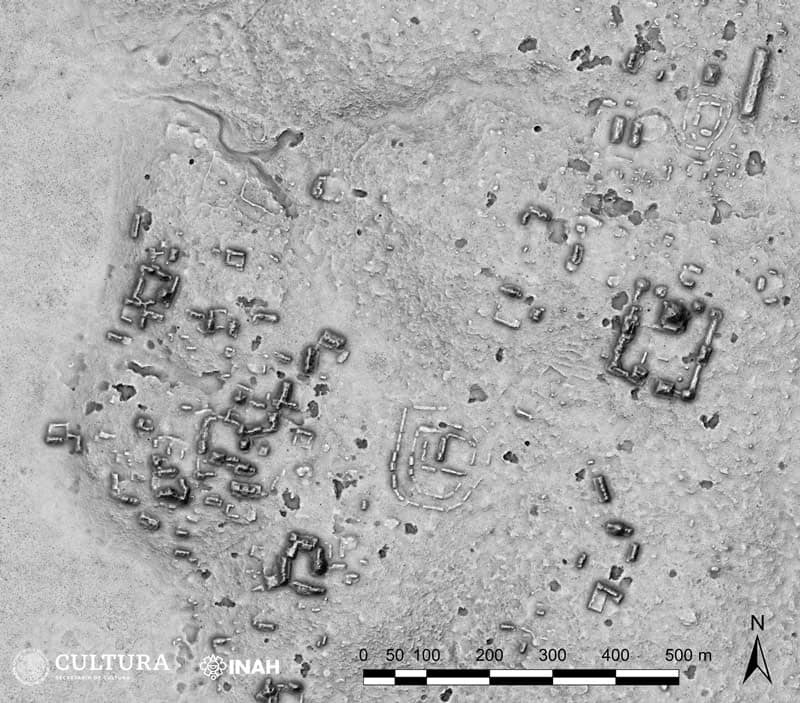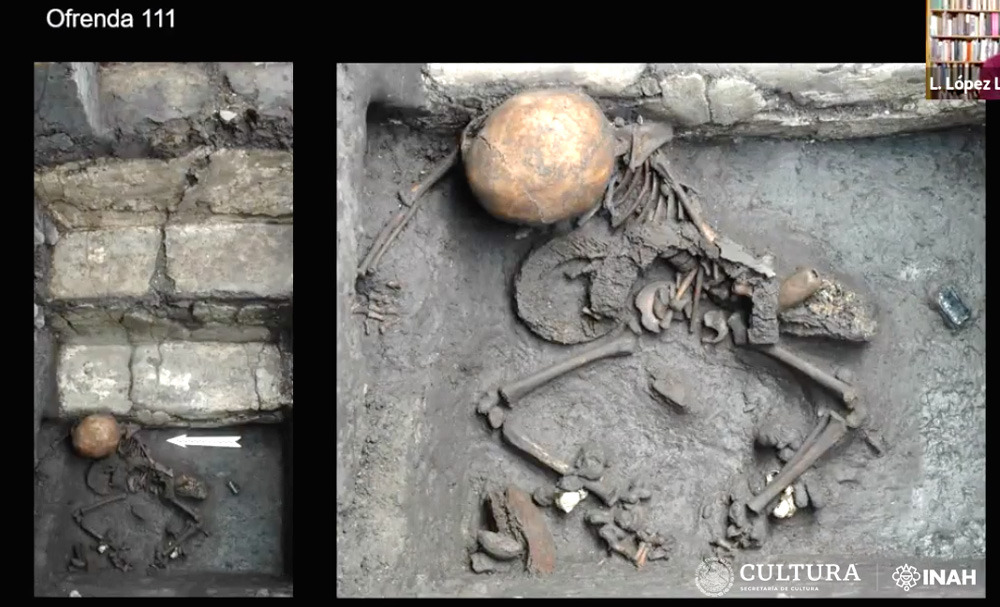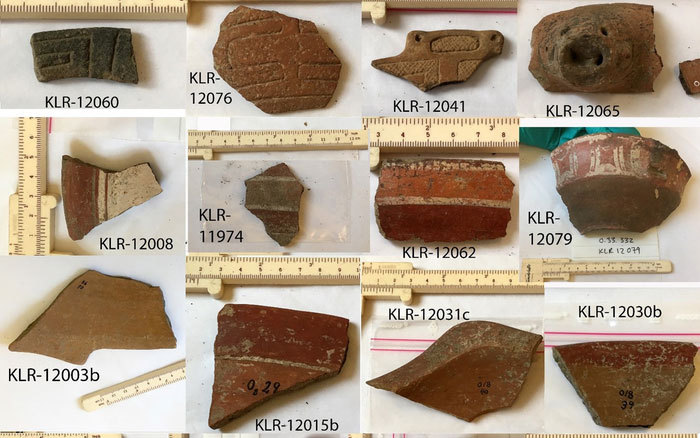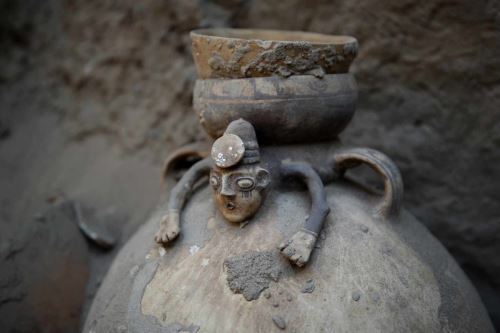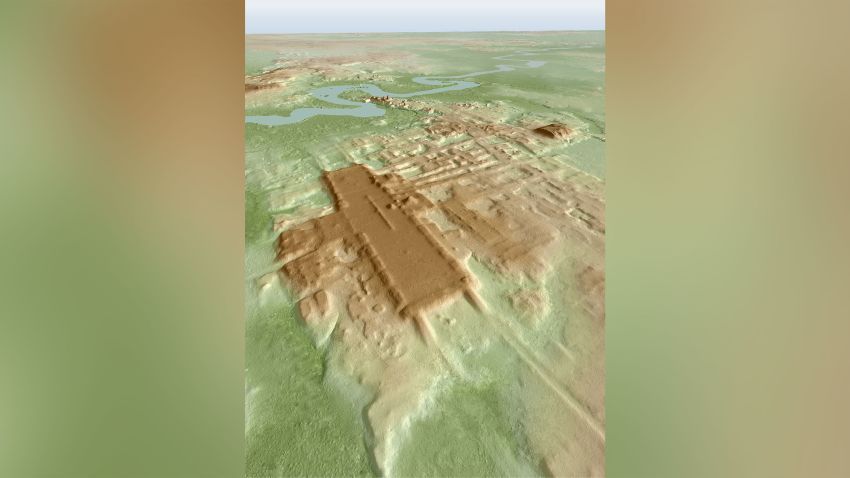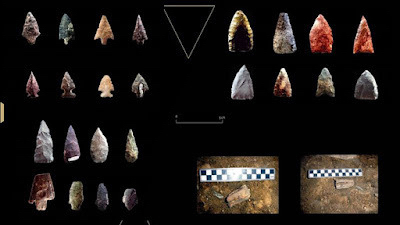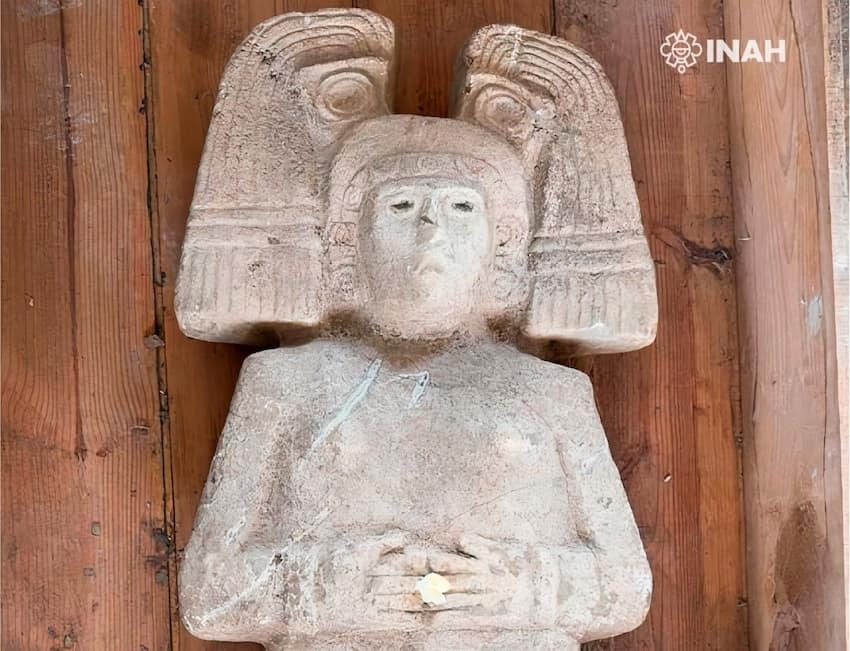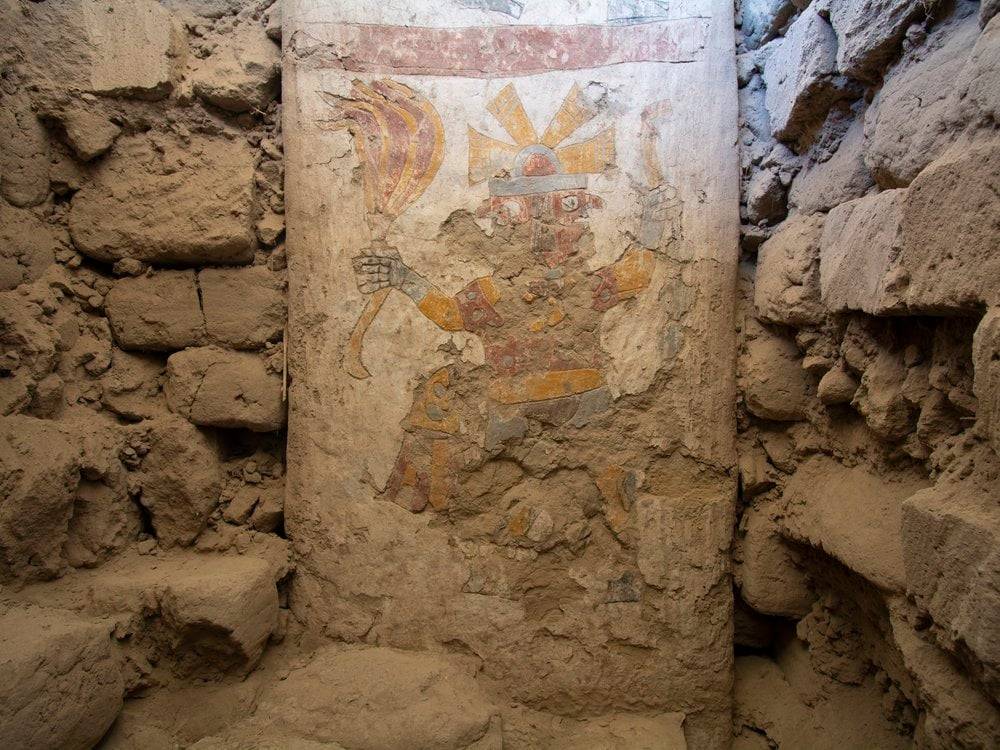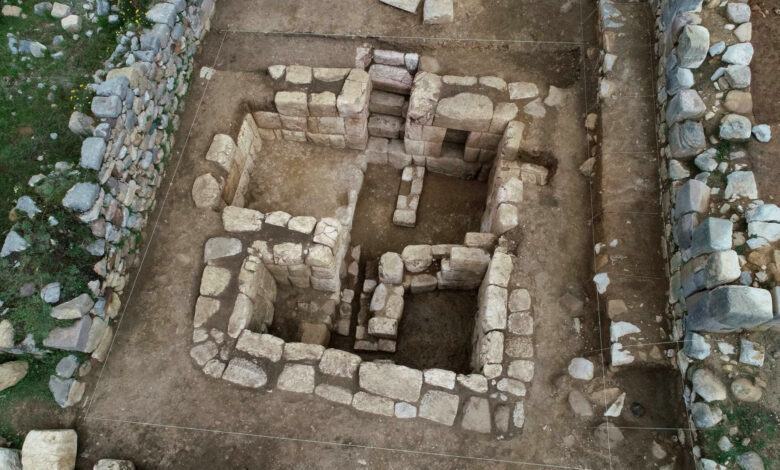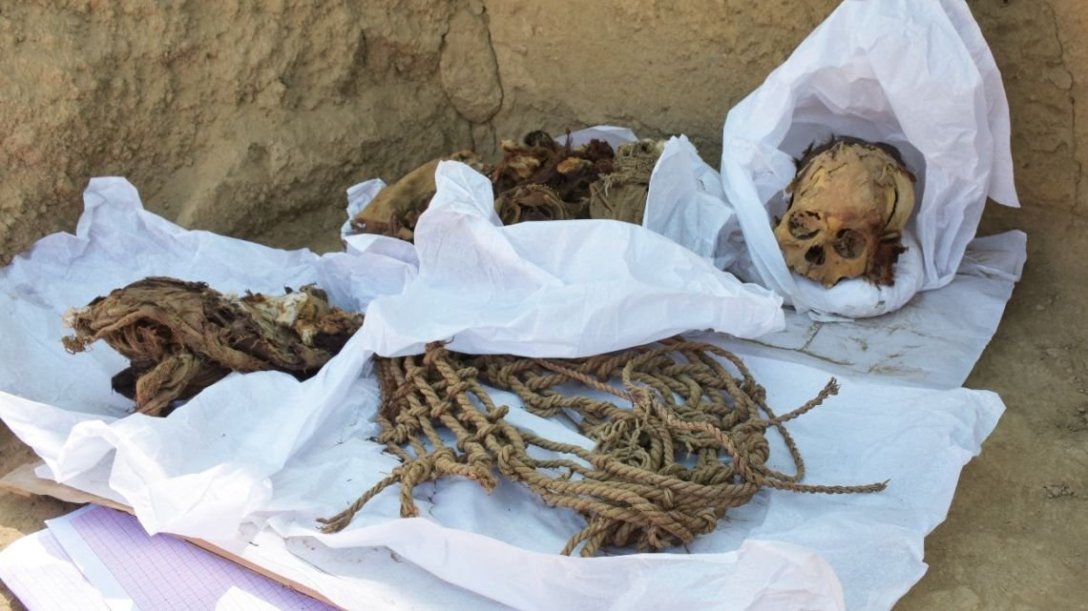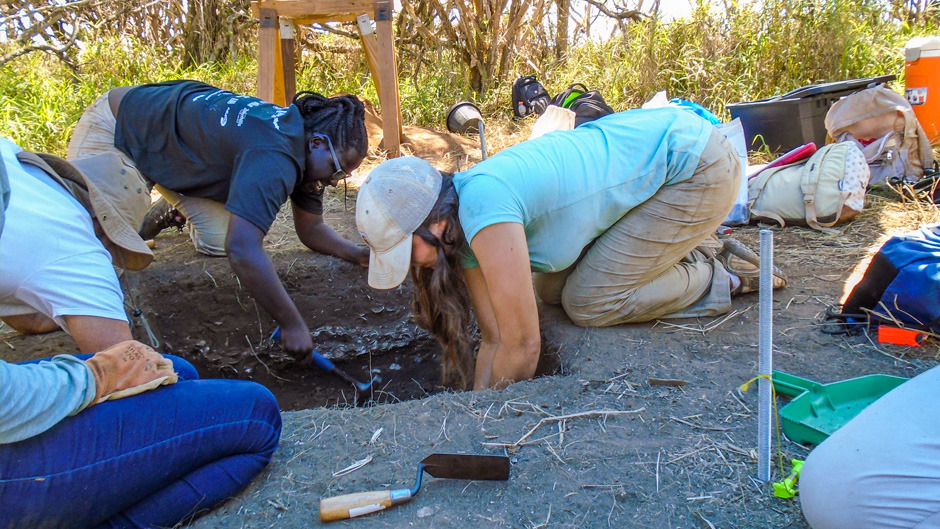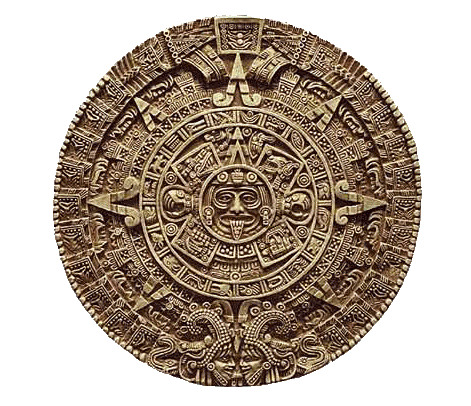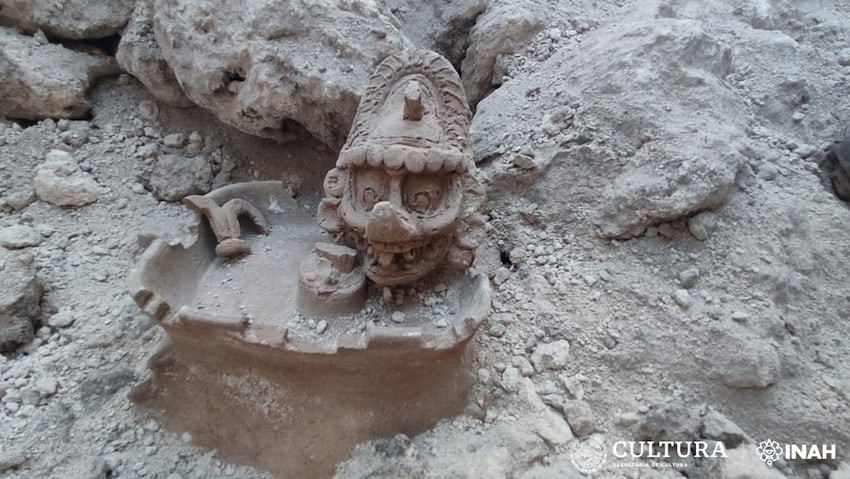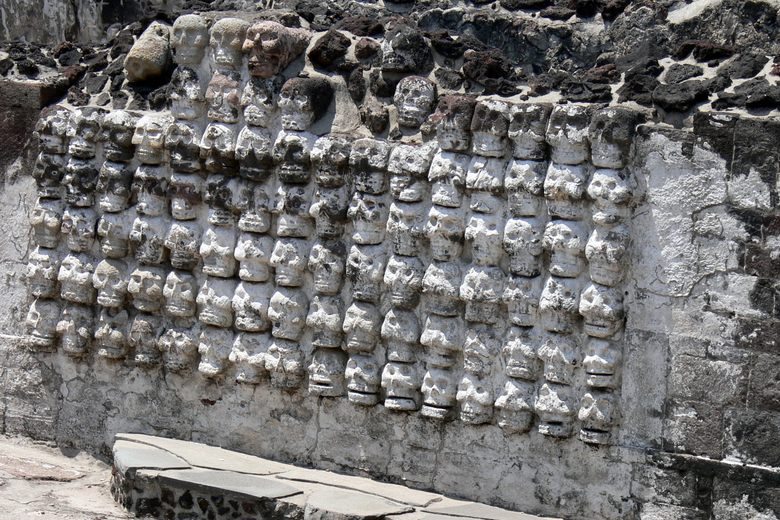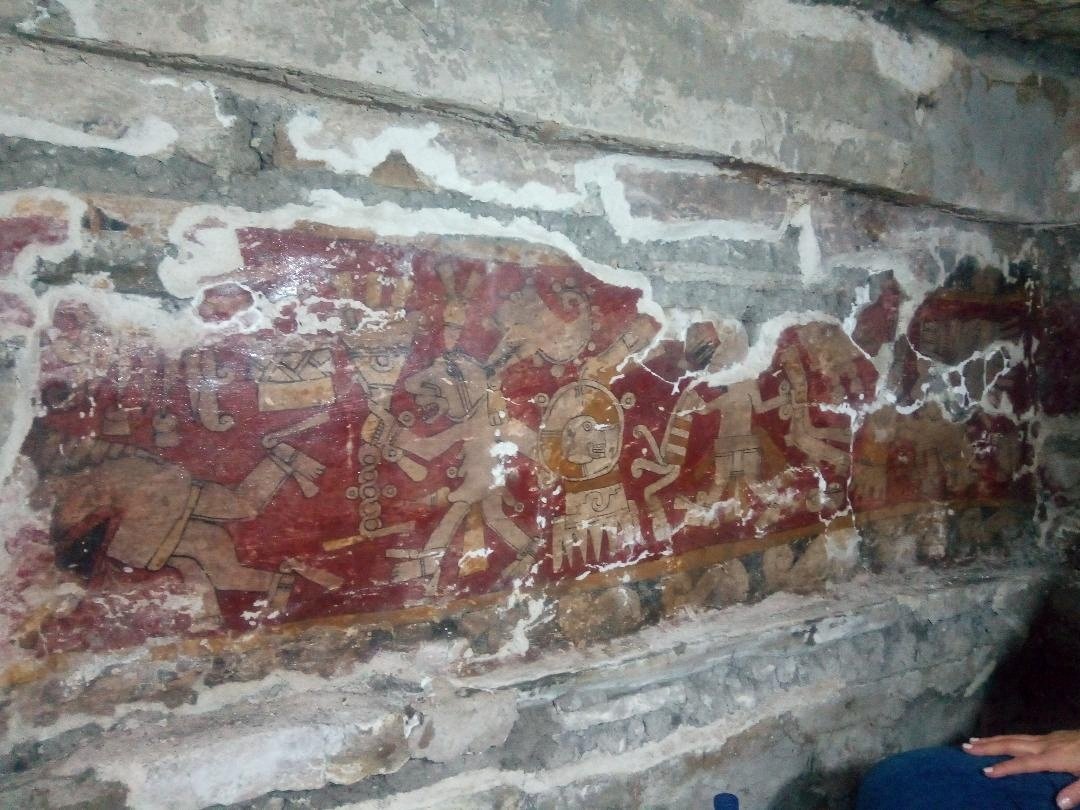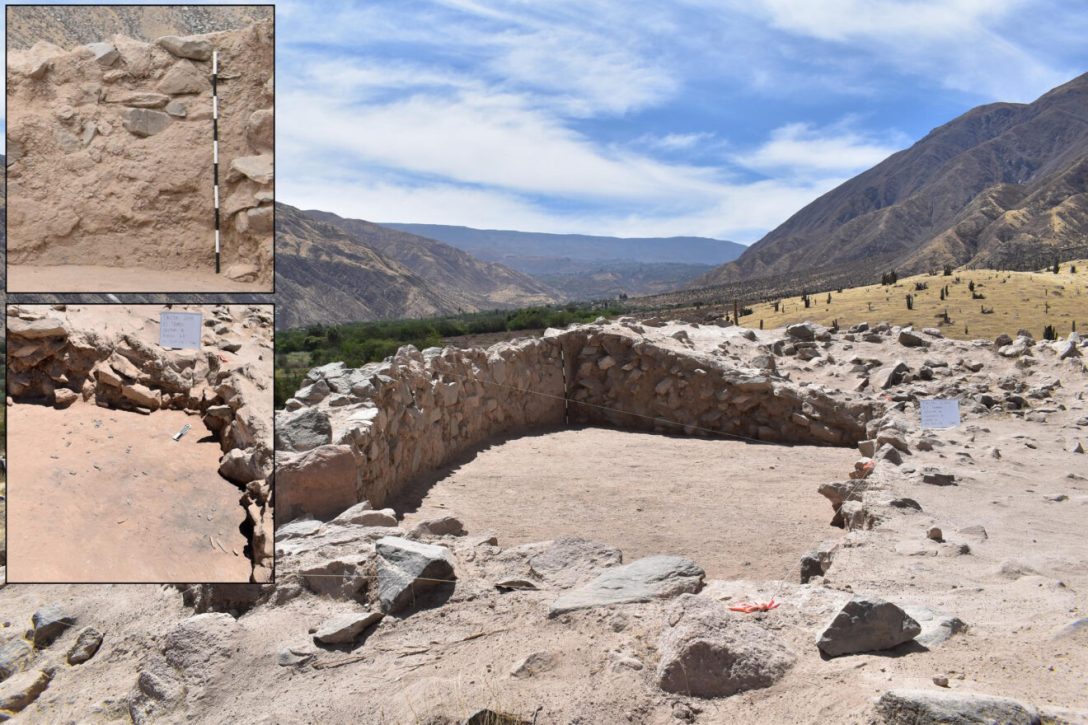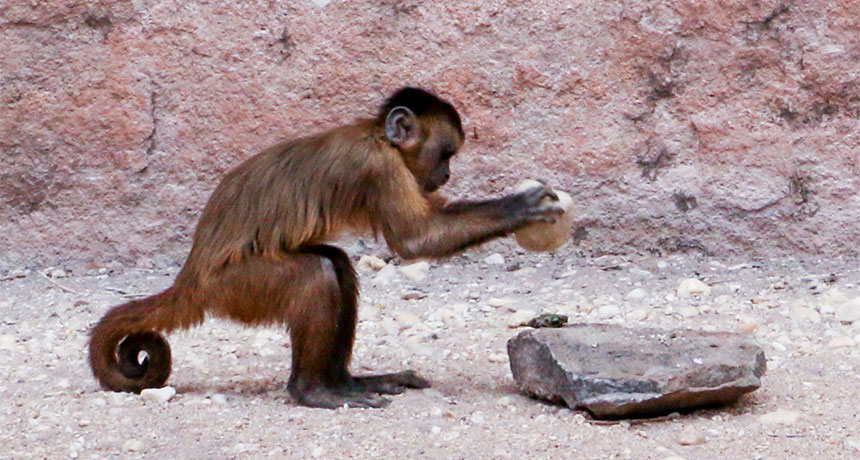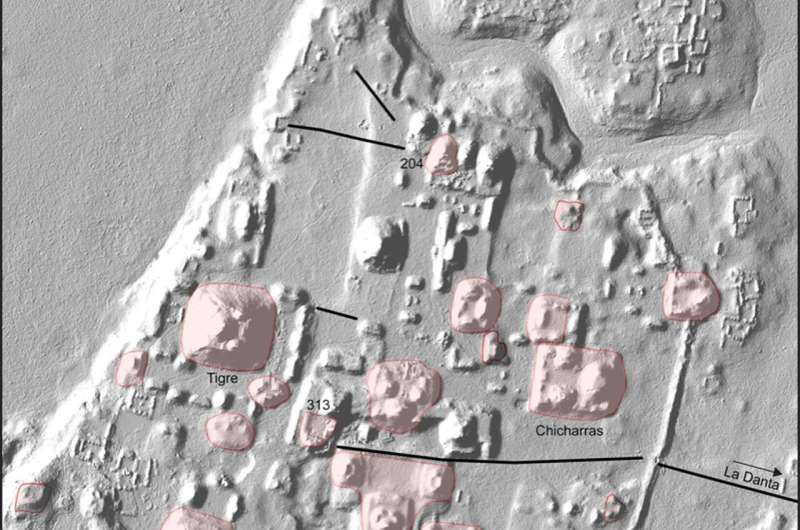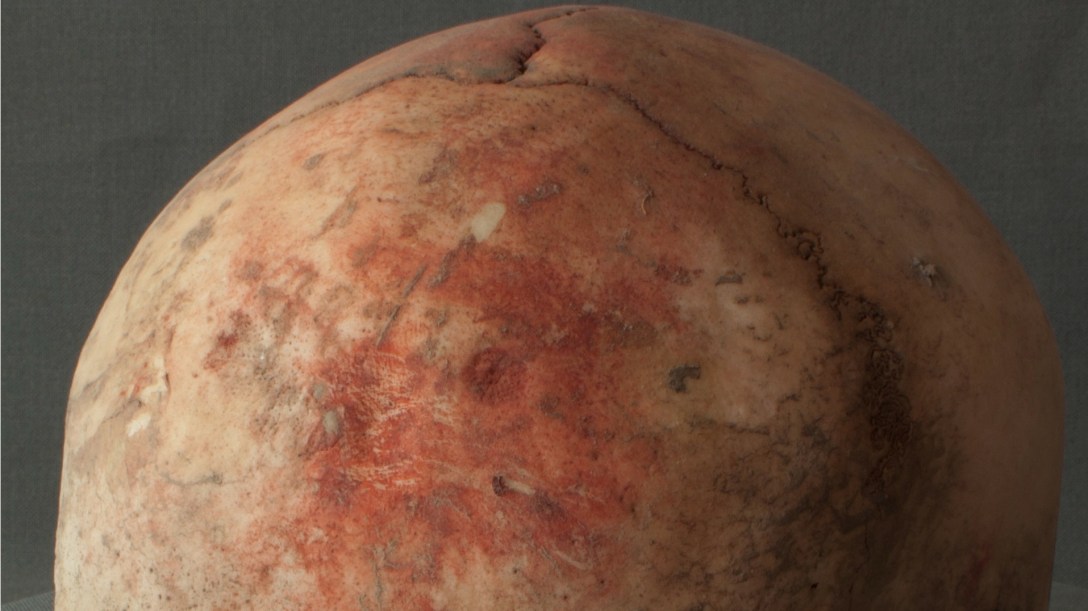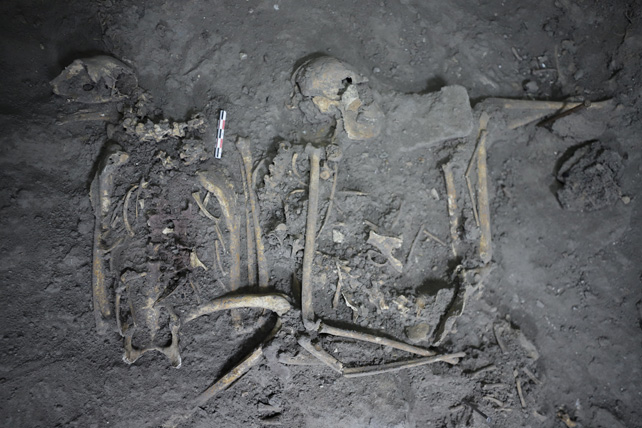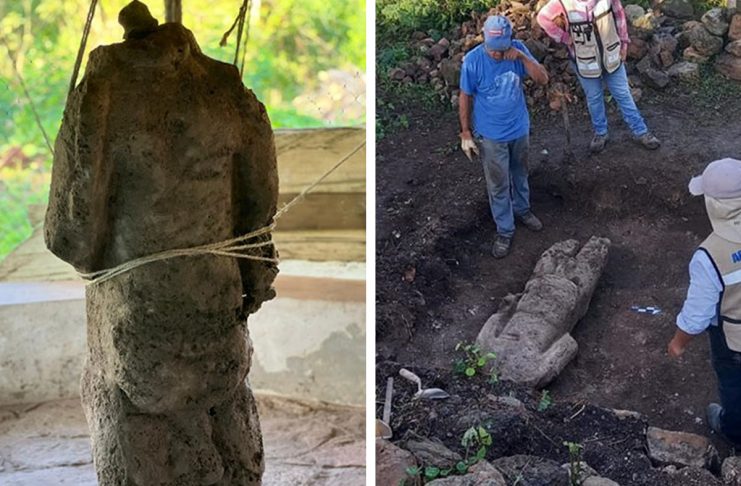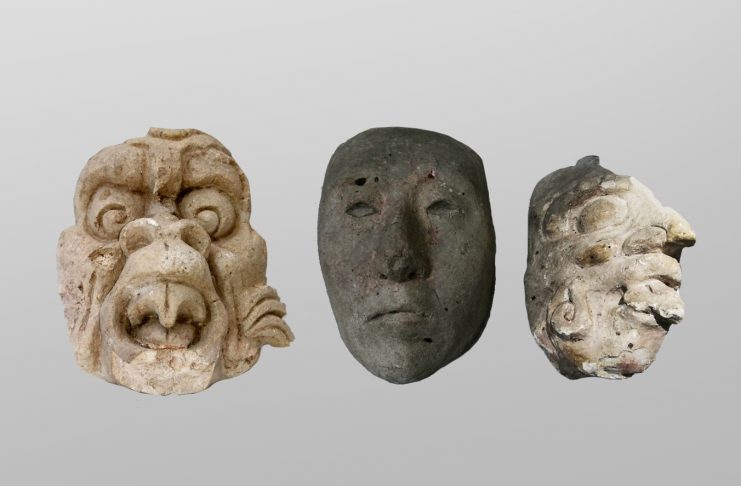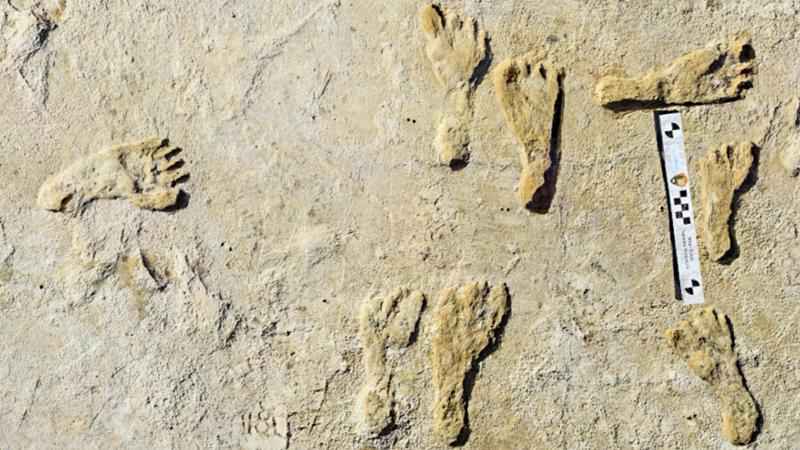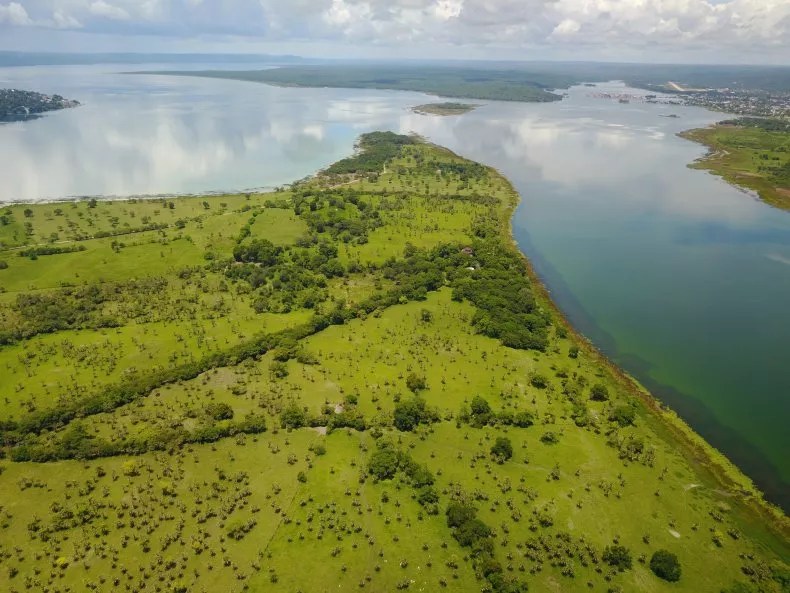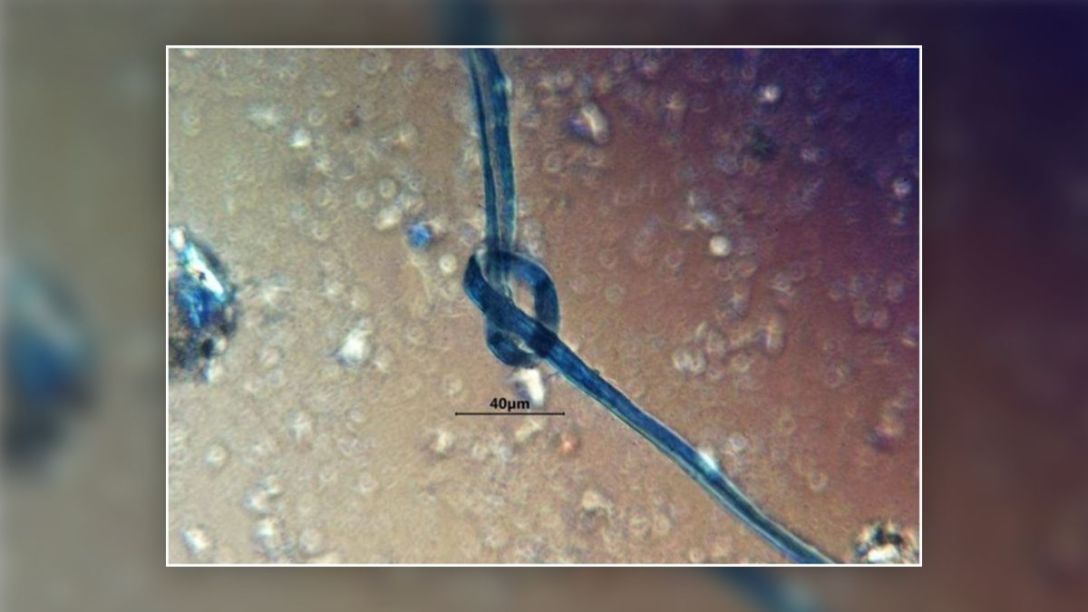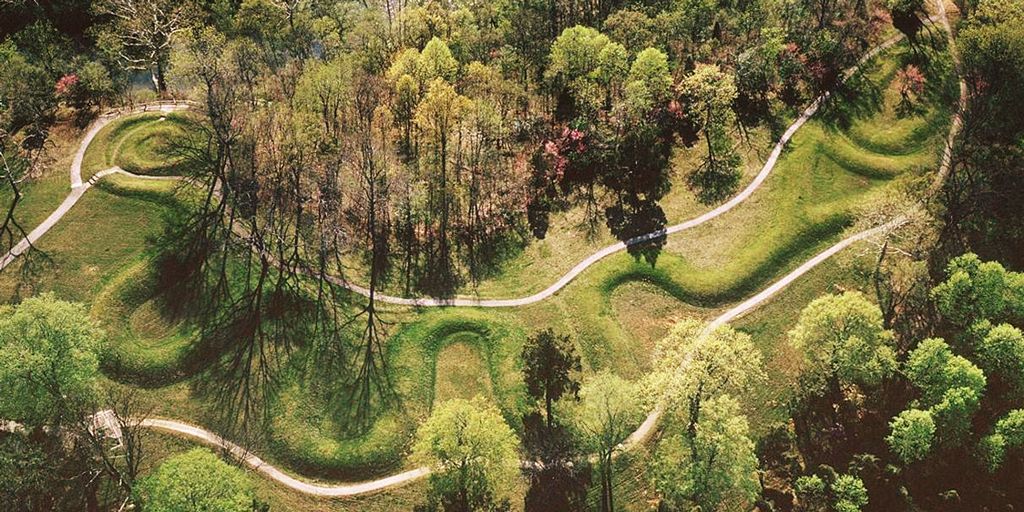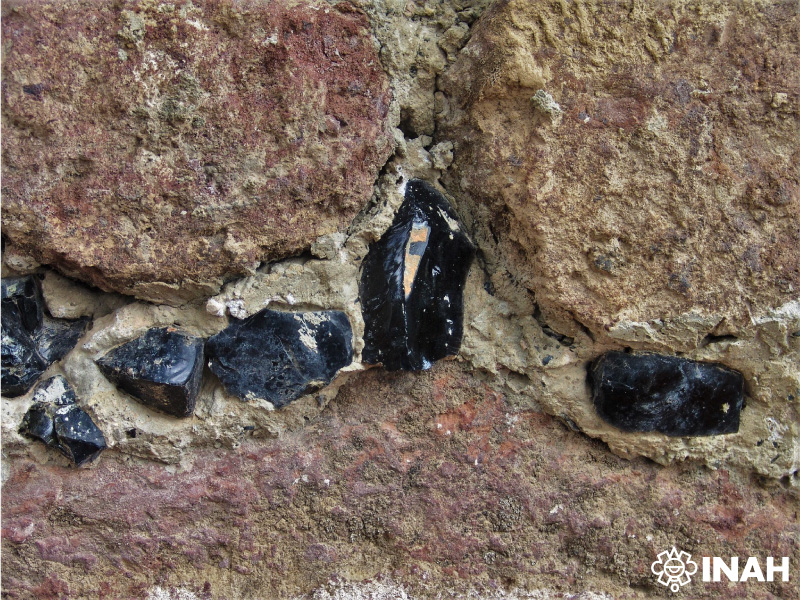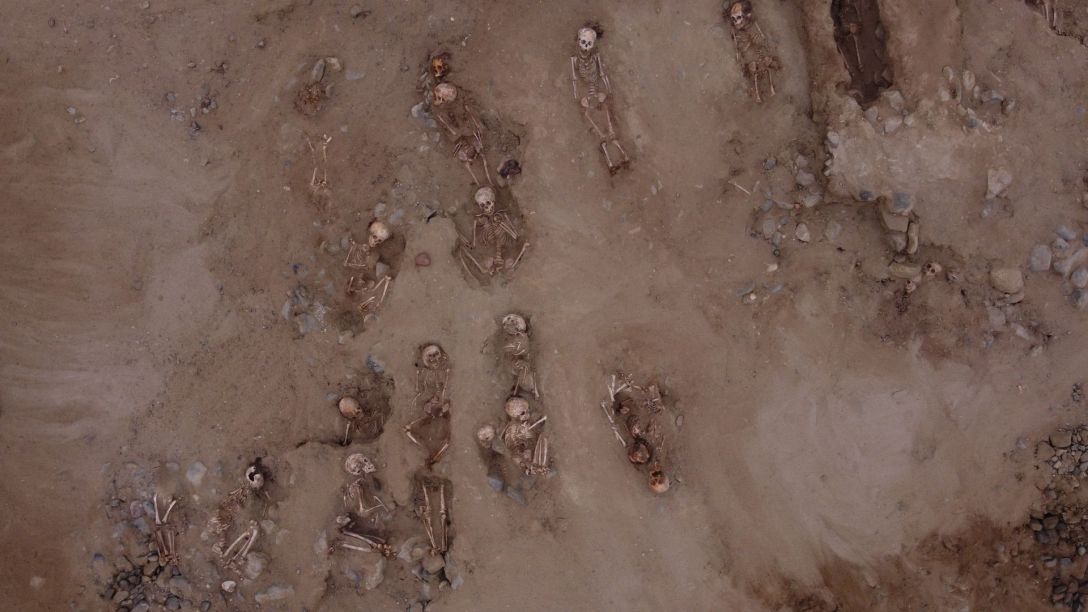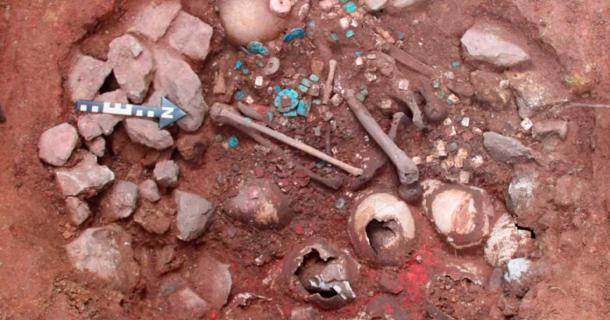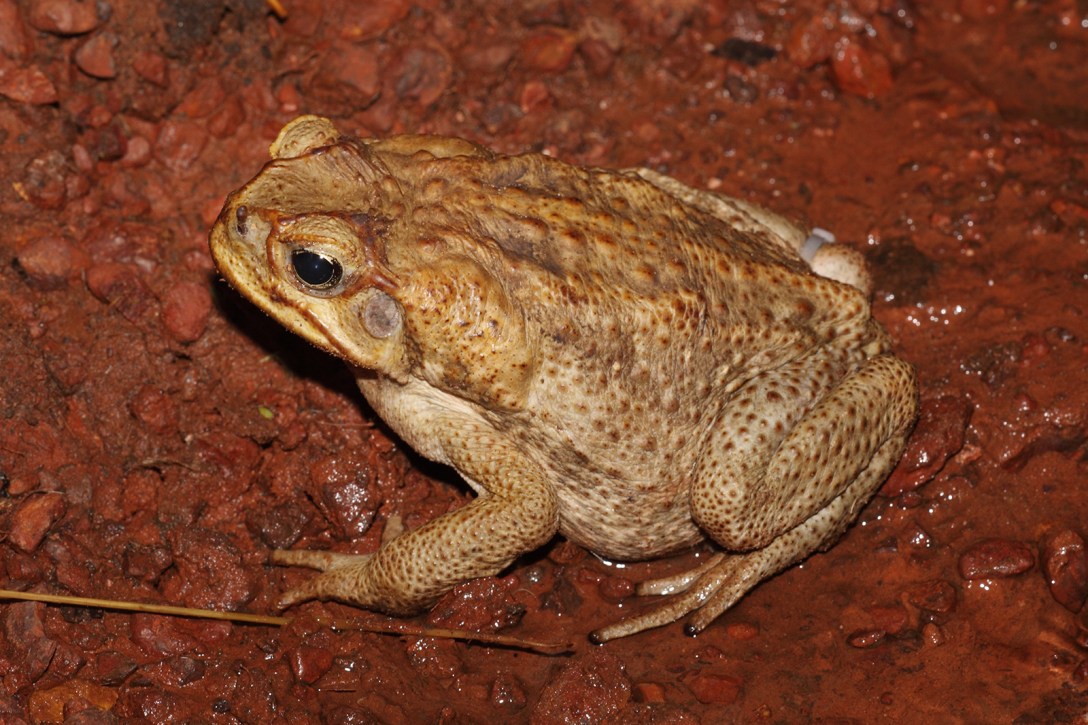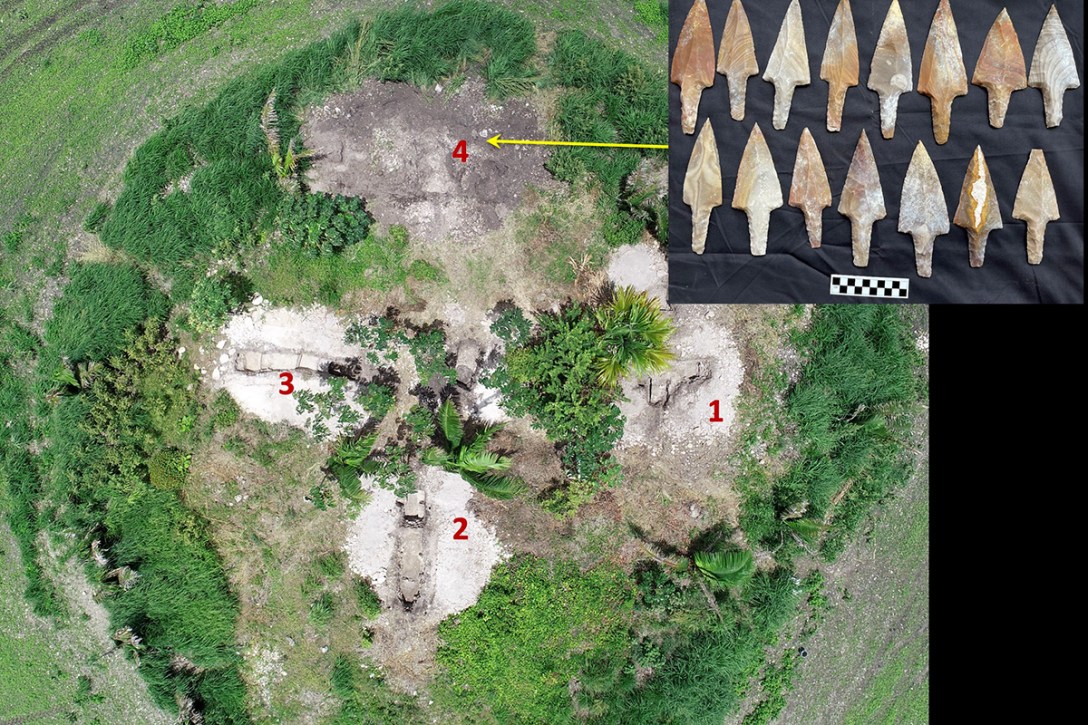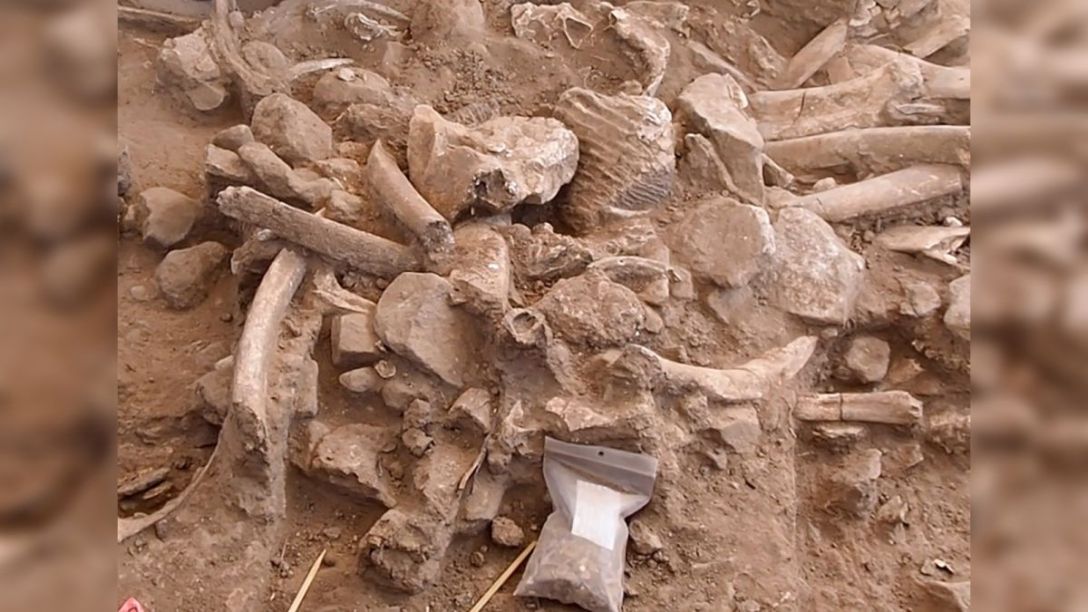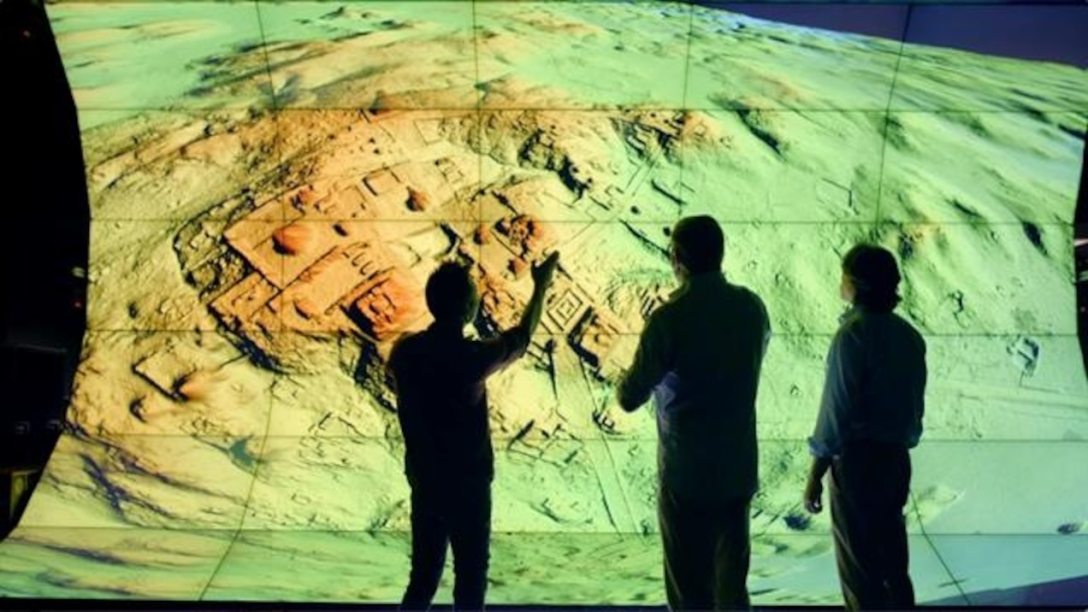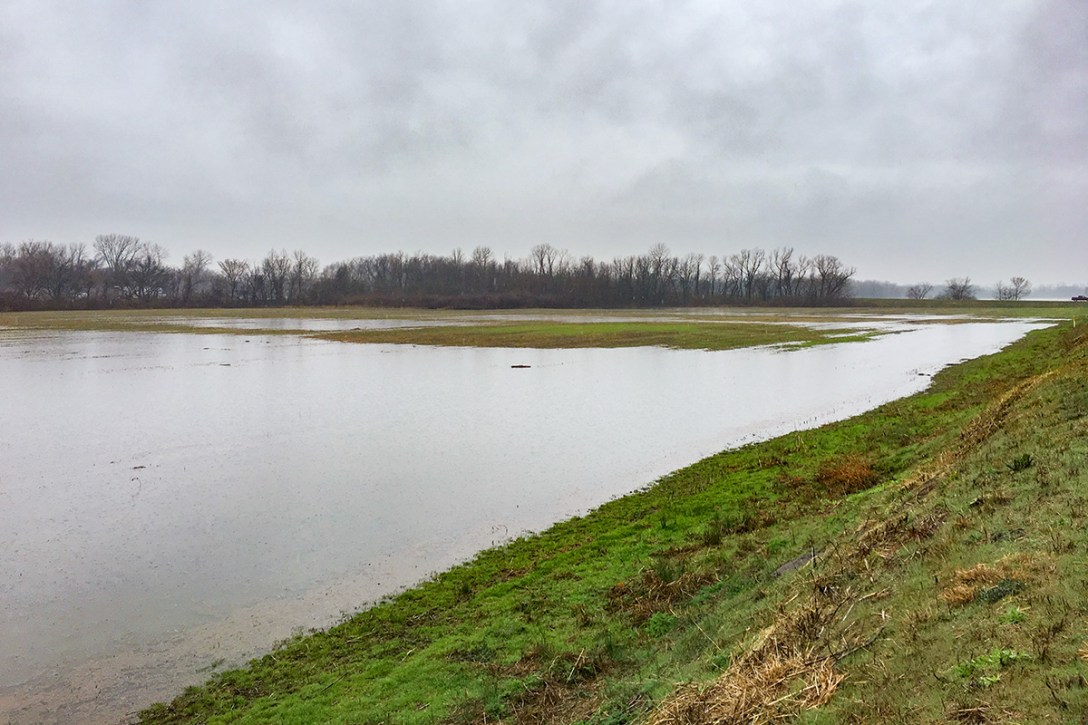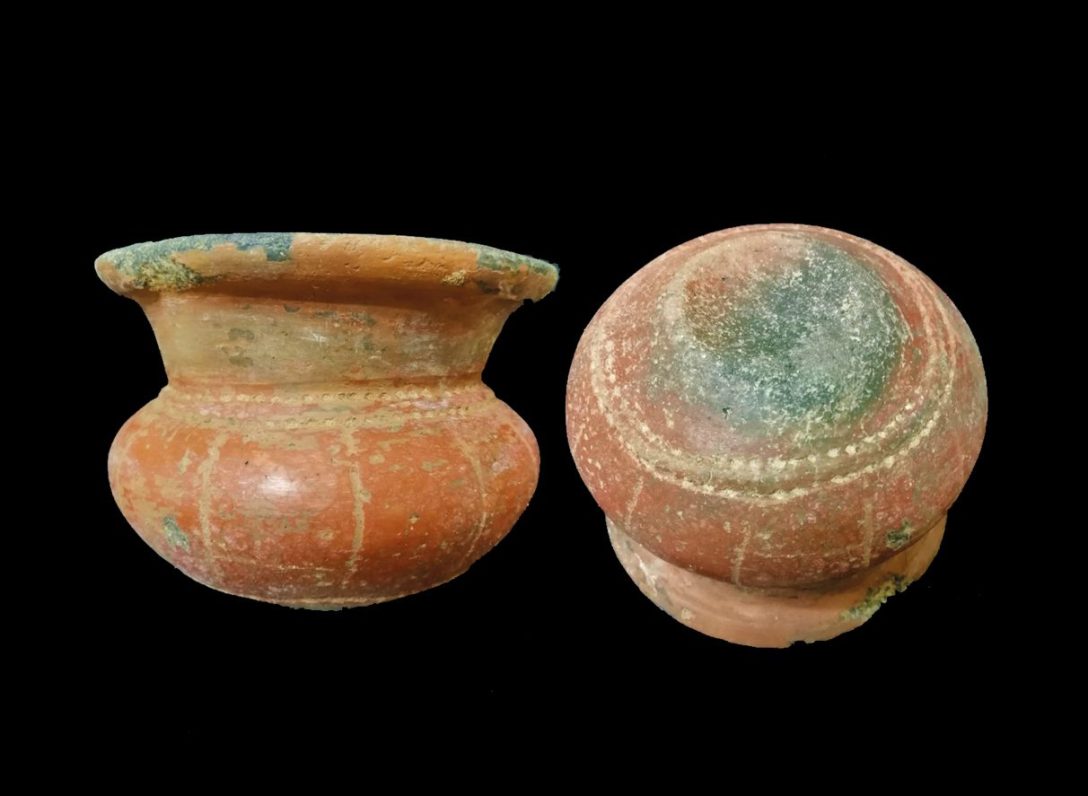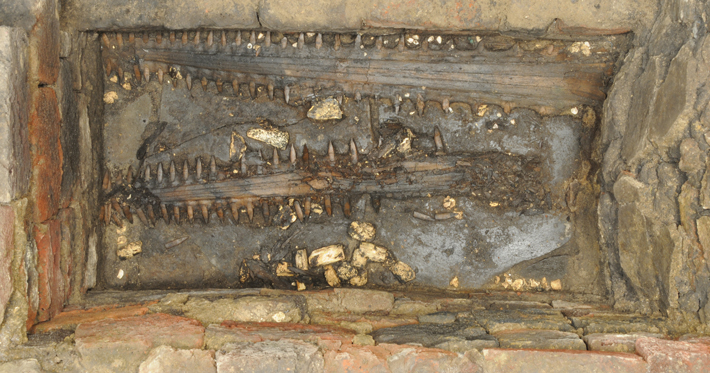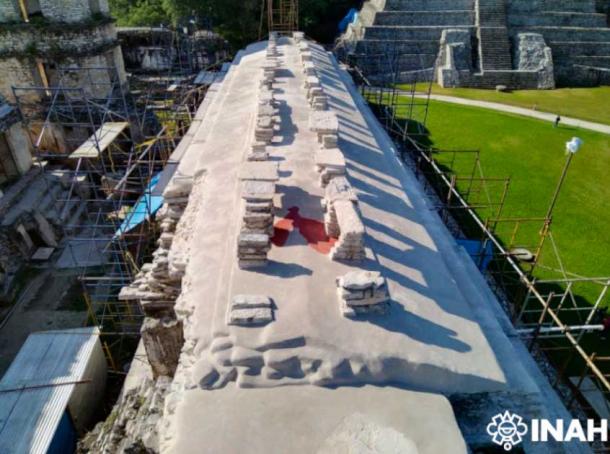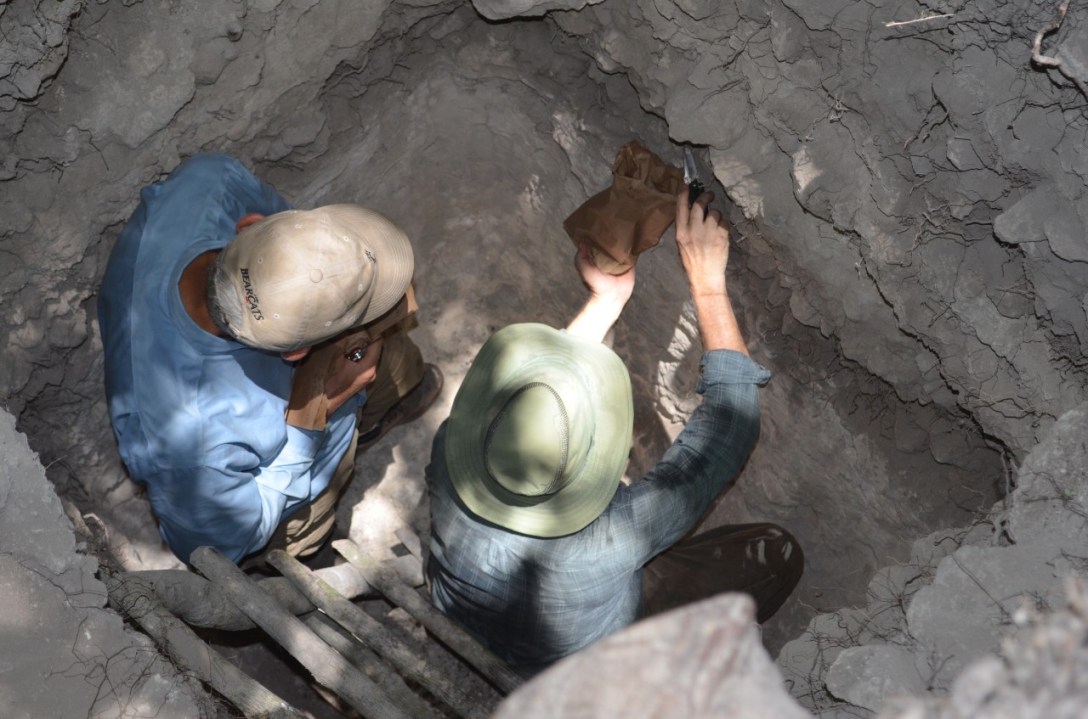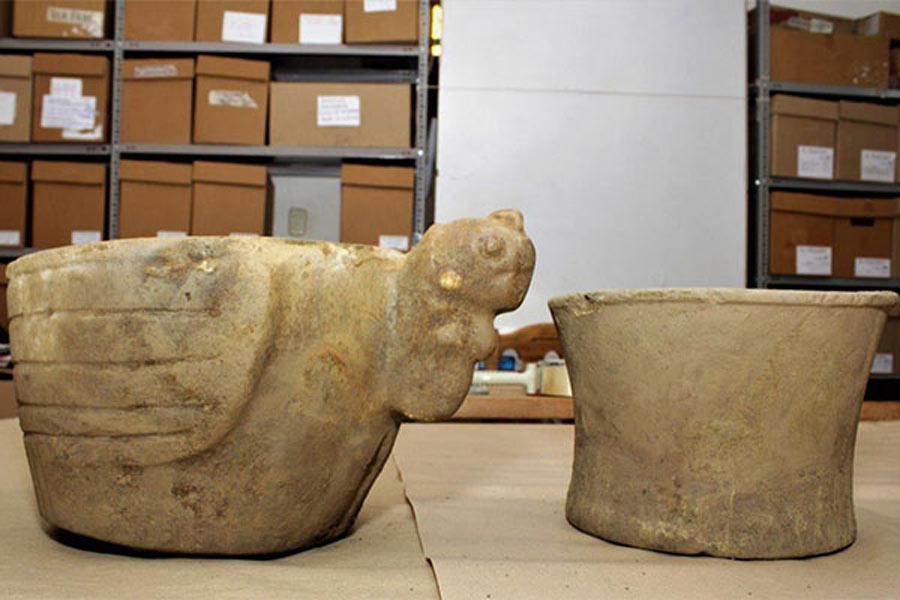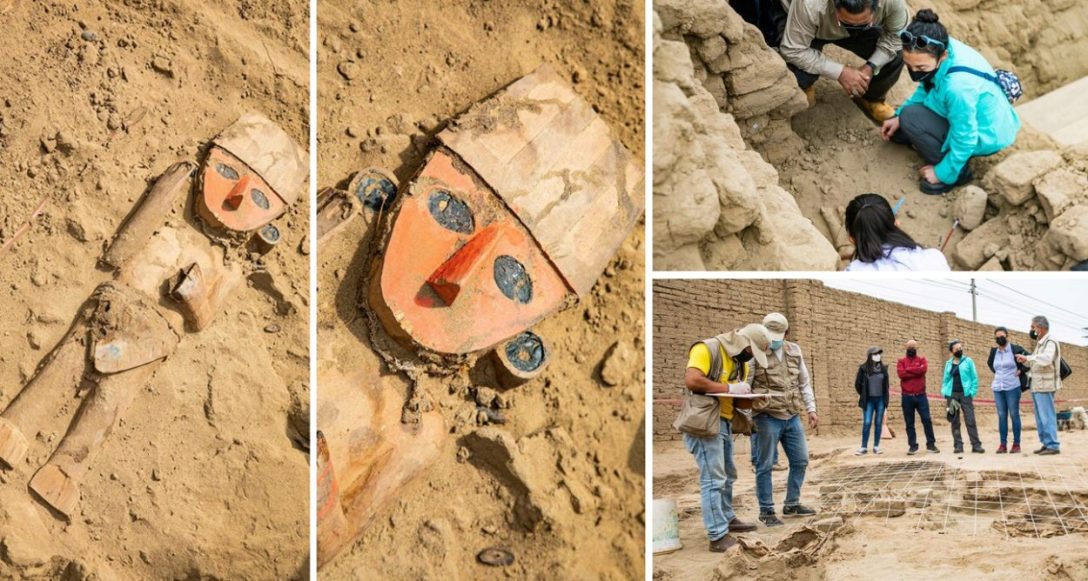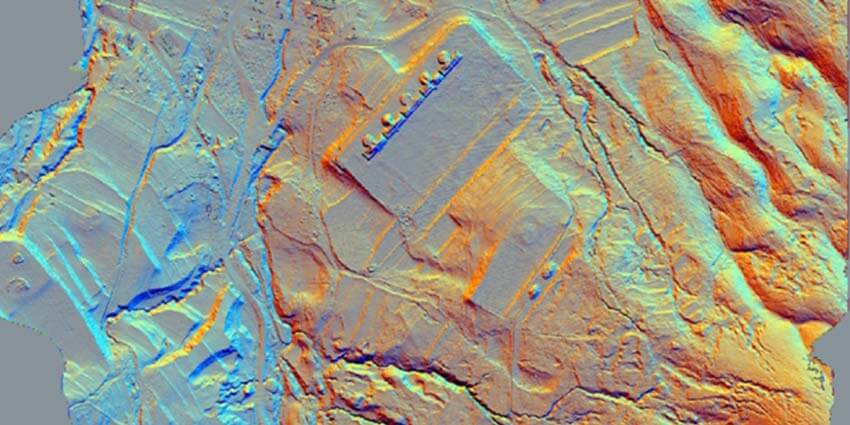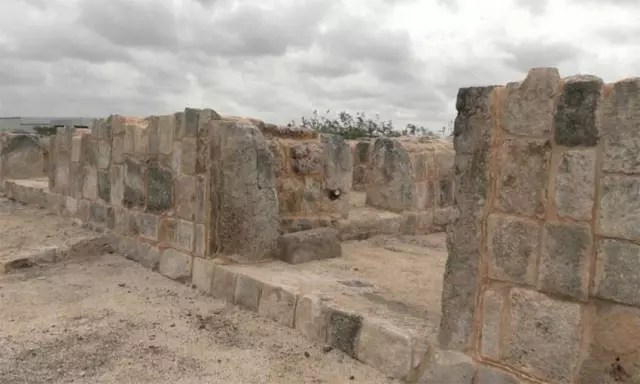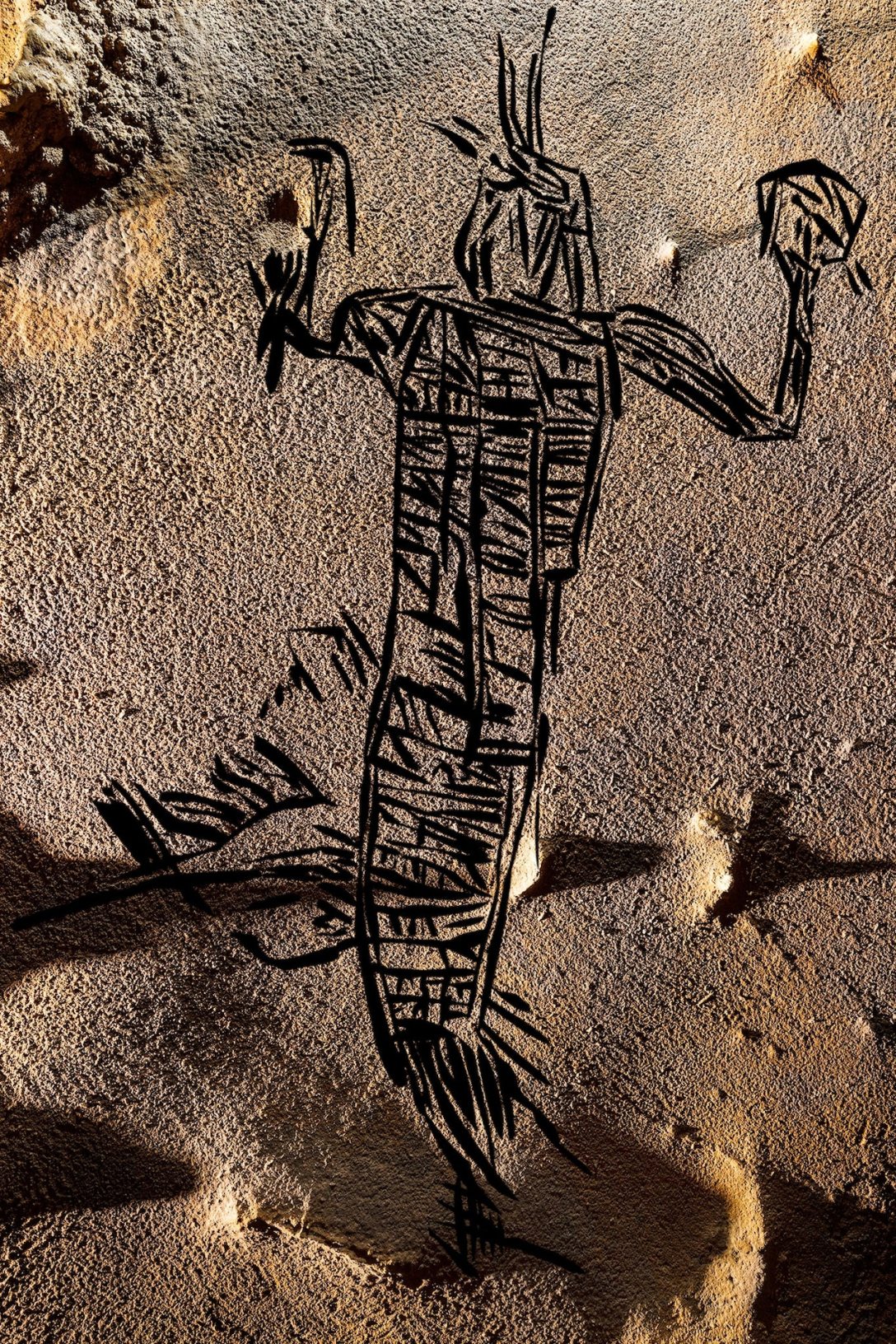Author: mikeruggeri
New finds in Puémape (Peru) (Select English Translation)
Archaeologists discover 3,000-year-old ceremonial center in Peru
Peruvian origin of cocoa (Select English Translation)
Diet of ancient Andes hunter-gatherers was 80% plant-based, study finds
Rewriting History: Andean Archery Found To Be 5,000 Years Old, Far Earlier Than Previous Estimates
4700-year-old Megalithic Circle Discovered in the High Andes of Peru
Six Centuries of the Condor
Study uses satellite imagery to identify over 1,000 Andean hillforts
Early Settlers of Rapa Nui Had Contact With South America
Study reveals evidence of violence at a time of crisis in ancient Peru
Discovery in Maya pyramid reveals dramatic dynasty collapse, archaeologists say
Mysterious Pattern in a Cave Is Oldest Rock Art Found in Patagonia
Ancient walls — that served as ‘Google Maps’ for the Mayans — discovered in Mexico
Discovery in Maya pyramid reveals dramatic dynasty collapse, archaeologists say
Remarkable discovery: Czech archeologists unearth 3,000-year-old Mayan city
Ancient Maya Elite Ate Freshwater Crab to Celebrate Special Occasions
Maya Funeral Urn Depicting Corn God Unearthed by Archaeologists
Jade Mask discovered in pyramid tomb of Maya King
Study finds evidence of Mesoamericans drinking tobacco during healing rituals
Groundbreaking Study Cracks Mystery of Humans Migrating to Americas 26,000 Years Ago
5,200 years of migrations from Mexico to California may be the origin of a mystery language
Discovery of ‘Calendar’ Rock Carvings from Ancestral Pueblo in US Southwest Surpasses ‘Wildest Expectations’
New Dating of Cave Art Reveals History of Puerto Rican People
Warrior-Trader Mixtec Tomb Unearthed in Central Mexico Town Square
Artifact Laden Pre-Hispanic, Pre-Volcanic Tombs Excavated in Chapultec Forest, Mexico
Rich array of funerary offerings found in burials at Cima de San José, Tamaulipas, Mexico
2,500-year-old burials of 3 people discovered in a cave in Nuevo León, Mexico
Confirmed! Los Morteros Site is the oldest adobe architecture in America
Inca quarries and road network found in Cañete
Feline and anthropomorphic 29 new geoglyphs discovered in Peru
73 intact Wari mummy bundles and Carved Masks Placed On False Heads Discovered In Peru
Archaeologists discover mummies of children that may be at least 1,000 years old – and their skulls still had hair on them
Survey Finds 18 km Maya Sacbé Using LiDAR
Maya Warrior Head Sculpture Found at Chichén Itzá
In Ek’ Balam, Yucatán, They Discover Ancient Chultún Reused as a Burial Chamber
Hidden Burial Chamber Discovered at Tulum Maya Site in Mexico
Archaeologists Discover Ancient Camp Where Maya Ate Cooked Snails
Archaeologists Find Lid of Ancient Vault With Snake Symbol at Maya Palace
Archaeologists Find Lid of Ancient Vault With Snake Symbol at Maya Palace
Stone Knives Discovered in Ancient Maya City Near Sacrificial Altar
Ancient Maya Canoe Found In Mexican Cave Could Mark Portal To The Underworld
MAYA TOMB WITH FUNERARY OFFERINGS FOUND DURING HOTEL CONSTRUCTION
October 24, 2023
Palatial 1,500-year-old Maya structure unearthed in Mexico
https://www.livescience.com/archaeology/palatial-1500-year-old-maya-structure-unearthed-in-mexico
October 24, 2023
Palatial 1,500-year-old Maya structure unearthed in Mexico
https://www.livescience.com/archaeology/palatial-1500-year-old-maya-structure-unearthed-in-mexico
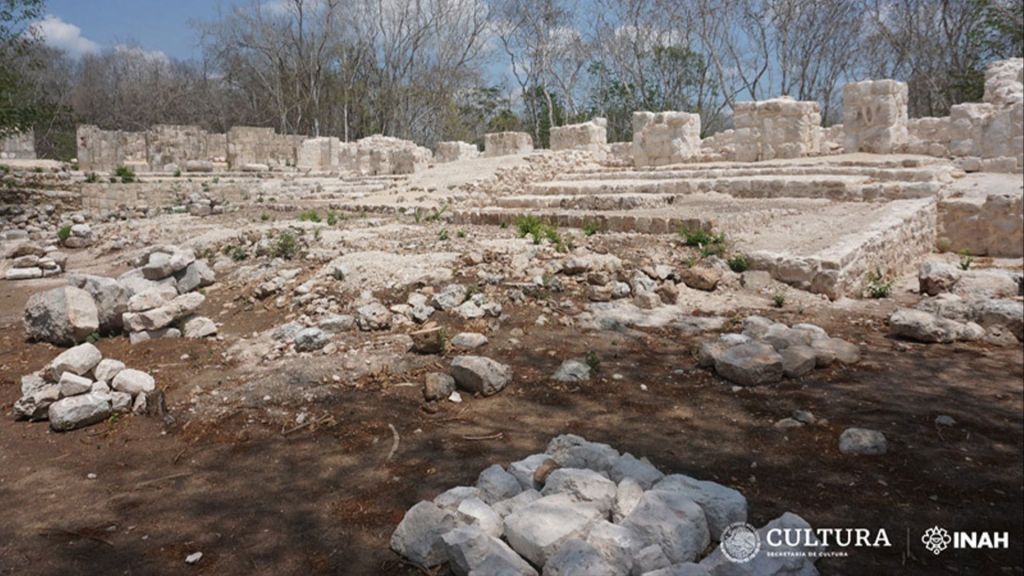
October 24, 2023
MAYA TOMB WITH FUNERARY OFFERINGS FOUND DURING HOTEL CONSTRUCTION

October 24, 2023
Ancient Maya Canoe Found In Mexican Cave Could Mark Portal To The Underworld

October 24, 2023
Stone Knives Discovered in Ancient Maya City Near Sacrificial Altar
https://www.newsweek.com/stone-knives-discovered-ancient-maya-city-near-sacrifical-altar-1812025
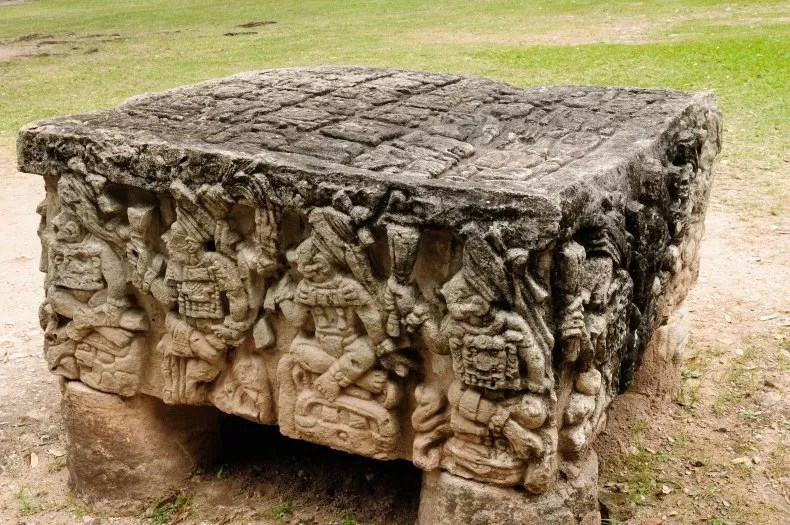
October 23, 2023
Archaeologists Find Lid of Ancient Vault With Snake Symbol at Maya Palace
https://www.newsweek.com/archaeologists-find-lid-ancient-vault-snake-symbol-maya-palace-1827482

October 23, 2023
ARCHAEOLOGISTS UNCOVER MAYA DISH DEPICTING WAHYIS SPIRIT
https://www.heritagedaily.com/2023/08/archaeologists-uncover-maya-dish-depicting-wahyis-spirit/148358
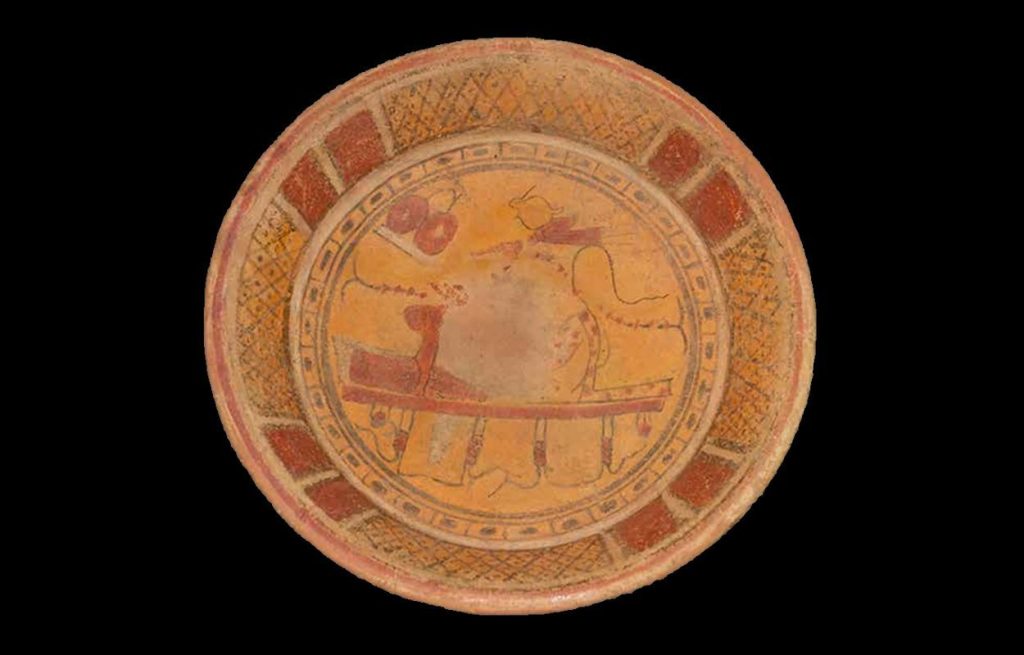
Pre-Incan Site For Ancestor Worship Found In Peru
‘Thunder Floor’ Found at Ancient Andean Site in Peru
Long-lost Ancient Mural Rediscovered in Northern Peru After more than a Century
At Peru Temple Site, Archaeologists Explore 3,000-Year-old ‘Condor’s Passageway
Scarlet Secrets: Scientists Uncover Ancient Breeding of Scarlet Macaws

September 21, 2023
Scitech Daily has the report here;
https://scitechdaily.com/scarlet-secrets-scientists-uncover-ancient-breeding-of-scarlet-macaws/
Mike Ruggeri’s Ancient North America News
https://mikeruggerisancientnorthamerica.tumblr.com
Offerings of Anthropomorphic Figurines Found at Aztec Templo Mayor
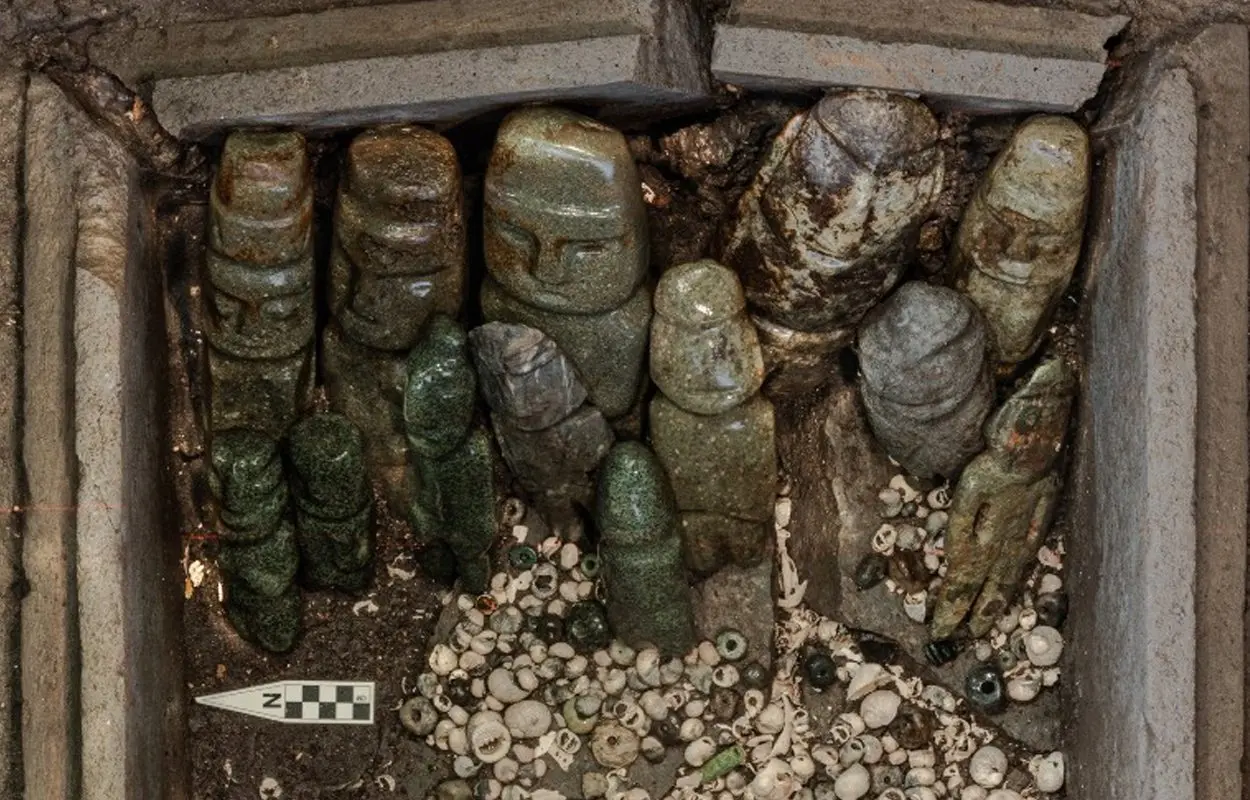
September 21, 2023
Heritage Daily has the report here;
Mike Ruggeri’s Ancient Aztec News
https://aztecnews.tumblr.com
Zapotec ‘entrance to underworld’ discovered under Catholic church in Mexico
6 burials found on same site as Young Ruler of Amajac II statue
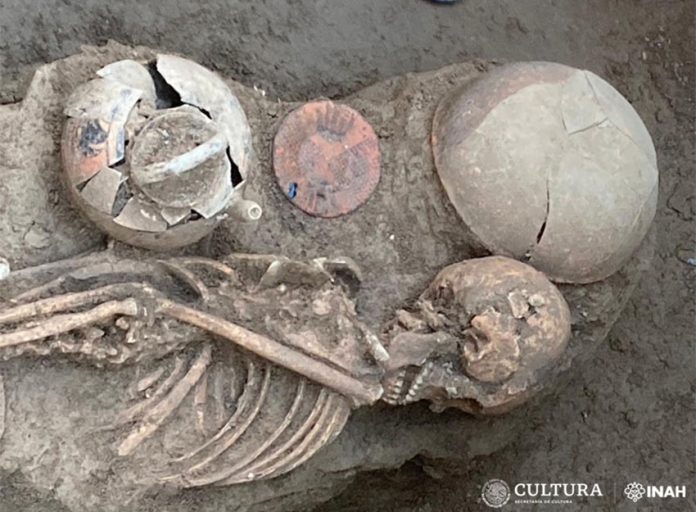
August 23, 2023
Mike Ruggeri’s Mesoamerica After Teotihuacan
http://mikeruggerispostteotihuacan.tumblr.com
Ancient Human Remains With Heart-Shaped Skulls Discovered
ARCHAEOLOGISTS UNCOVER TEOTIHUACANO VILLAGE IN MEXICO CITY
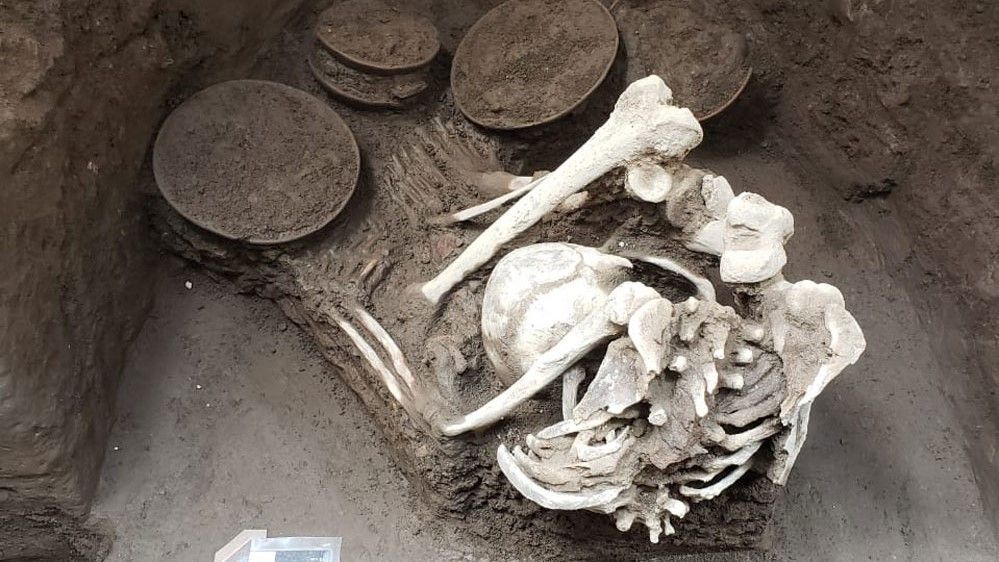
‘Lost’ 1,500-year-old Teotihuacan village discovered in the heart of Mexico City
Mike Ruggeri’s Teotihuacan News
https://mikeruggeristeotihuacannews.tumblr.com
Archaeologists Uncover Olmec Ceremonial Center
INAH confirms discovery of Aztec settlement in Guerrero
August 23, 2023
Mike Ruggeri’s Ancient Aztec News
https://aztecnews.tumblr.com
Mike Ruggeri’s Ancient Aztec News
https://aztecnews.tumblr.com
Lasers and Chemistry Reveal How How an Ancient Empire Functioned
Archaeologists in Peru Used A.I. to Discover Ancient Geoglyphs of Killer Whales, Two-Headed Snakes, and Other Creatures Carved Into Land
3,000-Year-Old Mummy Discovered Buried With Coca Leaves And Seashells In Peru
1,000-year-old wall in Peru was built to protect against El Niño floods, research suggests
Ancient Maya ‘Deity of Death’ Sculpture Unearthed in Mexico
MAYA RITUAL OFFERINGS DISCOVERED AT UXMAL
Ancient Maya City Discovered in Campeche
Relationship of sacrificial deposits 111 and 176 with the Templo Mayor to the god Huitzilopochtli
Some of the first humans in the Americas came from China, study finds
Surprising diversity of ethnic groups in the Virgin Islands before Columbus
Tomb of personage with strong bonds to sea sheds further light on pre-Inca Peru
Discovery of ‘superhighways’ suggests early Mayan civilization was more advanced than previously thought
The prehistoric cave where they found remains of the first settlers of Nuevo León
Pre-Columbian sculpture found in Veracruz may depict female ruler
Archaeologists Discover 1,400-Year-Old Murals of Two-Faced Men in Peru
May 10, 2023
Smithsonianmag has the report here:
https://www.smithsonianmag.com/smart-news/1400-year-old-mural-two-faced-man-peru-180981975/
2nd ritual bath used by Inca royalty discovered at Peru archaeological site
May 10, 2023
Laprensalatina has the report here;
https://www.laprensalatina.com/2nd-ritual-bath-used-by-inca-royalty-discovered-at-peru-archaeological-site/
More than 100 pre-Hispanic religious sites linked to ancient Andean cults discovered in Bolivia
May 10, 2023
Phys.org has the report here;
https://phys.org/news/2023-04-pre-hispanic-religious-sites-linked-ancient.html
Peruvian archaeologists unearth pre-Incan teenage mummy with preserved skin and hair
May 10, 2023
Euronews has the report here:
https://www.euronews.com/culture/2023/04/26/peruvian-archaeologist-unearth-pre-incan-teenage-mummy-with-preserved-skin-and-hair
Oldest human remains from Puerto Rico reveal a complex cultural landscape since 1800BC
Native Americans Conducted Large-Scale Copper Mining 6,000 Years Ago
May 10, 2023
ScientificAmerican has the report here;
https://www.scientificamerican.com/article/native-americans-conducted-large-scale-copper-mining-6-000-years-ago/
Wichita State professor uncovers forgotten native nation that could ‘revolutionize’ history of the Great Plains
May 10, 2023
Wichita.edu has the report here;
https://www.wichita.edu/about/wsunews/news/2023/03-march/quivira_3.php?fbclid=IwAR08lU637CIqJdpso_JIFsW-exzO9r6sK7MlRrQOFXCboTCRQG703-c7Vjs
Researchers Discover How the Maya Created More Durable Plaster
MAY 9, 2023
Physorg has the report here:
https://phys.org/news/2023-04-secret-ingredient-durable-mayan-plaster.html
Decapitated Elite Maya Uncovered at the Maya site of Moral-Reforma in Tabasco
MAY 9, 2023
Heritage Daily has the report here:
https://www.heritagedaily.com/2023/04/decapitated-and-dismembered-bodies-found-at-maya-pyramid/147050
New Revelations on the Complexity of the Maya Calendar
MAY 9, 2023
Spacechatter has the report here;
https://www.spacechatter.com/2023/04/28/maya-calendar-mystery-solved-scientists-say-theyve-cracked-its-ancient-code/
Rare Sculpture of the Maya God K’awil Uncovered While Constructing the New Maya Train
May 9, 2023
Mexiconewsdaily has the report here;
https://mexiconewsdaily.com/news/rare-statue-mayan-god-kawiil-found-maya-train/?fbclid=IwAR2lsdjrUvLQnsbeCn8rgjfITAP9G0a8oV5FoWfVDxTDsvaY0xkRvhMGt8Q
A New Theory on the Number of Female Skulls on the Great Skull Rack at Tenochtitlan
April 17, 2023
INAH archaeologists have surmised that the large number of female remains on the great skull rack in the Aztec capital of Tenochtitlan are related to the origin myth of Huitzilopochtli. The skull rack is dated to the reign of Ahuzotl from 1486-1502 He doubled the size of the Aztec empire during his reign.
The myth of Huitzilopochtli, the solar and war deity of the Aztecs, includes the great confrontation he had with the lunar goddess Coyolxauqui. There are 655 human skulls on the skull rack. 38% of them are females. They were probably female warriors or pregnant women who had a stillbirth. Female sacrifices recreated the path of Coyolxauqui to Serpent Mountain (Mount Coatepec) where she attacked her mother Coatlicue. Huitzilopochtli was in Coatlicue’s womb, and sprang fully armed from the womb of his mother and threw Coyolxauqui down the side of the mountain.
Heritage Daily has the INAH report here:
Mike Ruggeri’s Ancient Aztec News
New Discoveries at the Great Pyramid of Cholula
March 17, 2023
The Cholula Pyramid is dedicated to the major god of the Aztecs, Quetzalcoatl
INAH is doing restoration work at the pyramid and have found an adobe core on the east side that dates to Late Classic. Broken ceramics there were braziers indicating sustained use of fire at the pyramid. A cylindrical sculpture in white stone representing Tlaloc, the god of rain, storms and fertility has been uncovered.
INAH is studying the underground level and 24 tunnels under the pyramid.
Heritage Daily has the report with photos here; https://www.heritagedaily.com/2023/02/new-discoveries-at-great-pyramid-of-cholula/146158
Mike Ruggeri’s Mesoamerica After Teotihuacan http://mikeruggerispostteotihuacan.tumblr.com
(Scroll down to Cholula)
New Huastec Site Discovered
March 17, 2023
Archeologists in the Mexican state of Tamaulipas at the Huastec state of El Naranjo have uncovered four earthen mounds. The new area was used for burials and daily activities. They have found hearths, ceramics, projectile points, and grinding stones.
Mound 4, revealed multiple burials of adults adorned with earrings made of green quartz and shells, some carved in the shape of flowers. At the larger Mound 1, researchers identified several other burials, and a grave one adult within a limestone structure.
The mounds were made of alternating layers of earth, limestone and basalt. The area was uncovered as a result of new highway construction in the area, and research will continue.
The Art Newspaper has the INAH Report here;
Mike Ruggeri’s Mesoamerica After Teotihuacan http://mikeruggerispostteotihuacan.tumblr.com
(Scroll down to Huastecs)
9,000 Year Old Remains in the Cueva de la Paloma in the Oaxaca Valley Reveal Hunter-Gatherer Diet at That Ancient Date
March 17, 2023
Archaeologists have unearthed 9.000 year old remains beneath a layer of sediment. Cave paintings, charred birds and turtles, pollen from wild plants; yucca, chile, guava, pumpkin seeds, agave leaves
Macon.com has the report here with photos;
https://www.macon.com/news/nation-world/world/article271519622.html#storylink=cpy
New Discoveries at the Great Pyramid of Cholula
March 17, 2023
The Cholula Pyramid is dedicated to the major god of the Aztecs, Quetzalcoatl
INAH is doing restoration work at the pyramid and have found an adobe core on the east side that dates to Late Classic. Broken ceramics there were braziers indicating sustained use of fire at the pyramid. A cylindrical sculpture in white stone representing Tlaloc, the god of rain, storms and fertility has been uncovered.
INAH is studying the underground level and 24 tunnels under the pyramid.
Heritage Daily has the report with photos here; https://www.heritagedaily.com/2023/02/new-discoveries-at-great-pyramid-of-cholula/146158
Mike Ruggeri’s Mesoamerica After Teotihuacan http://mikeruggerispostteotihuacan.tumblr.com
(Scroll down to Cholula)
New Huastec Site Discovered
March 17, 2023
Archeologists in the Mexican state of Tamaulipas at the Huastec state of El Naranjo have uncovered four earthen mounds. The new area was used for burials and daily activities. They have found hearths, ceramics, projectile points, and grinding stones.
Mound 4, revealed multiple burials of adults adorned with earrings made of green quartz and shells, some carved in the shape of flowers. At the larger Mound 1, researchers identified several other burials, and a grave one adult within a limestone structure.
The mounds were made of alternating layers of earth, limestone and basalt. The area was uncovered as a result of new highway construction in the area, and research will continue.
The Art Newspaper has the INAH Report here;
Mike Ruggeri’s Mesoamerica After Teotihuacan
http://mikeruggerispostteotihuacan.tumblr.com
(Scroll down to Huastecs)
9,000 Year Old Remains in the Cueva de la Paloma in the Oaxaca Valley Reveal Hunter-Gatherer Diet at That Ancient Date
March 17, 2023
Archaeologists have unearthed 9.000 year old remains beneath a layer of sediment. Cave paintings, charred birds and turtles, pollen from wild plants; yucca, chile, guava, pumpkin seeds, agave leaves
Macon.com has the report here with photos;
https://www.macon.com/news/nation-world/world/article271519622.html#storylink=cpy
2,000 Year Old Zapotec Murals Found in Tombs in Southern Mexico
March 17, 2023
The murals show black lines, ornately dressed figures in red and yellow hues in San Pedro Nexicho, in southern Oaxaca. They are north-east of the great Zapotec capital of Monte Alba
INAH says one mural represents a war procession and was painted in a codex style. The larges tomb was looted long ago but a golden bead, ceramic pieces, shells and green stones have been found at the site. Two tombs were found intact, and human remains there will be studied. In one tomb, 240 objects were found with Zapotec writing on stucco among them.
The tombs are dated at 200-1100 CE.
ABC Australia has the report here with photos;
Mike Ruggeri’s Zapotecs
New Research on the Use of Psychedelics in Early Nazca Culture
March 15, 2023
Researchers in Peru haver analyzed the remains of 22 individuals from the early Nazca culture (100 BCE-400 CE)at 3 Nazca sites. 4 of them were trophy heads, a child, an adult female and two male adults. They found a high level of mescaline from the San Pedro cactus in the sacrificed individuals and in the child’s hair. This cactus is known in the Quechua language as Huachuma, meaning “removing the head.” And the child and the other three had their heads removed after sacrifice. The female adult had also been chewing coca leaves. The male heads were free of drugs since they were males capture in combat.
More recent Inca civilization gave ayahuasca to child sacrifice victims as an anti-depressant while they awaited their fate. However, as the study authors note, “this is the first proof that some of the victims transformed into trophy heads were given stimulants prior to their death.”
The same study also found evidence of ayahuasca use among other mummified individuals from the Early Nazca Period – which ran from 100 BCE to 450 CE – and therefore provides the earliest archaeological evidence for the consumption of these two psychedelic plants.
Ayahuasca was found in the hair of two other individuals among the remaining 18. One had so much in his hair that it suggests he was a shaman. Coca was found in five others. This is the earliest evidence of the use of Ayahuasca and San Pedro ever found, and confirms the use of Coca leaves in the early Nazca culture.
The study has been published in the Journal of Archaeological Science.
Iflscience.com has the report here;
Mike Ruggeri’s Nazca Era Peru
http://mikeruggerisnazcaera.tumblr.com
Archaeologists Discover Wari Ritual Complex at the Pakaytambo Site in Southern Peru.
March 15, 2023
The complex has a D-shape temple on a large, monumental platform next to housing structures for officials and people linked to the Wari empire. It was strategically chosen, being between the Andean highlands and coastal valleys of Arequipa and along a prehistoric transit route with ecological and political advantages.
The pre-Inca Wari culture spanned from the 6th-10th centuries.
“Open plaza spaces like this would have allowed local communities to participate in ritual gatherings organized by the Wari,” University of Illinois Chicago postdoctoral researcher David Reid said in a statement.
Reid, who also led the study, said these ritual events “would have been critical in maintaining political authority across great distances of the Wari Empire.”
The Wari built other D-shape Wari temples that have recently been found across Peru, providing greater clarity on how the empire expanded and influenced life across the country.
The research was published in the Journal of Anthropological Archaeology. News of the discovery was first reported by the Art Newspaper.
Artnews.com has the report here;
https://www.artnews.com/art-news/news/archaeologists-discover-ancient-wari-ritual-complex-pakaytambo-southern-peru-1234658747/
Mike Ruggeri’s Moche/Wari Era Peru
http://mikeruggerismoche.tumblr.com
Important Research at Mount Tlaloc in the State of Mexico
January 15, 2023
Researchers have discovered that a straight stone causeway on Mount Tlaloc, an extinct volcano, aligns with the rising sun on February 23/24. Mount Tlaloc is in the State of Mexico, where a shrine complex was built by the Mexica people. It was associated by the Aztecs with the rain god Tlaloc. And was seen as the heavenly home of Tlaloc, Tlalocan. Great rituals, offerings and human sacrifices were offered to Tlaloc at the beginning of the rainy season.
If an observer stands in the lower part of the causeway looking upwards on February 23/24, they will see the sun riding exactly in the middle of the path. The Aztec date of the New Year is February 23. They used this date to keep their agricultural calendar in line with the solar year.
The research is published in the Proceedings of the National Academies of Sciences (PNAS)
The full research paper is here;
PNAS
https://doi.org/10.1073/pnas.2215615119
Heritage Daily has the report here;
https://www.heritagedaily.com/2023/01/ruins-on-mount-tlaloc-are-an-ancient-observatory/145743
Mike Ruggeri’s Ancient Aztec News
https://aztecnews.tumblr.com
Recently Excavated Sculpture of Xipe Toltec Placed on Display at the Templo Mayor
January 15, 2023
A statue of the Aztec deity Xipe Totec (the Flayed God), excavated in the Moyotlan quadrant of the Aztec capital of Tenochtitlan, will go on display at the Templo Mayor museum in Mexico City. Xipe Totec was the patron god of that Aztec quadrant. It is 27 inches high, carved from andesite. It is missing its shield. He wears a shirt of flayed skin from a sacrificed victim. It was discovered last year during excavations on Las Delicisas street in downtown Mexico City. It was buried under adobe fill, hidden from Spanish invaders.
The restored sculpture is now on display in the lobby of the museum where it will remain until April 2nd.
History Blog has the report here
http://www.thehistoryblog.com/archives/66147
Mike Ruggeri’s Ancient Aztec News
https://aztecnews.tumblr.com
New Research May Show People Moved Back and Forth From North America to Siberia
January 14, 2023
The remains of three people who died in Kamchatka, Siberia show they had North American genes. So people traveled back and forth across the Bering Sea region. Researchers studied genetic and linguistic evidence that showed folks in North America boated back to Siberia. This new DNA evidence bolsters the proof of this. The evidence from this new DNA study shows evidence of this return journey 5,000 years ago and 1,500 years ago.
However, critics point out that the genes identified as North American comes from a group that never left Siberia but shares ancestry with Native Americans.
Ancient Siberia is turning out to be a crossroads. Altai hunter-gatherers in Siberia are related to Bronze Age people from Central Asia. One who appears to have been a shaman in the burial remans had northeast Asian ancestry. And one has ancestry from the Jomon people in Japan.
The research is published in Current Biology
Science.org has the report here.
Mike Ruggeri’s Pre-Clovis and Clovis News on Tumblr
Pedra Furada Pre-Clovis Claims Debunked
January 14, 2023
Some researchers have been claiming that they found stone tools made by humans that were in use 50,000 years ago at the Pedra Furada site in Brazil. But new research shows that Capuchin monkeys widely made and used stone tools in this area at that time. The assemblage found at Pedra Furada does not show anything beyond crude stone tools that were probably made by the Capuchin monkeys.
The monkeys have their own rock quarries, where they selec rocks to use as hammers to crack nuts against a larger, flattened anvil rock. Rocks also come in handy for eating seeds and fruits—and the monkeys even lick the dust created from driving two rocks together, possibly as a way of adding minerals to their diets.
Stone tools assist capuchins with other tasks as well, such as digging. And the females throw rocks at potential mates as a way of demonstrating sexual interest.
All of these processes can lead to the stones breaking into smaller flaked pieces—which, the new study found, are indistinguishable from some ancient stone tools carved by early humans.
The research is published in Sage Journals’ The Holocene
Artnet.com haș the report here:
https://news.artnet.com/art-world/ancient-tools-monkeys-2237820
Mike Ruggeri’s Pre-Clovis and Clovis News on Tumblr
http://mikeruggerispreclovisnews.tumblr.com
Ancient Maya Market System Studied
January 10, 2023
Research into the K’iche led region of Guatemala shows that trade in obsidian was manage by local people through independent trade networks. And it was based on availability and craftsmanship. So it appears this is a system based on a free market. Research was done on a geochemical and technological analysis on obsidian artifacts excavated from 50 sites around the K’iche’ capital. Where did raw material come from and what were the manufacturing techniques used.
In the capital area, centralized control and managed trade was in operation. Outside the core area in conquered areas, they obtained their own obsidian and developed obsidian markets.
The research is published in Latin American Antiquity
Phys.org has the report here;
https://phys.org/news/2023-01-mayas-market-based-economics.htm
Huge New Ancient Maya Civilizational Complex Found in Northern Guatemala
January 10, 2023
A previously unidentified Maya area now 964 settlements have been found by LIDAR flying over Guatemala’s Mirador-Calakmul Karst Basin in northern Guatemala. It is dated to 1000 BCE-150 CE covering 650 square miles with 110 miles of roads. They also built a vast causeway network. There are 775 sites in the central area and 189 sites in the surrounding area. 417 cities, towns, and villages from part of a unified civilization. Patterns, ceramics, sculptures, architecture all show this unity. Thousands of workers had to be mobilized in an area previously thought to be sparsely populated.
“The labor would include lime producers, mortar and quarry specialists, lithic technicians, architects, logistics and agricultural procurement specialists, and legal enforcement and religious officials, all operating under a political and ideological homogeneity,”
Large pyramids and platforms have been identified as well as 30 ball courts. 195 artificial reservoirs and a network of canals for transporting water was were constructed. The study is published in the journal Ancient Mesoamerica.
The report is published here;
168 New Nazca Geoglyphs Discovered in Peru
January 7, 2023
Archaeologists from Japan’s Yamagata University have discovered 168 new Nazca Lines on the Pampas de Juman in the Nazca Desert in southern Peru, the latest addition to over 800 straight lines, 300 geometric figures, and 70 animal and plant designs
The figures depict humans, camelids, birds, killer orca whales, cats, and snakes, and date to 100 BCE-300 C.E. Some measure just 10 or 20 feet long, which helps explain why they went undetected for so long. In comparison, the biggest geoglyphs measure about 1,200 feet across.
They conducted researcjwith drones, taking aerial photos, and conducting field surveys from June 2019 to February 2020, using high-resolution aerial photographs taken by drones. A.I. technology provided an assist in spotting and deciphering the age-old markings. The Nazca Lines can now be found across a 170-square-mile area.
only 5% of all existing Nazca lines have so far been found. These geoglyphs were created by removing black stones from the surface of the earth to expose a white sandy surface below. it is unclear how the black stone was removed.
Some geoglyphs are in danger of being destroyed due to the recent expansion of mining-related workshops in the archaeological park.
Artnet haș the report here with many photos;
https://news.artnet.com/art-world/new-nazca-lines-discovery-2231132
New Research into Chincha Culture Funeral Rituals in Ancient Peru
January 6, 2023
Researchers analyzed hundreds of human remains from the Chincha culture in Peru going back as far at 1000 CE in large mortuary structures to study the use of fingerprinting red pigment on skulls in funerary rituals. They found different kinds of red paint were used and only certain people were painted. Using X-ray powder diffraction, X-ray fluorescence spectrometry, and laser ablation ICP-MS, techniques, they found that 24 of the samples came from iron based ochres like hematite, 13 came from mercury based cinnabar, and one was a combination. Cinnabar came from hundreds of miles away and the hematite came from local sources.
Most of those whose skulls were painted were adult males. Bones of women and children who had healed traumatic injuries and those whose skulls were modified as babies were also painted. They used textiles, leaves and their hands to apply the pigment. It appears that the painters also entered the mortuaries to paint those who had been desecrated during the European conquest
The research is published in the Journal of Anthropological Archaeology.
Live Science has the report and photos here:
https://www.livescience.com/ancient-skulls-red-fingerpaint-peru
Researchers Study the Remains of a Spider Monkey at Teotihuacan Given by the Maya
December 10, 2022
In 2018, archaeologists found the remains of a spider monkey gifted by the Maya to Teotihuacan in Teotihuacan’s early history. Research into the remains of the monkey using DNA, radiocarbon dating, and chemical study of the diet of the monkey, researchers have reconstructed the life and death of the monkey. Spider monkeys are not native to the Mexican highlands where Teotihuacan is located. The money was found in a complex that contained obsidian projectile points, conch shells, and precious stone artifacts, 14,000 ceramic shards from a grand feast, as well as a Maya mural depicting the spider monkey.
The monkey was brought as a gift to the elite at Teotihuacan by a Maya emissaries and the monkey was given a brutal live burial sacrifice send off. The research was published in Proceedings of the National Academy of Sciences (PNAS)
Science Alert has the report here;
INAH Uncovers a Large Headless Maya Statue at the site of Oxkintok in the Yucatan
December 12, 2022
Oxkintok is in the Puuc region of the Yucatán and emerged as a major centre during the Early Classic and Terminal Classic periods. They constructed large pyramids and decorated their city with an abundance of richly detailed iconography and hieroglyphics.
The city was abandoned sometime around AD 1500. There is no evidence that warfare or famine caused the abandonment.
INAH announced that during excavation work for the Maya Train, a 1,525-kilometre intercity railway in Mexico that will traverse the Yucatán Peninsula, researchers found a headless life-size Maya statue. Nicknamed “Yum keeb” — the god of the phallus or fertility, the statue is made from limestone and measures 1.65 metres tall. The statue was possibly used as an offering to the gods and was found lying on his back near a hieroglyph-laden staircase that was being cleaned and restored. Experts believe that the statue represents a human figure and depicts a prisoner of war captured in conflict.
During a press conference by INAH, archaeologists also announced that a survey which extends 254 kilometres, also detected more than 1,730 pre-Hispanic constructions, ranging from simple domestic architecture to monumental constructions for civil and ceremonial activities.
Heritage Daily has the report here;
https://www.heritagedaily.com/2022/12/excavations-uncover-headless-life-size-maya-statue/145499
Research at the Maya site of Tamarindito in Guatemala
December 12, 2022
Archaeologists and Epigraphers at the Maya site of Tamarindito in Guatemala left hieroglyphic tributes to themselves and a dynasty they named the “Foliated Scroll” dynasty. New findings indicate they were planning to create this dynasty by attracting followers to their site. The site was founded in 400 CE and only had 400 inhabitants. It took 150 years for the hamlet to become a power at 550-800 CE. During this time, they established a second site further north.
The dynastic leaders had to convince the non-elites to recognize their power. Archaeologists at the site have spent seven field seasons excavating and documenting all the royal inscriptions. The elite built a pyramid and large plaza on a 70 foot high hill. It would have taken 23-31 workers to build this 25 years. At its peak, no more than several thousand lived there.
The research is published in the journal Latin American Antiquity
Science News has the report here;
https://www.sciencenews.org/article/maya-rulers-attract-subjects-guatemala-tamarindito
INAH Completes Research on Stone Masks Found at the Maya Site of Tonina
December 12, 2022
INAH has uncovered a trove of stone masks at the Maya site of Tonina in southern Mexico. The masks were found in an around a structure called the House of the Recreation of the Universe, near a sunken plaza. They dare to 650 CE. The masks symbolize elements of the underworld, earth and sky. These masks have been uncovered since 2013. Masks missing a lower jaw represent gods of the underworld. Some makes are of gods from different cultures, such as the Central Mexican rain god Tlaloc.
These masks were placed in storage and not announced until research we completed on them recently.
Heritage Daily has the report here;
https://www.heritagedaily.com/2022/11/faces-from-the-past-stucco-maya-masks-unearthed-at-tonina/145371
New Research on the Ancient White Sands Footprints
November 21, 2022
New research on the ancient human White Sands footprints which were dated by a research team to be between 23,000-21,000 years old has now been disputed by a new team of researchers from the Universities of Nevada, Kansas, and Oregon State. The original team making the claim used tiny seeds used to date the footprints using radio carbon methods. The plant seeds came from Ruppia cirrhosa, an aquatic plant that grows underwater. These plants do not get their carbon from terrestrial sources but from dissolved carbon atoms in the water. Using aquatic plants like this for radio carbon dating is problematical. Earlier radio carbon dating of these aquatic plants were found to be only 7.400 years old in a study at New Mexico labs in 1947. Finding these plant seeds in conjunction with human footprints would subtract 7,400 years from the age of the footprints, making the footprints between 15.000-13,000 years old. Cambridge University Press published the new research here:
https://doi.org/10.1017/qua.2022.38
Heritage Daily has the report here. https://www.heritagedaily.com/2022/11/new-research-questions-dating-of-ice-age-footprints-in-north-america/145212
New Research on Parrots at Ancient Southwest Sites
November 22, 2022
Researchers led by a University of Texas at Austin team are finding out that thick billed parrots found at sites in the Southwest were captured locally and not all of them were imported from Mexico. They do not live in the US today due top habitat loss and hunting. They were abundant in the 1930’s in the Southwest from New Mexico to Arizona and northern Mexico. They live in pine forests. The researchers found that at the 10 sites where thick billed parrots have been found all had buildings made of pine timber. All had pine forests near by. They probably captured the parrots when they were gathering timber.
So the idea that all of the brightly colored parrots found in Southwest sites were from Mexico will change.
The research is published in The Wilson Journal of Ornithology.
Eurekalert has the report here:
The Maya site of Nixtun-Ch’ich’ in Guatemala Shaped Like a Crocodile?
November 16, 2022
Researchers at the Maya site of Nixtun-Ch’ich’ in Guatemala, dated at 800-500 BCE have proposed the city was laid out in the form of the back of a crocodile. Crocodiles represent the earth as the crocodile Itzam Cab Ain. This monster was sacrificed and dismembered at creation. It became the ordered universe.” It also represents the cosmic destroyer slain by the gods to create the surface of the earth. It is linked to fertility and re-birth. The crocodile is the base of the world tree linking the underworld, earth and the sky. Like turtles in the Maya cosmology, they are a link between the underworld and earth.
In the Maya world, Crocodiles appear on altars and public architecture and in ceramics and carved materials. Crocodile hides were worn by shamans and crocodile remains are found in ceremonial remains. The topography of Nixtun-Ch’ich’ has been uncovered by the researchers, and GPS has shown the layout of the site. It does look like a crocodile with its bilateral symmetry and city blocks that look like the scaly back of the animal, which appears to be shifting into the lake, the researchers say.
A defensive ditch may represent the slit throat of the crocodile done by the gods. In the mythology, there is a hole in the back of the crocodile. A cenote at the site may represent that. The researchers admit that this may be projection by the researchers wanting to see a crocodile. Others are also skeptical. The site was planned as a sacred landscape aligned with the movements of the sun
The research is published in Frontiers in Political Science
Newsweek has the report here:
https://www.newsweek.com/mystery-ancient-maya-city-looks-like-crocodile-1759025
Blaze
LIDAR Uncovers the Immensity of the Maya site of Calakmul in Campeche
November 16, 2022
Canadian researchers, in conjunction with INAH, have used LIDAR at the Maya site of Calakmul in Campeche, the seat of the Snake dynasty from 635-850 CE, which dominated the Maya lowlands with a huge vassal network, have uncovered a vast network of urban construction, huge apartment compounds, some with 60 individual structures, and a very dense urban scrawl.
These were clustered around temples, shrines, and marketplaces. Calakmul was one of the largest cities in the Americas at 700 CE. Calakmul was covered with water canals, terraces, walls, and dams, for food and water.
Reese-Taylor and her colleagues on the Bajo Laberinto Archaeological Project are on the INAH TV YouTube channel.
www.youtube.com/watch?v=m58Wjq9jRWY
Physorg has the report here:
https://phys.org/news/2022-10-collaboration-reveals-urbanization-landscape-modifications.html
Belize Cave Used by the Maya New Dental Research
November 17, 2022
Belize’s Midnight Terror Cave, which was named by locals, and was used for burials by the Maya from 250-925 CE had 118 burials of people sacrificed by head trauma is being researched Cal State archaeologists. They looked at the mouths of the victims and found blue fiber in the teeth of a few of them. It appears to be cotton. The blue pigment which would have been used to dye the cotton was used for ceremonial purposes in the Maya world. It was sometimes used to paint the bodies of sacrificial victims. Perhaps the fiber was in gags used on the victims. There is some skepticism about this claim.
The rate at which plaque forms in teeth is based on the food that was eaten and physiology. So determining where these blue fibers were trapped is hard to determine and very few teeth in the victims had any dental calculus that could be determined the researchers pointed out.
The research is published in the International Journal of Osteoarchaeology
Live Science has the report here:
https://www.livescience.com/midnight-terror-cave-maya-sacrifice-victims
Important Middle Woodland Canal in Ancient Alabama Analyzed
October 21, 2022
A mile long canal built for canoe travel by Native Americans between 576-650 CE connected the Gulf of Mexico to Oyster Bay and Little Lagoon in Alabama. They built dams at both ends of the canal to guard against flooding of the canal. In the winter, canoes could traverse the distance to the Gulf. In the summer, it would have been a footpath through the forest.
Middle Woodland villagers, living at Plash Island, probably built the canal to get to camps closer to the Gulf to process, smoke and dry fish and shell fish for preservation. They were not agriculturists so this was crucial to their survival.
The canal would have also been a good conduit for long distance trade from Mobile Bay to the entire southeast. And there is no evidence for a chiefly elite during this time period. So an equalitarian effort was undertaken to build the canal and constantly clean the canal out and divvy up the water.
The research was published in the Journal of Field Archaeology.
The report is here at Smithsonian Magazine
Oldest Mounds Ever Built in North America Researched
October 21, 2022
Two grassy mounds located at Louisiana State University containing thousands of charred mammoth bones and with a cosmic alignment of both mounds towards a star are among 800 mounds of this type in Louisiana
Sediment cores have been taken from the two mounds and they found layers of burned ash from reed and cane plants and burned bone fragments in the cores. Radiocarbon dating show that the mounds were built 11,000 years ago, and built up over thousands of years. The 11,000 years ago date places these mounds as the oldest ever built in North America.
8,200 years ago, the earlier southern mound was abandoned in a cold period in the Northern hemisphere which lasted 150 years. 7,500 years ago they built a second mound and reworked the abandoned mound 6,000 years ago. The mounds were aligned with the giant star Arcturus.
The research is published in the American Journal of Science by Yale University.
More information: Brooks B. Ellwood et al, The LSU campus mounds, with construction beginning at ∼11,000 BP, are the oldest known extant man-made structures in the Americas
American Journal of Science (2022). DOI: 10.2475/06.2022.02
PhysOrg has the report here:
The Great Serpent Mound and the Milky Way
October 21, 2022
Archaeologist Brad Lepper wrote an article about the influence of the Milky Way on the construction of Serpent Mound in Ohio for a special forum on cosmic influences on ancient construction. Serpent Mound represents the Great Serpent, Lord of the Underworld. In indigenous cultures, the Great Serpent is represented by the Milky Way.
Ohio has two effigy mounds, the Serpent Mound and the “Alligator” mound which represents the Underwater Panther. Wisonsin has thousands of effigy mounds built between 700-1150 CE by the Effigy Mound Culture.
Brad and his colleagues believe Serpent Mound is three separate mounds representing two figures, the Great Serpent and First Woman who is represented as a wishbone shaped mound with an oval earthwork representing her spread legs and the jaws of the Serpent. The oval is The First Woman’s womb which is the portal through which the Sun sets in the evening.
First Woman mated with the Great Serpent and acquired the Great Serpent’s powers of regeneration which she used to create all life.
Serpent Mound was built in 1100 CE by the Fort Ancient Culture who were also influenced by the Mississippian civilization centered at the site of Cahokia in Illinois
Brad Lepper is the Senior Archaeologist for the Ohio History Connection’s World Heritage Program
The forum articles are published in the Journal of Skyscape Archaeology
Columbus Dispatch has Brad’s research here:
INAH Finds 500 Obsidian Mine Shafts 31 Miles from Teotihuacan
October 21, 2022
INAH has uncovered 500 obsidian mine shafts 31 miles from Teotihuacan in the Sierra Nevadas. The obsidian was transported to Teotihuacan to workshops there. They have also found ceramic pieces and architecture with obsidian from the Teotihuacan era. Teotihuacan controlled the trade in obsidian from 100 to 600 CE. Obsidian was used in cutting, crafts, tools, rituals, and arrowhead weapons. The type of obsidian mined in these shafts was of the blue and green variety. Black and grey obsidian was used to make projectile points and knives. And in lapidary for gems.
These same mines were used bu the Toltecs and Aztecs between 950-1251 CE.
INAH has one of their great slide shows of this discovery here;
https://www.inah.gob.mx/images/boletines/2022/473/index.html#foto8.jpg
And Ancient Origins has the report here with many photos;
https://www.ancient-origins.net/news-history-archaeology/teotihuacan-obsidian-mines-0017335
Mike Ruggeri’s Teotihuacan News
https://mikeruggeristeotihuacannews.tumblr.com
76 More Child Sacrifices Uncovered at the Chimu Site of Pampa La Cruz in Peru
October 20, 2022
Seventy-six more child sacrifices uncovered at the Chimu site of Pampa La Cruz with their hearts removed. All had a transversal clean cut across the sternum to open their rib cages to remove their hearts. They were buried on top of an artificial mound. So far, 323 child sacrifices have been found there, and 137 child and 3 adult sacrifices at the nearby site of Las Llamas, also with their hearts removed. They may find as many as 1,000 children. The earlier sacrifices found dated to 1100-1200 CE. The newly recovered 76 still have to be radiocarbon dated.
The Chimu built an artificial irrigation system and new agricultural fields nearby and may have sacrificed the children to sanctify these projects. El Niño may have played a role as the children may have been sacrificed to appease the gods during bad weather events.
Live Science has the report here:
https://www.livescience.com/child-sacrifices-chimu-people-peru
Elite Craftsmen Tombs Uncovered at the Wari site of Castillo de Huarmey in Peru
October 20, 2022
Tombs of elite craftsmen of the Wari culture has been discovered at the Wari site of Castillo de Huarmey in Peru. The site is known as a site for elite burials dating to 500-1000 CE. The newly found tombs have the remains of Wari craftsmen.
Four adults (two men, two women) and three adolescent burials were discovered inside adobe brick tombs, along with their tools and supplies.
The primary burial is that an adult man who appears to have been a basket weaver based on the grave goods. He died at the age of 40. His body was wrapped in layers of fabric and buried alongside his tools of the trade: axes, knives, saws, and a cane used to make baskets. There was also beautiful jewelry, such as a gold headdress and a gold ear ornament inlaid with a semi-precious stone. The other man and the adolescents were buried with him. The two women were close by. Archaeologists believe they may have all been related.
In 2010, Archaeologists found a royal mausoleum that housed the remains of one queen, 57 aristocratic women, six human sacrificial victims, and two guards who had their feet amputated so they could never desert their post. More than 1,300 objects in gold, silver, bronze, gemstones, wood, bone, shell, and painted ceramics were housed in the mausoleum. The newly discovered tombs of the elite craftsmen were located just below the mausoleum.
Archaeologists have named this part of the cemetery the ‘Gallery of Elite Craftsmen’.
Arkeonews has the report here with photos:
https://arkeonews.net/tombs-of-elite-wari-craftsmen-found-in-the-royal-necropolis-in-castillo-de-huarmey-peru/
Researchers Study Mummies from Chile and Peru
October 20, 2022
Researchers used computed tomography (CT) scans to create virtual 3D reconstructions of the bodies of three mummified bodies from Chile and Peru to see how they died. One male was hit on the head and stabbed in the back. Another looks to have been hit hard in the neck dislocating his head. Their skeletons would not have told of these factors. The mummies were preserved in very dry desert environments. The mummies were dated to as far back as 1,200 years ago. One was buried with his fishing tools. The other two were buried with woven cotton and hair from llamas. The female died from natural causes.
The study is published in Frontiers in Medicine.
Live Science has the report here:
https://www.livescience.com/massive-trauma-on-south-american-mummies
A New Elaborate Tomb Has Been Uncovered at the Pacopampa site in Peru
October 20, 2022
A possible tomb of a religious leader has been uncovered at the Pacopampa site in Peru dating to 1000 CE. He died at age 25-35 years of age. He was buried with musical instruments and exotic artifacts. The tomb was sealed with a huge rock weighing half a ton. In the tomb, archaeologists found seashell necklaces, malachite beads, and semi-precious stone earmuffs. And they also found pututos or shell trumpets. Strums snails were found imported from far away Ecuador.
The Pacopampa complex has 12 sites within it of great importance. The tombs in the complex are dated to 2,900 years ago.
Ancient Origins has the report here with photos and a video:
https://www.ancient-origins.net/news-history-archaeology/pacopampa-priests-tomb-0017211
Maya Ritual Drugs
OCTOBER 19, 2022
Heritage Daily has published a report on the kinds of hallucinogens the Maya used in ritual ceremonies to provide altered states of consciousness.
“They made a drink called balché from the bark of the leguminous tree soaked in honey, water, and then fermented consumed in large quantities to induce vomit, which would be collected in bags and hung around the users neck.”
“Chih made by fermenting the sap of the maguey plant. Ceramic works from the Maya Classic Period produced vessels marked with the glyph ‘chi’. References to the use of the beverage also appear in the Dresden, Borgia, Florentine, and Borbonicus codices.”
“Wild tobacco mixed with the leaves of Datura to enhance the hallucinogenic effect.” The tobacco would be selected out for very high nicotine content.
“Liquids and gas would often be used for enemas, using syringes made of gourd and clay into the rectum to intensify the effect of the drug. Maya ceramics images in which psychedelic enemas were utilised in rituals; some figures are vomiting while others receive enemas and depict individuals as they receive enemas.”
“Hallucinogenic mushrooms that contain psilocybin and psilocin”
“Nymphaea ampla causes opiate-like effects.
The Ololiuqui plant contains seeds with different alkaloids of the LSD ground into powder and then blended into a cacao beverage.”
“Bufo marinus frogs have skins which emit psychedelic properties added to beverages.”
Heritage Daily has the report here:
https://www.heritagedaily.com/2022/09/the-ritual-drug-habits-of-the-maya/144651
University of Illinois Students Helping Excavate a Site in Belize
October 19, 2022
Students from The University of Illinois along with the Belize Institute of Archaeology are excavating a site that is a neighborhood dating to 250-650 CE. They are looking at the styles, forms and decorations on pottery sherds and the walls, floors and storage and cooking vessels, agricultural tools made of chert.
One building stands out constructed of uniform stones and white limestone plaster. There are only a few artifacts. This was perhaps a community building.
They have partially excavated a platform mound with four structures at the summit. That looked over a plaza. The structures were homes of the elite.
They have found a cache of 15 stemmed points made of chert made of non-local chert. They were unused and placed as a dedicatory cache.
The report is published by the University of Illinois New Bureau with many photos:
Large Scale Mercury Contamination Found at Maya Sites
October 19, 2022
Researchers have found high levels of mercury contamination in Maya cities. They looked at many Maya sites including at Chunchumil in today’s Mexico, Marco Gonzales, Chan b’I and Actuncan in Belize, La Corona, Tikal, Petén Itzá, Piedras Negras and Cancuén in Guatemala, Palmarejo in Honduras, and Cerén in El Salvador.
Mercury contamination was found deep in the soils of these sites. Sealed vessels filled with liquid mercury have been found at Quiriqua in Guatemala, El Paraíso in Honduras, and the former multi-ethnic megacity Teotihucan in Central Mexico.
Objects were painted with mercury contaminated paints from cinnabar. The mercury leached from patios, floors, walls, ceramics into the soil and water. Cinnabar was mined outside of the main Maya region and imported into the Maya sites by traders.
Mercury poisoning causes damage to the central nervous system, kidneys, and liver, and cause tremors, impaired vision and hearing, paralysis, and mental health problems and obesity. Maya rulers were often shown as obese in their murals.
The research is published in Frontiers in Environmental Science https://doi.org/10.3389/fenvs.2022.986119
Heritage Daily has the report here:
https://www.heritagedaily.com/2022/09/maya-cities-were-contaminated-with-mercury/144764
Update on the Maya Site of Sak Tz’i
September 13, 2022
Three years ago, a team of researchers located the site of Sak Tz’i (White Dog in English). It was colonized by 750 BCE. The team used LIDAR in 2019 to scout out the possible site and found it was a large unknown Maya site. There was a two year Covid deal before the site could be excavated. They have found the site was heavily fortified with stone barricades and wooden palisades. The site was mentioned in doorways lintels at Bonampak in which captives from the site were shown defeated and humiliated.
In 2019, while excavating the ball court, they unearthed a stone altar. Beneath the altar he found the spear point as well as obsidian blades, spiny oyster shells and fragments of greenstone. In Maya cosmology flint connoted warfare and the sun or sky; obsidian, darkness and sacrifice. Oyster shells and greenstone were equated with life, vitality and solar rebirth in the sea.
A 2-by-4-foot wall panel dated to 775 A.D. revealed tales of battles, rituals, a legendary flood and a fantastical water serpent described in poetic couplets as “shiny sky, shiny earth.”
“The glyphs highlight the lives of dynastic rulers such as K’ab Kante’, including when each one died, how they were memorialized and under what circumstances their successors came to the throne. In one glyph, the Sak Tz’i’ ruler appears as the dancing Yopaat, a divinity associated with violent tropical storms. The ax in his right hand is a lightning bolt, the snake-footed deity K’awiil; in his left he carries a “manopla,” a stone club used in ritual combat. The missing panel is presumed to have featured a prisoner of war, kneeling in supplication to Yopaat.”
The NY Times has the report here:
https://www.nytimes.com/2022/09/13/science/archaeology-mayan-mexico.html?smid=nytcore-ios-share&referringSource=articleShare
Mayan Ruler Reincarnated as God of Corn in New Discovery
September 13, 2022
INAH has discovered a stone disc at the Maya site of Tonina in Chiapas. It depicts an ancient ruler embodied by the Mayan god of corn in the underworld.
The figure appears to be seated on a throne and is wearing a jade beaded skirt along with a serpent mask headdress. It is 17 inches in diameter and 3.5 inches thick. It depicts an event in 505 CE, 260 years after the death of an aristocrat in the Maya kingdom of Po’p.
The disk places the governor in the underworld as a reincarnation of the god of maize as he is reportedly represented as dead in a kingdom belonging to a jaguar lord of the underworld.
This is just before the moment of his rebirth in the form of a corn plant accompanied by the sun. The new discovery sheds a light on the cosmic universe and the rituals shared between Po’p, located in Tonina, and the kingdom of Lakamha’ (“Big Waters”), situated in a neighboring zone called Palenque.
The two sites fought a bloody war in 687 AD that lasted for 24 years to gain control of the basin of the Usumacinta river to control the agriculture, economy and way of life in the Maya Lowlands.
Newsweek has the report here:
https://www.newsweek.com/mayan-ruler-reincarnated-god-corn-new-discovery-1736900
Large Maya Site in the Yucatan Found by Train Construction
September 13, 2022
INAH Discovers a Large Maya Site Along the Maya Train Route in Quintana Too. It has more than 300 rooms. It is called Paamul II. There are subterranean rivers and cenotes. Divers are now working there to recover valuable artifacts.
INAH has found 25,000 immovable structures and ancient roads along the train route so far. 43 ceramic pots and 432 human bones have been uncovered.
The artifacts will be placed in museums including in a new one to be built in Merida, Yucatan.
Mexiconewsdaily has the report here:
https://mexiconewsdaily.com/news/inah-archaeological-discovery-maya-train/
New Research on the Collapse of Mayapan
September 13, 2022
Extended turmoil in the Maya city of Mayapan in the Yucatan was marked by population declines, political rivalries and civil conflict. That strife resulted in the complete institutional collapse and abandonment of the city Between 1441 and 1461 CE. This occurred during a protracted drought.
The drought may have stoked the civil conflict that begat violence, which in turn led to the institutional instabilities that precipitated Mayapan’s collapse.
“Researchers examined archaeological and historical data from Mayapan, including isotope records, radiocarbon data and DNA sequences from human remains, to document in particular an interval of unrest between 1400 and 1450 CE. They then used regional sources of climatic data and combined it with a newer, local record of drought from cave deposits beneath the city.”
The societal wekness was rooted in Maya reliance on rain-fed maize agriculture, lack of centralized long-term grain storage, minimal investments in irrigation and a sociopolitical system led by elite families with competing political interests.
Author: Shelly Leachman | Source: University of California – Santa Barbara [July 19, 2022
The report is here at archaeologynewsnetwork:
https://archaeologynewsnetwork.blogspot.com/2022/07/new-research-demonstrates-connections.html
Archaeologists Claim Humans Butchered Mammoths 37,000 Years Ago in New Mexico
August 12, 2022
Archaeologists from the University of Texas, excavating at the Hartley site in New Mexico, are claiming they have found evidence of humans butchering mammoths 37,000 years ago. They found the bones of two mammoths in a large pile. Carbon dating the collagen in the bones gave a date between 36,250-38,900 years old. The archaeologists claim that the bones had been handled by humans. Some bones look like they were made into human knives. Other bones look like they were broken by blunt force, and puncture marks on the ribs perhaps made by humans to get to nutrients.
A boulder and some first sized rocks could have been used to break the bones. There could have been a controlled fire which researchers say cooked the mammoths, along with smaller animals and fish. Crystallized ash in the sediment could have come from a fire to cook the mammoths. The researchers at the site used high-resolution CT scans and scanning electron microscopy.
But scientific critics of this claims are pointing out there is no definitive evidence of human activity. Weathering, trampling, sediment layering, landslides can cause this kind of damage to bones. There is no unambiguous human tool and no human remains at the site, no evidence of humans directly at all.
The research was published in Frontiers in Ecology and Evolution.
(My note; I always look to absolute proof of humans being involved such as human DNA evidence, Human bones or teeth, actual human tools, some kind of human habitation proof. No research like this can withstand the critiques without this kind of evidence. Pre-Clovis sites have been proven at Monte Verde in Chile and Paisley Cave in Oregon and perhaps the Page-Ladson site in Florida, but the proofs there are far more extensive and prove human activity at these Pre-Clovis sites. The research at the Hartley site is far from proven.)
Livescience.com has the report with photos here:
https://www.livescience.com/mammoth-butchering-site-new-mexico
Mike Ruggeri’s Pre-Clovis Discoveries News
https://mikeruggerispreclovisdiscoveries.news.blog
Two Large Olmec Limestone Relief Sculptures of Scowling Olmec Rulers Discovered in Tabasco.
August 12, 2022
UNAM has reported to INAH the discovery of two large Olmec relief sculptures of Olmec style faces that had been carved in Tabasco. They are made of limestone and have similar iconography. They weigh 1543 pounds and date to 900-400 BCE.
The faces contain this iconography according to INAH;
“In the upper part and surrounded by celestial jaws, a diadem formed by four corncobs stands out, and in the center, a mirror with the so-called “Olmec cross”. ” (glyph that marks the attire of the elite and is associated with the figure of the jaguar); footprints can be seen on the sides; in front, the arms crossed and, in the middle part of the scene, the face from which the “grumpy mouth” stands out, which alludes to the roar of the jaguar.”
The sculptures come from the Middle Usumacinta region and represents scowling Olmec rulers.
INAH has the report here (translated into English)
https://www.inah.gob.mx/boletines/centro-inah-tabasco-recupera-dos-relieves-olmecas-de-contorsionistas-procedentes-de-tenosique
Mike Ruggeri’s Olmecs
http://mikeruggerisolmecs.tumblr.com
(Scroll down to Olmec Iconography)
LIDAR Uncovering Vast New Maya Discoveries in Guatemala
August 8, 2022
Archaeologists in Guatemala are using LIDAR to reveal a whole new Maya world that had been hidden from view by dense jungle foliage. LIDAR has allowed archaeologists to see through the jungle to reveal vast new areas of Maya occupation, uncovering hidden pyramids, monumental structures, whole expanses of Maya settlement. A site called El Zoitz was thought to have been a small town. LIDAR has now shown El Zotz is 40 times larger than what was thought with roads radiating from its center to outlying villages;
Near El Zotz, they have uncovered cacao fields showing agricultural specialization for the purpose of trade. LIDAR has uncovered a wall built at El Zotz to fight off attackers and a large cache of stones for ammunition.They have found a site they call La Cuernavilla which was a fortress. La Cuernavilla includes a temple, palace, housing platforms, a moat and a massive wall some 25 feet high. One side is protected by a sheer cliff, and the other is strategically fortified with defensive terraces. A watchtower sits nearby, part of a newly discovered defensive network that spreads throughout the entire Maya lowlands.
It’s the first time archaeologists have found Maya structures built expressly for warfare, and it implies an unexpected level of military engineering. And it appears that the fortress was an outlying defensive barrier for the site of Tikal. And these new LIDAR generated findings show the Maya society to be much more hierarchical and organized than ever before.
Discoverymagazine.com has a very detailed report here with many photos. https://www.discovermagazine.com/planet-earth/the-lost-world-of-the-maya-is-finally-emerging-from-the-jungle
New Research at the Mississippian Capital of Cahokia
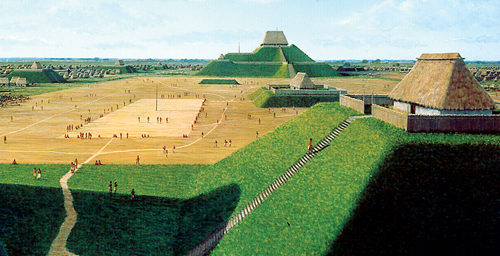
August 5, 2022
Researchers using paleoenvironmental analysis at the giant Mississippian site of Cahokia in Illinois, which exploded into prominence at 1050 CE and thrived for 300 years, was thought to have had four large plazas on the north, south, east and west which surrounded the very large temple known as Monk’s Mound, have found that the north plaza was almost always underwater. Cahokia was built on a flood plain beneath the confluence of the Missouri and Illinois Rivers.
The north plaza is built at the lowest elevation of the site. Two creeks ran through it and it flooded when the Mississippi swelled after heavy rains. The research team extracted sediment cores at the north plaza, took soil samples and analyzed carbon isotope in the soil and found that the area was wet all year. Water was important to Cahokia since they grew wetland plants and traded up and down the Mississippi. Their religious vision would probably have included water in their creation stories.
The chief researcher, Caitlin Rankin, from the Illinois State Archaeological Survey wrote the research paper on this find.
The National Geographic Society and National Science Foundation supported this work.
To reach Caitlin Rankin, email rankinc@illinois.edu
The paper “The exceptional environmental setting of the north plaza, Cahokia Mounds, Illinois, USA” is available online and from the U. of I. News Bureau.
DOI: 10.1080/00438243.2022.2077824
news.illinois.edu has the report here;
Mike Ruggeri’s Ancient Cahokia
https://mikeruggerisancientcahokla.tumblr.com
14,000 Year Old Skull of a Woman in China DNA Linked to Native Americans
August 4, 2022
The DNA from a 14,000 year old skull found in China has genetic ties to the east Asian ancestors of Native Americans. The individual has been named Mengzi Ren. The skull was founding Red Deer Cave in Yunnan in 1989. The skull belonged to a female Homo sapien. It took a long time for scientists to find DNA in the skull they could measure.
This is the first time an ancient East Asian genome was sequenced at the same time people were migrating into America confirming the East Asian ancestry of Native Americans.
(My note; this is the first time Clovis era folks are tied to East Asians at the time of Clovis entry. The ancestry of Pre-Clovis people entering the Americas is still a subject to research.)
The Chinese team did speculate that the folks related to Mengzi Ren traveled through the Japanese islands before entering the Americas which has been a theory for awhile, and now more provable.
The research is published in Current Biology, DOI: 10.1016/j.cub.2022.06.016
Newscientist has the report here.
https://www.newscientist.com/article/2328757-ancient-dna-adds-to-evidence-for-native-americans-east-asian-ancestry/
Mike Ruggeri’s Pre-Clovis World
http://preclovisworld.tumblr.com
(Scroll down to Journeys)
Maya Rulers at the Maya Site of Tonina in Chiapas Cremated Remains Used to Make Rubber Balls
August 3, 2022
INAH has uncovered a pre-Hispanic crypt at the site of Tonina. There were 400 vessels in niches containing human ashes, coral, rubber, roots. A series of small vaults and rooms connected by stairways to an antechamber led to the crypt. INAH researchers found that the sulfur in the ashes were used to vulcanize the rubber to make rubber balls for the ballgame.
Three rulers dating to 500-687 CE; Wak Chan Káhk´ (died on 8 Chikchan, September 1, 775 AD); Aj Kololte’, subordinate dignitary of the Po’p dynasty (died 12 akbal 11 sotz, April 1, 776 AD) and Lady Káwiil Kaan (died 722 AD) were taken to the cave of death after 260 days, completed a cycle of the ritual calendar –and on the same date of their deaths– for their transmutation explained INAH.
Toniná, was originally called Po’p, Po or Popo in Classic Maya texts. The city is located in the Chiapas highlands of southern Mexico, east of the town of Ocosingo.
The site contains groups of temple-pyramids set on terraces rising some 71 metres above a central plaza, two ballcourts, and over 100 carved monuments that mainly date from the 6th century through to the 9th centuries AD during the Classic period.
Heritage Daily has the report here from INAH;
Intact Maya Chocolate Vessel Found in a Playa del Carmen Cave
(Photo from Heritage Daily)
July 30, 2022
INAH has uncovered a Maya style chocolate vessel in a cave in Playa del Carmen called Cueva de la Cruz. The vessel is 16 cm high and 17 cm wide. It probably belongs to the period 300 BCE-250 CE. It is reddish on the outside and black on the inside. It has a style similar to a pumpkin. “It will allow researchers to find information on style, technique, origin. Pottery knowledge daily uses, ritual practices, myths and cultural evolution.”
Researchers will return to the cave in the dry season to look for other artifacts, and to detemine more about the chocolate trade in the area.
INAH has the report here in Spanish, and when you click on the green camera icon, you will see great photo slides of the discovery.
Large Sawfish Blade Uncovered By INAH at the Templo Mayor in Mexico City
July 28, 2022
INAH has uncovered a 39 inch sawfish blade in a stone box at the Templo Mayor. The box also contained 11,800 other ceremonial objects. This is the largest of the 78 sawfish blades found so far. The Aztecs revered the fish as a hybrid of sea and earth. Earlier in 2018, they found the carcass of a wolf dressed in gold armor. The wolf was given ear and nose ornaments and a pectoral of gold. It symbolized a human warrior with its head facing west as a companion of the sun in its journey to the underworld in the evening
Archaeology.org has the report here;
https://www.archaeology.org/issues/317-1811/trenches/7060-trenches-mexico-sawfish-blades
And the earlier wolf report here:
https://www.archaeology.org/issues/282-features/top10/6170-mexico-aztec-wolf-burial
Mike Ruggeri’s Aztec News
New Maya Genome Research in Belize
July 15, 2022
Researchers have found that half of the Maya genome is from populations arriving 5,600-4,700 years ago from Chibchan speaking peoples living between Costa Rica and northern Columbia.
The researchers analyzed DNA from two rick shelters in southern Belize. They re-introduced maize into Mexico in this area, and evidence shows that maize consumption jumped 4.700 years ago. The new migrants introduced new agricultural knowledge that led to intensive agriculture by the Maya.
According to a new study, more than half of the modern Maya genome is derived from ancient populations who migrated to the Yucatán Peninsula from southern Central America and South America at least 5,600 years ago. A team led by archaeologist Keith Prufer of the University of New Mexico, geneticist David Reich of Harvard University, and archaeologist Douglas Kennett of the University of California, Santa Barbara, analyzed DNA from human remains recovered from two rock shelters in southern Belize. They discovered that a group of the individuals whose remains were radiocarbon dated to between 5,600 and 4,000 years ago are ancestors of present-day Chibchan-speaking populations that live between Costa Rica and northern Colombia. “These people moved into the area in fairly small numbers over a period of perhaps five hundred to one thousand years and mixed with local populations,” Kennett says.
Archaeology.org has the report here;
https://www.archaeology.org/issues/474-2207/digs/10610-digs-belize-chichan-migration
New Research on the Ancient Yucatan Maya
July 15, 2022
An international team of researchers researching the ancient coastal Maya populations at Vista Alegre and Conil in the Yucatan. On the small island of Vista Alegre, they have uncovered pole and thatch buildings with a pyramid like structure 43 feet tall. The Conil site was encountered by the Spanish who said it had 5,000 houses. They are using cores from the sediments on the coast to determine how rising oceans interfered with drinking water at the sites. They theorize there were springs nearby that were drowned by rising seas. A drone with a thermal camera is looking for past freshwater areas.
They have uncovered thousands of pottery sherds, spindle whorls, and obsidian revealing an extensive trade network based on long distance canoe trade networks. Obsidian came from as far away as central Mexico. 20,000 animal bones of sharks, rays, turtles, gastropods. LIDAR surveys will begin soon looking for house mounds and pyramids.
The research is published here:
Rescuing ancient Maya history from the plow
More information: Jeffrey B. Glover et al, The Proyecto Costa Escondida: Historical ecology and the study of past coastal landscapes in the Maya area, The Journal of Island and Coastal Archaeology (2022). DOI: 10.1080/15564894.2022.2061652
Provided by Georgia State University
Phys.org has the report here:
https://phys.org/news/2022-07-secrets-ancient-coastal-maya.html
INAH Finds Proof of Red Painted Roofs at the Maya Site Palenque
July 15, 2022
INAH has been working on a Palenque preservation project in Chiapas for four years. They have restored four buildings within the Palenque main palace. They have uncovered a fragment of the original red paint on House D confirming the roofs of the palace were painted red. The red pigments for the paint were a mixture of minerals including iron oxide. The red paint was discover in the 1960’s and then covered one with cement to preserve it. And it was not recorded.
This area was for surveillance to control the palace entrance and to maintain the palace roof.
Newsinseconds.com has the report and photos here;
https://newsinseconds.com/a-red-palace-for-the-red-queen-at-palenque-mexico/
Research Team at the Maya Site of Yaxnohcah Discovers Advanced Maya Resource Use.
July 15, 2022
Researchers used genetic and pollen analyses at the Maya site of Yaxnohcah in the Yucatan (1000 BCE-200 CE) to date wild and cultivated plants there. A team from across North America
collected and analyzed 38 soil samples, finding evidence of wild trees and plants growing near the city.
The ancient Maya left much of the rainforest intact. But in other areas, researchers found evidence that the rainforest had given way to savanna dominated by pine trees that persisted for 1,000 years, perhaps from repeated slash-and-burn agriculture or from soil conducive to their growth.
Researchers also found a large diversity of plants the ancient Maya grew for food, fuel, medicine and construction, including maize, chili peppers, squash, manioc, and cotton. Along the city’s former stone-faced garden terraces, created to take advantage of rainfall, they discovered evidence of a wide variety of crops including avocados, hog plums, fruits called sapotes, matasanos and squash.
The study concluded that deforested parts of the rainforest quickly recovered, showing the resilience of the ecosystem over time.
UC geography professor Nicholas Dunning said, “The findings mirror those we found at Tikal and paint a picture of the ancient Maya as fairly conscientious forest managers. But we also found evidence of periods and places of environmental degradation in the form of accelerated soil erosion.”
Yaxnohcah was occupied for more than 2,000 years and no doubt faced intermittent natural disasters such as droughts or manmade ones like the depletion of resources that required resilience and creative solutions.
UC’s analysis also identified ancient paper and ink, which was used in a variety of Maya products, including clothing, adornments and ancient manuscripts known as a codex.
The Maya used dyed paper cloth in adornments as well as in headpieces. They also used special paper in ceremonies, for example, to absorb blood, then burned as an offering to various gods.
The research was published in the journal Frontiers in Ecology and Evolution.
uc.edu has the report here;
https://www.uc.edu/news/articles/2022/06/ancient-maya-used-sustainable-farming-forestry-for-millennia.html
Huge Hidden Chambers and Passageways Being Studied at the Chavín de Huántar Site in Peru
July 13, 2022
Archaeologists have found hidden passageways and galleries inside the Chavín de Huántar in Peru. These were probably used for religious rituals using psychedelic drugs. Sensory deprivation and religious chambers were in the larger galleries.
“These are stone-lined passageways, corridors, rooms, cells, and niches, big enough to walk through, roofed with stone beams.” Built in stages between 1200 BCE-200 BCE.
36 galleries and their associated passageways have now been found at Chavín de Huántar over 15 years of excavations. The latest network was detected only a few years ago and was not explored until this year. They were found in 2019. The complex was a center for the Chavin culture. The site is 10,000 feet high and the largest Chavin religious site.
Passageways led to a main gallery with two ritual stone bowls, one decorated as a condor. The two bowls were probably used to grind psychedelic drugs.
There was a tradition in Chavín to inhale hallucinogenic snuff made from seed pods of the vilca tree, which contain a powerful hallucinogenic substance that includes dimethyltryptamine, or DMT.
Major excavations wil begin soon.
Live Science has the report here:
https://www.livescience.com/secret-passages-ancient-temple-peruvian-andes
Remarkably Preserved Wooden Figure Found at the Site of Chan Chan in Peru
JULY 13, 2022
A perfectly preserved wooden figure has been uncovered at the Chimor culture Chan Chan site in Peru. Chan Chan is the largest mud brick city in the Americas dating to 850 CE-1470 CE.
At 1200 CE, 100,000 lived at the city.
The figure is 46 centimeters long and 16 centimeters high and represents a human figure with a trapezoid-shaped hat decorated with seven vertical stripes of alternating light and dark colors.
The nose protrudes from the plane of the face and the figure has almond-shaped eyes and circular ears with a black resin inside that would have served to affix mother-of-pearl plates.
The character appearing to be a porter who carried high priests, dignitaries, and sacred objects.
Its torso, arms, and hands appear to have been painted red, and dark circular spots can be seen on its chest.
In addition, the character wears a triangular skirt, the edge of which is decorated with small rectangular bands, similar to those of the hat. Its legs are straight and its feet are set apart, and the fronts of them have been partially cut or broken off.
The Ministry of Culture also said that nectandra seeds were also recovered that would have formed a necklace (some have thread inserted), and under the sculpture a small black bag with brown and white thread decoration was recorded.
The report is in ancient-archeology.com;
https://ancient-archeology.com/ornate-wooden-sculpture-unearthed-at-chan-chan-in-peru/
INAH Uncovers 2,500 Aztec Wooden Objects at the Templo Mayor in Mexico City
June 25, 2022
INAH has uncovered 2,500 wooden objects at the foot of the Templo Mayor in Mexico City. INAH says they have found masks, headdresses, sceptres, pectorals, darts, figurines, dart launchers, earrings, jars, and numerous wooden offerings that the priests deposited to consecrate the site to the Aztec gods. The finds were stabilised using synthetic sugars (lactitol and, later, trehalose) which prevents the breakdown of the wood by microorganisms and fluctuations in relative humidity.
The objects have survived due to the anaerobic conditions in the soil and the high level of humidity that has persevered them for more than 500 years. The researchers applied modern methods of conservation in which the finds were stabilised using synthetic sugars (lactitol and, later, trehalose) which prevents the breakdown of the wood by microorganisms and fluctuations in relative humidity.
The finds are then rinsed in water and placed inside a heat chamber with temperatures of 50°C. This slowly dries the wood and allows the controlled crystallisation of sugars that generates a thickening of the cell walls at a microscopic level.
Many of the objects have traces of colours such as blue, red, black, and white pigment on the surface.
Excavations of the ritual deposits have also uncovered botanical remains such as flowers, birds, mammals and marine animals, sea cucumbers, copper and gold objects, and flint and ceramic pieces.
Heritage Daily has the report here;
https://www.heritagedaily.com/2022/06/thousands-of-wooden-objects-and-offerings-recovered-from-the-aztec-templo-mayor/143896
INAH Archaeologists Discover a large sculpture of the Maya Maize God in Palenque, Chiapas
June 25, 2022
A 1,300 year old sculpture of the Maya Maize God has been uncovered at the Maya site of Palenque, in Chiapas. The discovery was made last July but just announced. The sculpture was placed over a pool a stuccoed floor and walls, honoring the entrance of the Maize God to the underworld. It was placed in an east-west position “which would symbolize the birth of the corn plant with the first rays of the sun,” INAH said. It is dated to 700-850 CE.
INAH said that vegetable matter, bones of various animals including turtles, quail and domestic dogs, shells, crab claws, ceramic pieces, miniature anthropomorphic figurines and pieces of obsidian blades and seeds among other items were also deposited in a closed-off compartment where the sculpture – which lay hidden for about 1,300 years.
“Some animal bones had been cooked and others have … teeth marks,” he said, explaining that indicated that meat was eaten by the inhabitants of Palenque as part of a ritual.
The maize god head was exposed to humidity and is currently undergoing a process of gradual drying, INAH said, adding that it will subsequently be restored by specialists.
Mexico News Daily has the report here:
https://mexiconewsdaily.com/news/maya-corn-god-statue-palenque-chiapas/
And here is a You Tube Video of there find;
https://www.youtube.com/watch?v=_GTb-x1dVEY
LIDAR at the Purepecha site of Tzintzuntzan in Michoacan Uncovers 1000 New Monuments
June 25, 2022
INAH used LIDAR technology at the Purepecha site of Tzintzuntzan in Mochoacan to find 1000 new monuments there. A few dozen monuments were known before. New pyramids, terraces, platforms and residential dwellings have been uncovered. More use of LIDAR will uncover even more. INAH said the new discoveries are just the tip of the iceberg.
Mexico News Daily has the report here.
https://mexiconewsdaily.com/news/lidar-reveals-size-ancient-city-michoacan/
New Important Structures Uncovered at the Maya Site of Xiol in the Yucatan
June 25, 2022
INAH has uncovered places, workshops, dwellings and a large public square at the Maya sire of Xiol in the Yucatan built between 600-900 CE. The architecture is in the Puuc style which is rare in the northern area where this site is located. 4,000 people lived here. And it is 15 miles from Merida. More discoveries are expected at this site,
Mexico News Daily has the report here:
https://mexiconewsdaily.com/news/ancient-mayan-city-yucatan-site-xiol/
3D Scans Reveal Largest Cave Art in North America
May 30, 2022
Researchers have found mud drawings in a limestone cave in Alabama mad by torchlight bearing artists 1000 years ago. This is not of the largest rock art creations in North America. 3D photogrammetry was used to reveal the art. 5,000 square feet of art has been revealed by researchers lying down inside the cave chamber to 3-D the art. The artists would have done the same. There are thousands of engravings. Now that this discovery has been made, there will probably be others found.
3D photogrammetry IS an emerging technology that creates three-dimensional models based on overlapping photographs. The researchers used a digital camera, LED lights, and a photo rig alternatively set up on the dry cave floor or in patches of knee-deep water. They found 16.000 images.
Then it required uploading and processing each 50-megapixel photo into a larger 3D model. (The sheer amount of data “melted our first computer,” Alvarez says.)
Many of the figures are life sized. A rattlesnake drawing was 11 feet long, the largest piece of cave art ever found.
The drawing naked to the human eye date to 100 CE-1100 CE. This find shows that rock art in the Southwest was as large as rock art in the Southwest.
Researchers will be racing to find more such cave art work using this new technique. Just touching the art work can erase it.
National Geographic has the story here with many breathtaking photos;
13,000-Year-Old Red Ocher Quarry Found in Wyoming
May 30, 2022
Researchers have found a red ochre (hematite) quarry in the Rocky Mountains, Wyoming. The mining is dated tt 12,480-12,505 years ago at the Powars II site. This mine is now the oldest hematite mine found in the Americas. Clovis points have been found there with other projects, tools and shell beads, animal bones and antlers. The site was mined for 1000 years. Some of the projected points came from as far away as Texas. The mined hematite found its way across North America. Further excavations are planned.
The research was published in the Proceedings of the National Academy of Sciences.
Spencer R. Pelton et al. 2022. In situ evidence for Paleoindian hematite quarrying at the Powars II site (48PL330), Wyoming. PNAS 119 (20): e2201005119; doi: 10.1073/pnas.2201005119
Sci-news has the report here:
http://www.sci-news.com/archaeology/powars-ii-red-ocher-quarry-10825.html

May 22, 2022
Research into Mesoamerican Dental Inlays
Mesoamericans inlaid teeth with jade, turquoise and pyrite by drilling holes in the teeth, and then applied a sealant to cement the stones in place. More than half of the stones found in these skulls are still intact. How the bond was formed was a mystery. Researchers in Mexico have studied eight teeth found in Maya burial sites. They have found 150 organic molecules that are in plant resins. There are pine tree resins found which can also prevent tooth decay. Salvia plant resins that have anti-fungal and anti-bacterial properties have also been found, and mint plants that have anti-inflammatory effect
Co-author of the study, Vera Tiesler, a bioarchaeologist at the Autonomous University of Yucatán, points to Janaab’ Pakal, the Maya king of Palenque, who died in 612 C.E. at the age of 80 with nearly all his teeth and no signs of decay in those that remained—a tribute to the remarkable dental skills of his people.
The research is published in the Journal of Archaeological Science: Reportsnone
Science.org has the report here:
https://www.science.org/content/article/ancient-maya-tooth-sealant-glued-gemstones-place-and-may-have-prevented-tooth-decay
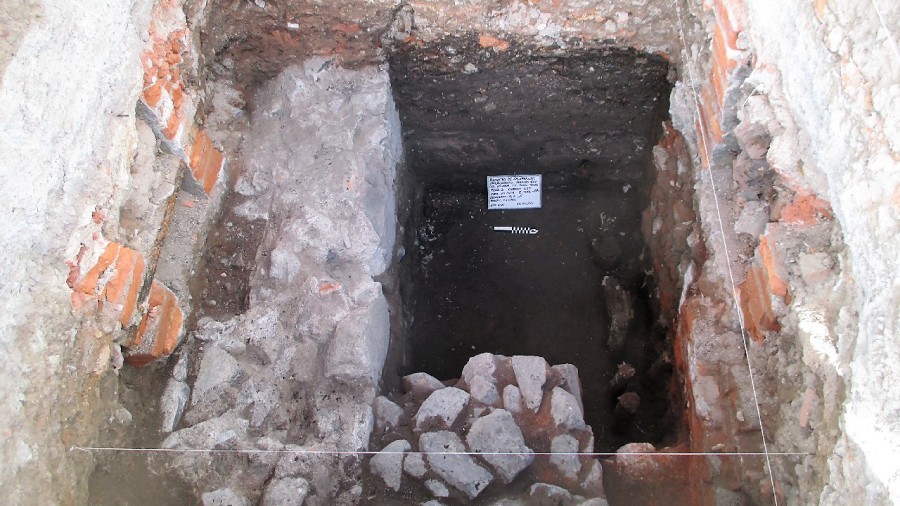
May 21, 2022
Aztec Chinampas Dwelling Uncovered in Mexico City
An Aztec dwelling has been uncovered during construction in Mexico City. It dates to 1200-1520 CE. It spans 4,300 square feet. It was part of a residential and agricultural center with channels and a jetty used for chinampas farming in floating gardens. Funerary vessels were found containing the remains of infants, burials with an offering of censers, whorls and spinning tools. A stone statute of a man wearing a loincloth which is 23.5 inches tall.
Live Science has the report here:
https://www.livescience.com/aztec-house-discovered-mexico
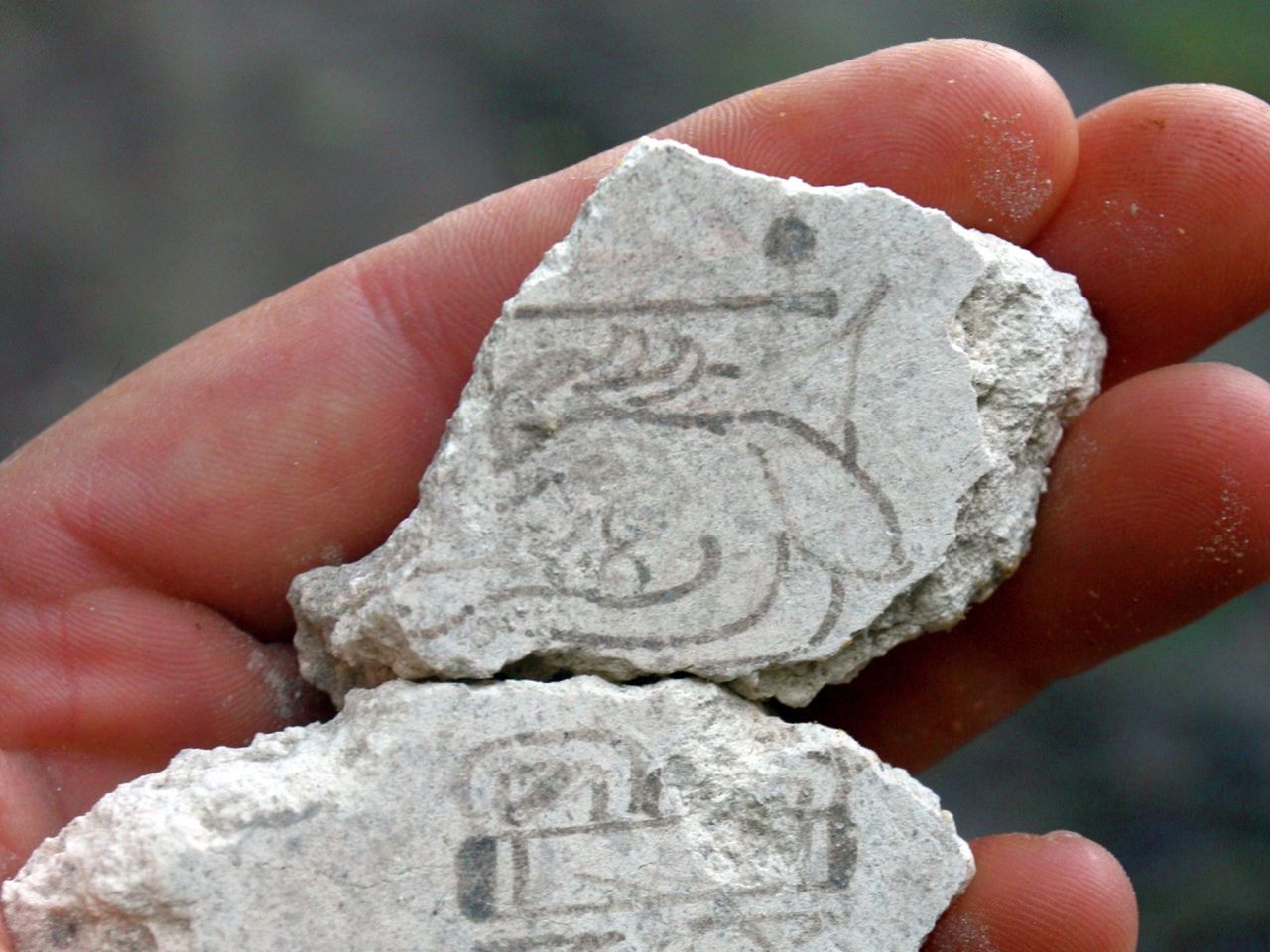
May 21, 2022
The Oldest Evidence of the Maya Calendar found at the site of San Bartolo in Guatemala.
The oldest evidence of the Maya calendar has been uncovered in Guatemala dating to 300-200 BCE at the site of San Bartolo, in the jungles north of Tikal. Two mural fragments with the 7 Deer day sign were among the 249 fragments of painted plaster and masonry blocks excavated at the site. This shows the Maya calendar was in use for at least 2,300 years.
The fragments were radio carbon dated as the team found 7,000 mural fragments. The 7 Deer fragments were part of 11 wall fragments that were analyzed by the team. There may be older calendar artifacts but they are in stone carvings which cannot be dated.
Live Science has the report here:
https://www.livescience.com/earliest-evidence-maya-calendar
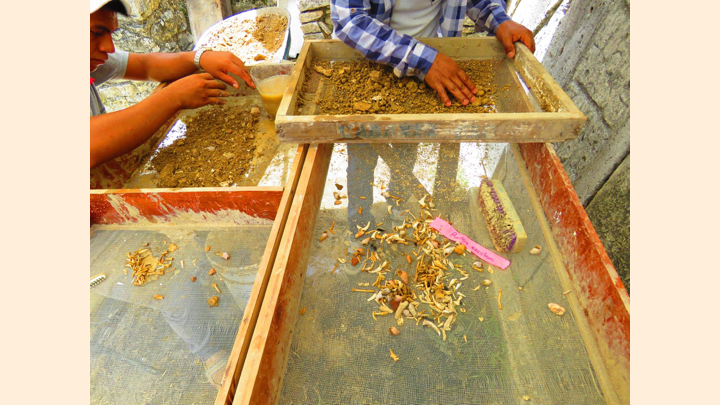
May 22, 2022
INAH Uncovers the Remains of a Huge Number of Animals Consumed at a Feat at the Maya site of Palenque in Chiapas
INAH has uncovered hundreds of animal remains, seeds, over a kilo of coal, shell beads, and green stone at a palace at the site of Palenque in Chiapas. They used water floatation and a fine sieve. Most of the remains are of fish, mollusks, crustaceans, and a small amount of birds, reptiles, mammals. Land snail, apple snail, freshwater crab, mojarras, tenguayaca, white bass, quail, white turtle, nine-banded armadillo, domestic dog, cervid and white-tailed deer have been identified.
These remains are part of a banquet and the remains deposited in cavities that were burned and covered. This banquet would have taken place between 200-900 CE. The finds help us to understand the Maya diet at the time.
Infobae has the report here with photos:
https://www.infobae.com/en/2022/04/13/discovery-in-palenque-inah-found-remains-that-offer-details-of-mayan-rituals/?fbclid=IwAR2DimPwJd5w_aNLKT7X8uC1pJIcDKoNFFsfFrCIf5y0iHrTj-Ap8vXeZCA
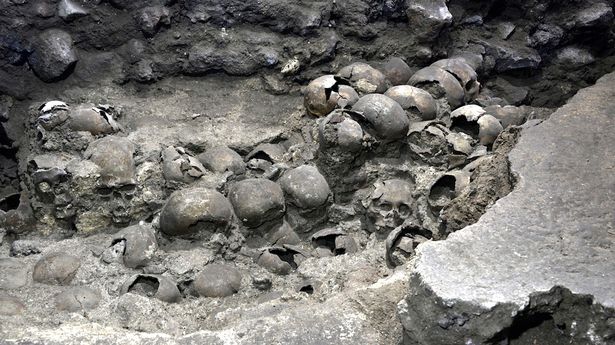
May 21, 2022
INAH Confirms 150 Human Skulls Found in a Chiapas Cave Was a Result of an Ancient Ritual
A pile of 150 human skulls found in a cave in Chiapas, Mexico 10 years ago. Police feared this was a cartel massacre of Guatemala migrants. INAH Archaeologists have now found that the skulls date to 900-1200 CE. The victims were beheaded and were most females, and all were missing teeth. The find was probably a tzompantli or trophy rack with skulls placed along wooden panels. The wooden sticks have also been found. This is not the first cave in Chiapas where similar skull finds have been made.
The New York Times has the report here with a photo:
https://www.nytimes.com/2022/05/05/world/americas/mexico-skulls-cave.html
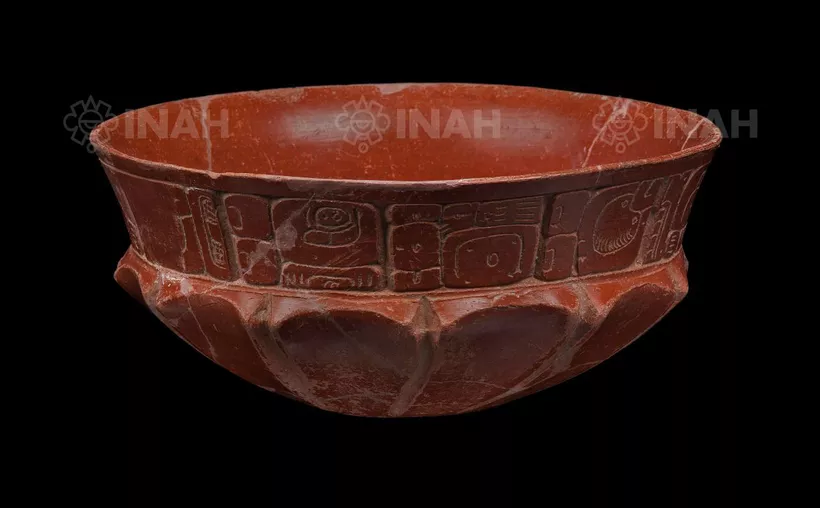
May 21, 2022
INAH Uncovers a Complete Maya Pottery Piece During Train Line Construction
INAH has uncovered a Maya a complete pottery piece while constructing a train line in the region dating to 600-800 CE. It has a glyph band identifying the Maya lord Cholom. It is related to the site of Oxkintok in the Yucatan. 80,000 fragments and 42 complete pieces have been recovered while the train line is being constructed.
The Yucatan Times has the report here with a photo:
https://www.theyucatantimes.com/2022/04/ancient-vessel-found-on-construction-site-of-the-maya-train-section-3-near-oxkintok/


